 |
PO
Box 9021, Wilmington, DE 19809, USA
E-mail: font@focusonnature.com
Phone: Toll-free in USA 1-888-721-3555
or 302/529-1876 |
Part
4 of a List
with some Photos
of 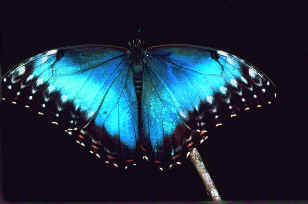
Central America
Butterflies
and
Moths
Brushfoots
Noting those
during
Focus On
Nature Tours
in Belize,
Costa Rica,
Guatemala,
Honduras,
Panama
with tours in the months of: January, February, March, April, July, December
Fourth Part of a List of Central American Butterflies in 5 Parts,
compiled by Armas Hill
Here. in Part #4: Nymphalidae, the Brushfoots
including the Clearwings and the
Satyrs
In this part of
this list there are are photographs of: Two-spotted Prepona, Turquoise Emperor,
Small
Beauty, Orion Cecropian, Red Rim, Gray Cracker, Red Cracker, Florida Purplewing,
Ruddy Daggerwing, Stoplight Catone, Pointed Sister, Malachite, Rusty-tipped
Page, White Peacock,
Banded Peacock, Buckeye, Painted Lady, American Lady,
Bordered Patch, Crimson Patch, Rosita Patch,
Phaon Crescent, Texan Crescent,
Gulf Fritillary, Julia Heliconian, Heart-spotted Heliconian,
Crimson-patched Longwing,
Zebra Longwing, Variegated Fritillary, Mexican Fritillary, Monarch, Queen,
Thick-tipped Greta, Common (or Helenor) Morpho, Yellow-fronted Owl Butterfly, Yellow-edged
Giant-Owl
Among the
Butterfly groupings that follow, links to:
Subfamily
CHARAXINAE, Tribe
PREPONINI with
the genera: Agrias, Archaeoprepona, Prepona
Leaf Butterflies:
Subfamily CHARAXINAE, Tribe ANAEINI
with the genera: Anaea, Consul, Fountainea, Hypna, Memphis, Siderone, Zaretis
Emperors:
Subfamily APATURINAE
with the genera: Asterocampa, Doxocopa
Snout:
Subfamily LIBYTHEINAE with
the genus: Libytheana
Subfamily
NYMPHALINAE, Tribe NYMPHALINI
with
the genera: Colobura, Hypanartia, Nymphalis, Pycina, Smyrna, Tigridia, Vanessa
Subfamily
NYMPHALINAE, Tribe COEINI with
the genera: Baeotus, Historis
Subfamily
BIBLIDINAE, Tribe BIBLIDINI with
the genera: Biblis, Mestra
Crackers
& allies: Subfamily BIBLIDINAE, Tribe AGERONIINI
with the genera: Ectima, Hamadryas, Panaca
Purplewings &
allies: Subfamily BIBLIDINAE, Tribe EPICALLINI
with
the genera Catonephele, Eunica, Myscella, Nessaea
Daggerwings:
Subfamily CYRESTINAE with
the genus: Marpesia
Sailors: Subfamily
BIBLIDINAE, Tribe EUBAGINI with
the genus: Dynamine
Banners & allies: Subfamily
BIBLIDINAE, Tribe EPIPHILINI
with the genera: Asterope, Bolboneura, Epiphile, Nica, Pyrrhogyra, Temenis
"Eighty-Eight"
Butterflies: Subfamily BIBLIDINAE. Tribe CALLICORINI
with the genera: Callicore, Diathria, Haematera, Mesotaenia
Sisters: Subfamily LIMENITIDIANE, Tribe LIMENITIDINI
with the genus: Adelpha
Peacocks,
Page, Malachite: Subfamily NYMPHALINAE,
Tribe VICTORININI with
the genera: Anartia, Siproeta
Buckeyes,
Mimic: Subfamily NYMPHALINAE, Tribe JUNONIINI
with the genera: Junonia,
Hypolimnas
Patches,
Checkerspots, Crescents: Subfamily NYMPHALINAE, Tribe MELITAEINI
with the genera:
Anthanassa, Castilia, Chlosyne, Eresia, Janatella, Microtia, Phyciodes, Tegosa
Longwings:
Subfamily HELICONIINAE, Tribe HELCONIINI
with the genera:
Agraulis, Dione, Dryadula, Dryas, Eueides, Heliconius, Laparus, Philaethria
Fritillaries:
Subfamily HELICONIINAE, Tribe ARGYNNINI with
the genus: Euptoita
Subfamily
HELICONIINAE, Tribe ACRAEINI with
the genera: Actinote, Alinote
Milkweed
Butterflies: Subfamily DANAINAE, Tribe DANAINI with
the genera: Anetia, Danaus, Lycorea
Clearwing
Butterflies: Subfamily ITHOMIINAE
with the genera:
Aeria, Callithomia, Ceratinia, Dircenna, Episcada, Eutresis, Godyris, Greta,
Heterosais, Hyalenna, Hyaliris, Hypoleria, Hyposcada, Hypothyris, Ithomia,
Mechanitis, Melinaea, Methona, Napeogenes, Oleria, Olyras, Pseudoscada,
Pteronymia, Scada, Thyridia, Tithorea
Morphos:
Subfamily SATYRINAE, Tribe MORPHINI
with
the genera: Antirrhea, Caerois, Morpho
Owl
Butterflies: Subfamily SATYRINAE, Tribe BRASSOLINI
with the genera: Brassolis, Caligo, Catoblepia, Dynastor, Eryphanis, Mielkella,
Narope, Opoptea, Opsiphanes, Selenophanes
Satyrs:
Subfamily SATYRINAE, Tribes HAETERINI, MELANITINI, SATYRINI
with the genera:
Amphidecta. Arhuaco, Cepheuptychia, Chloreuptychia, Cissia, Cithaerias,
Cyllopsis, Drucina, Dulcedo, Eretris, Euptychia, Forsterinaria, Harjesia,
Haetera, Hermeuptychia, Lymanopoda, Magneuptychia, Manataria, Megeuptychia,
Oressinoma, Oxeosachistus, Parataygetis, Pareuptychia, Pedaliodes, Pierella,
Pindus, Posttaygetis, Pronophila, Praepronophila, Pseudodebis, Pseudomaniola,
Satyrotaygetis, Splendeuptychia, Taygetina, Taygetis, Yaygetomorpha,
Yphthimoides
Links to
other Central America Lepidoptera groupings:
Part
#1 - Swallowtails (Papilionidae) Part
#2 - Whites, Yellows, Sulphurs, Marbles (Pieridae)
Part
#3 - Hairstreaks, Blues (Lycaenidae) & Metalmarks (Riodinidae)
Part
#5 -
Skippers (Hesperiidae) Moths

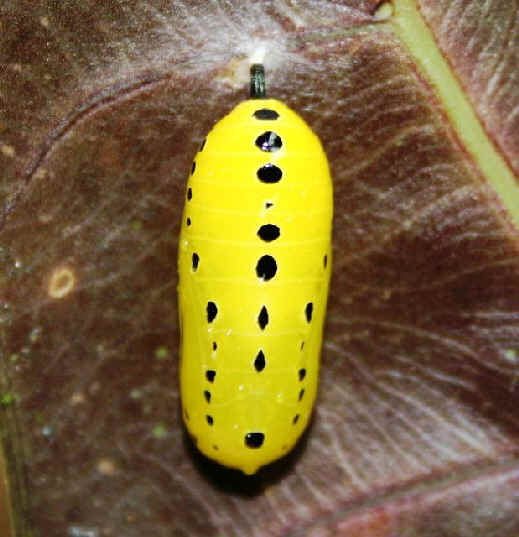
A beautiful pupae in Central
America,
not identified,
but possibly of an ITHOMIINAE butterfly
Codes relating to illustrations
in various books:
Numbers noted as (AZ:xx) refer to pages in "Butterflies of Arizona - A
Photographic Guide", by Bob Stewart, Priscilla Brodkin, & Hank Brodkin
Numbers noted as (BMCR:xx) refer to plates
in "Butterflies and Moths of Costa Rica" by Isidro Chacon
& Jose Montero
Numbers noted as (C:xx) refer to pages
in "A World of Butterflies", with text by
Brian Cassie, and photographs (superb) by Kjell Sandved
Numbers noted as (D1:xx) refer
to plates in "The Butterflies of Costa Rica and their Natural History (Volume 1):
Papilionidae, Pieridae, Nymphalidae", by Philip J. DeVries
Numbers noted as (F:xx) refer to pages in "The Illustrated Encyclopedia of
Butterflies", by Dr. John Feltwell
Numbers noted as (ICR:xx) refer to pages
with a photograph in "Butterflies, Moths, and Other Invertebrates of
Costa Rica, a Field Guide" by Carrol Henderson, 2010 (ICR
= Invertebrates Costa Rica)
Numbers noted as (K:xx) refer to pages in
the "Kaufman Focus Guide to Butterflies of North America", by Jim Brock & Kenn
Kaufman
Numbers noted as (MCA:xxx) refer to pages in
"A Swift Guide to the Butterflies of Mexico and Central America", by
Jeffrey Glassberg
Numbers noted as (PE:xx) refer
to plates in the "Peterson Field Guide to Eastern Butterflies", by Paul Opler
& Vichai Malikul, 1998 edition.
Those noted as (PEp:xx) refer to a page with a
photograph.
Numbers noted as (PW:xx) refer to plates in the
"Peterson Field Guide to Western Butterflies", by Paul Opler & illustrated by
Amy Bartlett Wright, 1999 edition.
Those noted as (PWp:xx) refer to a page with a photograph.
Numbers noted as (S:xx) refer to pages in
the "Smithsonian Handbook, Butterflies &
Moths", by
David Carter
Numbers noted as (100BM:xx) refer to
numbered plates in the book "100 Butterflies and Moths, Portraits from
the Tropical Forest of Costa Rica", by Jeffrey Miller, Daniel Janzen,
Winifred Hallwachs, 2007
Numbers noted as (100C:xx) refer to numbered
plates in the book "100 Caterpillars, Portraits from the Tropical Forest
of Costa Rica", by Jeffrey Miller, Daniel Janzen, Winifred Hallwachs, 2007
For both of these books, codes followed by -c:
indicates that there is in
the book a photograph of the caterpillar.
Actually for all of the species in both books, there are photographs of
caterpillars and the adult butterflies and moths.
To view the caterpillar and adult butterfly and moth photos online go to:
http://janzen.sas.upenn.edu/caterpillars/database.lasso
Additional Codes:
BZ: in Belize
CR: in Costa Rica
GU: in Guatemala
HN: in Honduras pb:
at Pico Bonito Lodge in the Caribbean lowlands
PN: in Panama sl:
at Sierra Llorona, in hills on the Caribbean side of Panama
BUTTERFLIES OBSERVED DURING FONT TOURS NOTED BY AN (*) AFTER THE 2-LETTER
COUNTRY CODE.
(ph): species with a photo in the FONT website
Other Links:
Itineraries
for upcoming FONT Birding & Nature Tours in:
Belize, Costa Rica, Guatemala, Honduras, Mexico, & Panama
Lists
of Birds in: Belize
Costa Rica Guatemala
Honduras
Panama
A List & Photo Gallery of Birds
in Central America, in 4 Parts
A List of Mammals in
Central America (with some photos)
Other Lists & Photo Galleries of Butterflies & Moths Elsewhere
Alphabetical Directory of Butterflies by Genus
with Photos in the FONT
Website
A Directory of Photos in this
Website

List of Central American Butterflies, Part #4:
Family NYMPHALIDAE:
BRUSHFOOTS
Cosmopolitan, with subfamilies ranging from 8 to 25, depending upon taxonomic
treatment.
This is the most diverse family of butterflies, with approximately 6,000 known
species worldwide.
Brushfoot butterflies appear 4 rather than 6-legged as their
2 front legs are much reduced.
Subfamily CHARAXINAE, Tribe
PREPONINI
Genus AGRIAS
- Agrias aedon ______ CR GU
Agrias aedon rodriguezi ______ CR GU
(D1:13) (MCA:118)
subspecies from Mexico to Costa Rica
GREAT AGRIAS
(Range: Mexico to Amazon Basin)
Agrias amydon ______ CR GU PN
(F:115) (100BM:76-c)
Agrias amydon philatelica ______ CR PN (BMCR:149)
(D1:13) (MCA:118)
subspecies from Nicaragua to
Panama
Agrias amydon lacandona ______ subspecies from
southeast Mexico to Honduras, subspecies described in
1999)
Agrias amydon oaxcata ______ GU subspecies in Mexico
and Guatemala
Agrias amydon smalli ______ PN (BMCR:149)
subspecies in Panama
WHITE-SPOTTED AGRIAS
(Range: Mexico to Amazon Basin)
Agrias amydon is a powerful flier. It has a number of subspecies
and is quite variable. It lives in the rainforest and visits fruit for
sugar.
Genus PREPONA: South & Central American butterflies of which the total
number of species is unclear since there are many confusing forms. They have
bright blue-green bands on the upperside and, often, large false eyes on the
underside. These are butterflies of the rainforest canopy and infrequently
come down to ground level. Caterpillars feed on members of the Leguminosae.
Prepona laertes (formerly
omphale) ______
CR PN
(100BM:80-c)
Prepona laertes octavia ______ CR
PN(sl) (D1:13)
subspecies in Central America
YELLOW-TUFTED PREPONA
(Range: Mexico to Amazon Basin)
Prepona dexamenus ______ GU
PN
Prepona dexamenus medinai ______ GU
(MCA:119) subspecies from Mexico to Honduras, subspecies described in
1981
Prepona dexamenus desxamenus ______ PN
(D1:13)
subspecies from
Panama to the Amazon Basin
LEAST PREPONA
(Range: Mexico to Amazon Basin)
Prepona deiphile ______ CR GU PN
Prepona deiphile diaziana ______ GU
(MCA:119)
subspecies in Mexico and Guatemala, subspecies described in 1976
Prepona deiphile salvadora ______ subspecies in El Salvador, described in
1992
Prepona deiphile lygia ______ CR PN (D1:13)
subspecies in
Costa Rica and Panama
ORANGE-SPOTTED PREPONA
Prepona pylene ______ CR GU PN
Prepona pylene philetas ______ GU
(MCA:119) subspecies fro Mexico to Honduras
Prepona pylene gnorima ______ CR PN
(D1:13)
subspecies from
Honduras to Colombia
MOTTLED PREPONA
Genus ARCHAEOPREPONA
Archaeoprepona phaedra ______ CR GU PN
Archaeoprepona phaedra aelia ______ GU
(MCA:118)
subspecies from Mexico to Nicaragua
Archaeoprepona phaedra phaedra ______ CR PN
(D1:13) subspecies in Costa Rica and Panama
FALCATE PREPONA
(Range: Mexico to Panama)
Archaeoprepona demophon ______ CR GU PN
(C:347) (100BM:79-c)
Archaeoprepona demophon centralis ______ CR GU PN
(BMCR:149) (D1:14) (MCA:118)
subspecies
from Mexico to Panama
ONE-SPOTTED PREPONA
(Range: Mexico to Amazon Basin)
Archaeoprepona demophoon (ph)
______ CR GU PN (100C:69-c)
Archaeoprepona demophoon gulina ______ CR GU PN(*)
(BMCR:149) (D1:14) (MCA:118)
subspecies
from Mexico to the Amazon Basin
TWO-SPOTTED PREPONA (another
name has been Silver King Shoemaker)
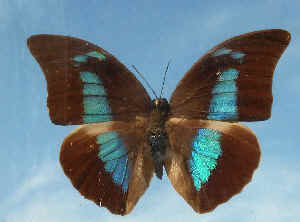
Two-spotted Prepona
Archaeoprepona camilla ______ CR
PN
Archaeoprepona camilla camilla ______ CR
PN(sl) (BMCR:149) (D1:14) (MCA:119)
subspecies
from Nicaragua to Panama
PALE PREPONA (or
Straw Prepona)
(Range: Nicaragua to Colombia)
Archaeoprepona meander
______ GU PN (S:119)
(100C:36-c)
Archaeoprepona meander phoebus ______ GU (MCA:118)
subspecies from Mexico to Honduras
Archaeoprepona meander megabates ______ PN
(D1:14)
subspecies
from Panama to Bolivia
THREE-TONED PREPONA (another name has been Banded King Shoemaker)
(Range: Mexico to the Amazon Basin)
In flight, the Three-toned Prepona, or the Banded Wing Shoemaker,
makes a crackling sound.
Archaeoprepona amphimachus ______
CR GU PN
Archaeoprepona amphimachus amphiktion
______ CR GU PN (BMCR:149)
(D1:14) (MCA:118) subspecies from Mexico to Colombia
WHITE-SPOTTED PREPONA
LEAF
BUTTERFLIES: Subfamily CHARAXINAE, Tribe
ANAEINI
Genus SIDERONE: These butterflies have red flashes on their elliptical
forewings and leaf-like undersides.
Siderone syntyche ______ CR
GU PN
Siderone syntyche syntyche ______ CR
GU PN (D1:13)
(MCA:123) subspecies in Mexico
and Central America
RED-PATCHED LEAFWING
Siderone galanthis
(or marthesia) (ph) ______ CR
PN
Siderone galanthis galanthis ______ CR
PN (D1:13
as S. marthesia) (MCA:123) (100BM:8-c)
subspecies in Central America and south to the Amazon Basin
RED-STRIPED LEAFWING
(or Red-and-black Leafwing)
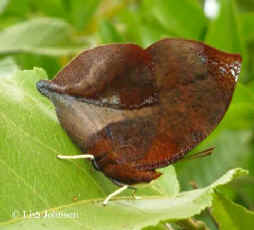
Red-striped Leafwing
(copyrighted photo by Lisa Johnson)
Genus ZARETIS
Zaretis callidryas ______ CR
GU PN (D1:14) (MCA:122)
PALE LEAFWING (or
Ghost Leafwing)
(Range: Mexico to Panama)
Zaretis ellops ______
CR
GU PN (D1:14)
(MCA:122) (100BM:69-c)
SEASONAL LEAFWING (or
Holey Leafwing)
(Range: Mexico to Colombia)
In literature, it has been said that in Costa Rica Zaretis
ellops occupies dry forest, while
Zaretis itys occupies rain forest.
Zaretis itys ______ CR
GU PN (100BM:70-c)
Zaretis itys itys ______ CR GU
PN (D1:14)
(MCA:122) subspecies from Mexico to Bolivia and the Amazon
Basin
ITYS LEAFWING (or
Skeletonized Leafwing)
(Range: southern Mexico to Brazil)
Zaretis isidora (ph) ______
CR GU PN
(MCA:122)
ISIDORA LEAFWING (or
Cramer's
Leafwing)
(Range: Mexico to Argentina)
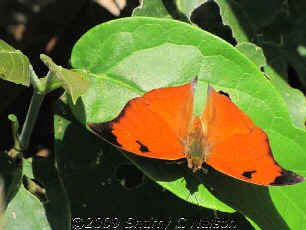
Above & below: the Isidora Leafwing,
showing upperwings & underwings
(photos by Sherry Nelson)
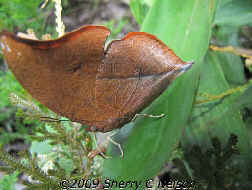
Genus HYPNA: A single species that has swallowtail-shaped wings and a
tail.
Hypna clytemnestra ______ CR
GU PN
(F:163)
Hypna clytemnestra mexicana ______ GU
(MCA:123) subspecies in Mexico and
Guatemala
Hypna clytemnestra negra ______ CR
PN (D1:15) subspecies from Nicaragua to
Brazil
SILVER-STUDDED LEAFWING (or
Jazzy Leafwing)
(Range: Mexico to Amazon Basin)
Genus CONSUL
Consul fabius ______ CR
GU PN (100BM:42-c)
Consul fabius cecrops ______ CR GU PN
(D1:15)
(MCA:123)
subspecies from Mexico to
Bolivia
TIGER-STRIPED LEAFWING
Consul panariste ______ CR
GU PN
Consul panariste jansoni ______ CR GU
PN(sl) (D1:15)
(MCA:123) subspecies from Guatemala to
Panama
BLACKENED LEAFWING (or
Tricolored Leafwing)
(Range: Guatemala to Colombia)
Consul electra ______ CR
GU PN
Consul electra electra ______ CR
GU PN (D1:15)
(MCA:123) subspecies from Mexico to
Panama
PEARLY LEAFWING
Consul excellens ______ GU
Consul excellens excellens ______ GU
(MCA:123) subspecies in Mexico and Guatemala
Consul excellens genini ______ GU
a 2nd subspecies in Mexico and Guatemala
BLACK-VEINED LEAFWING
(Range: Mexico and Guatemala)
Genera ANAEA and FOUNTAINEA:
These Central & South American butterflies are called
LEAFWINGS since the undersides of the wings are leaf-like and help to disguise
the butterfly when it settles on the ground. Some species are dimorphic.
These
butterflies are similar in behavior to the African genus CHARAXES.
Anaea aidea ______ CR GU
(AZ:207) (C:271)
(D1:16)
(K:221) (MCA:121) (PE:25) (100BM:26-c)
TROPICAL LEAFWING
(Range: Mexico to
northwest Costa Rica)
Fountainea (has
been Anaea)
nobilis (ph) ______ CR GU
PN
Fountainea nobilis nobilis
______ GU subspecies in Mexico
and Guatemala
Fountainea
nobilis peralta ______ CR PN
(D1:15)
subspecies in Costa Rica and Panama
NOBLE LEAFWING
(Range: Mexico to Peru)

Noble Leafwing
(photo by Sherry Nelson)
Fountainea (has
been
Anaea and Memphis) glycerium
______ CR GU PN (PE:25)
Fountainea glycerium glycerium ______ CR
GU PN (BMCR:150)
(D1:16) (MCA:121) subspecies from Mexico to Panama
ANGLED LEAFWING
(Range: Mexico to northern South America)
Fountainea
(has been Anaea
and Memphis) ryphea (ph) ______ CR
GU PN
Fountainea ryphea ryphea ______ CR
GU PN(sl)
(D1:15) (MCA:120) subspecies from Mexico to Peru
RYPHEA LEAFWING (or Blue-barred
Leafwing)
(Range: Mexico to the Amazon basin)
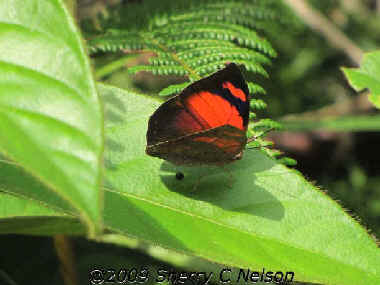
Ryphea Leafwing
(photo by Sherry Nelson)
Fountainea (has been Anaea and
Memphis) eurypyle ______ CR GU PN
Fountainea eurypyle confusa ______
CR GU PN(sl) (BMCR:150) (D1:15)
(MCA:120) (100BM:7-c) subspecies from Mexico to Panama
POINTED LEAFWING
(Range: Mexico to Bolivia)
Fountainea (has been Anaea
and Memphis) halice ______
CR PN
Fountainea halice chrysophana ______
CR PN(sl)
(BMCR:150) (D1:15) (MCA:120)
subspecies in Costa Rica and Panama
THORN-SCRUB LEAFWING
(or Pear-winged Leafwing)
(Range: Mexico to Panama)
Genus or Subgenus MEMPHIS: BLUE LEAFWINGS
About 100 species, which occur in Central
America. They resemble the genus ANAEA, to which they are closely related.
In fact, by some, they are onsidered to be within ANAEA.
These butterflies have crytic undersides that are leaf-like. They reside in the forest, and
are powerful fliers.
Memphis (or
Anaea) ambrosia ______ CR
PN
Memphis ambrosia ambrosia ______ CR PN
(BMCR:150) (D1:16) subspecies in Costa Rica
and Panama
AMBROSIA LEAFWING
Memphis (or
Anaea) aureola ______ CR
PN(sl) (BMCR:151) (D1:16)
(F:181) (MCA:128)
AUREOLE LEAFWING
(Range: Mexico to Colombia)
Memphis (or
Anaea) herbacea ______
CR GU (D1:16) (MCA:125)
HERBACEA LEAFWING (or
Scarce Leafwing)
(Range: Mexico to Costa
Rica)
Memphis (or
Anaea) beatrix ______ CR PN
(BMCR:151) (D1:16)
BEATRIX LEAFWING
(Range: Costa Rica and Panama)
Memphis (or
Anaea) proserpina ______ CR
GU (BMCR:153) (D1:17) (D1:18) (F:182) (MCA:124)(100BM:40-c)
PROSERPINA LEAFWING (or Great Leafwing)
(Range: Mexico to Costa
Rica)
Memphis (or Anaea) elara
______ CR PN
ELARA LEAFWING
(Range: Costa Rica and western Panama)
Memphis (or Anaea) kingi ______
PN
(species described in 1971)
KING'S LEAFWING
(Range: Panama)
Memphis (or
Anaea) philumena
(formerly
chaeronea) ______ CR
GU PN
Memphis philumena xenica ______ GU
(MCA:124) subspecies in eastern Mexico and Guatemala
Memphis philumena indigotica ______ CR PN(sl)
(BMCR:151,152)
(D1:17) subspecies in Costa Rica and Panama
ORANGE-STRIPED LEAFWING
(Range: Mexico to Colombia)
Memphis (or
Anaea) glauce ______ CR
PN
Memphis glauce centralis ______ CR PN(sl)
(D1:17) subspecies
from Honduras to Panama
GLAUCE LEAFWING
Memphis (or
Anaea) xenocles ______ CR
GU PN
Memphis xenocles carolina ______ CR
GU PN(sl) (D1:17) (MCA:127)
subspecies from Mexico to Panama, described in 1961
CAROLINA LEAFWING (or
Corner-spotted Leafwing)
(Range: Mexico to Brazil)
Memphis (or
Anaea) niedhoeferi ______ CR
GU (D1:17) (MCA:126) (species described in 1965)
WAVY-EDGED LEAFWING
(Range: Mexico to Costa
Rica)
Memphis (or
Anaea) arginussa ______ CR
GU PN
Memphis arginussa eubaena ______ CR
GU PN (BMCR:150) (D1:17) (MCA:125)
subspecies from Mexico to Panama
MOTTLED LEAFWING
(Range: Mexico to Amazon Basin)
Memphis (or
Anaea) moruus (ph) ______ CR
GU PN
Memphis moruus boisduvali ______ CR GU
PN (BMCR:152) (D1:18) (MCA:126)
subspecies
from Mexico to Panama, described in 1961
BOISDUVAL'S LEAFWING (or
Laurel Leafwing)
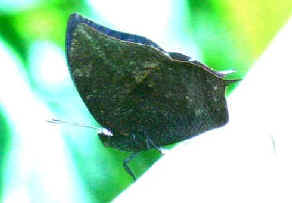
The Boisduval's, or Laurel Leafwing
(photo by Sherry Nelson)
Memphis (or
Anaea) lyceus ______
CR PN (BMCR:152) (D1:18)
LYCEUS LEAFWING
(Range: Costa Rica to Bolivia)
Memphis (or
Anaea) laura ______
CR PN
Memphis laura balboa ______ CR PN
(D1:18) subspecies in Costa Rica
and Panama
LAURA LEAFWING
(Range: Costa Rica to Colombia)
Memphis (or
Anaea) oenomais ______ CR
GU PN(sl) (BMCR:152,153) (D1:18) (MCA:126)
EDGE LEAFWING
(Range: eastern Mexico thru Central
America)
Memphis (or
Anaea) artacaena ______ CR
GU PN(sl)
(BMCR:151) (D1:18) (MCA:126)
WHITE-PATCHED LEAFWING
(Range: southeast Mexico to Colombia)
Memphis (or
Anaea)
dia ______ CR GU PN
(MCA:128)
Memphis dia dia ______ CR GU PN
subspecies from Mexico to Panama
DIA LEAFWING (or
Shining Leafwing)
Memphis (or
Anaea) mora ______ CR
GU
(100BM:39-c)
Memphis mora orthesia ______ CR GU
(D1:19) (MCA:128)
ORTHESIA LEAFWING (or
Godman's Leafwing)
Memphis (or
Anaea) forreri ______ CR
GU (D1:19) (MCA:127)
FORRER'S LEAFWING (or Guatemalan Leafwing)
(Range: Mexico to Costa
Rica; as a stray to south Texas)
Memphis (or
Anaea) pithyusa ______ CR
GU PN (K:221)
(PE:25) (100C:58-c)
Memphis pithyusa pithyusa ______ CR
GU PN (BMCR:153)
(D1:19) (MCA:125) subspecies from south Texas to Bolivia
PALE-SPOTTED LEAFWING
Memphis (or
Anaea) cleomestra ______
CR PN
Memphis cleomestra ada ______ CR PN
(BMCR:152)
(D1:19) subspecies in Costa Rica and Panama
CLEOMESTRA LEAFWING
(Range: Costa Rica to Colombia)
Memphis (or
Anaea)
aulica ______ CR PN (D1:19)
AULICA LEAFWING
(Range: Costa Rica and Panama)
Memphis (or Anaea)
hedemanni ______ GU (MCA:124)
HEDEMANN'S LEAFWING
(or
Double-banded Leafwing)
(Range: southern Mexico and Guatemala)
Memphis (or
Anaea) perenna ______ CR
GU
Memphis perenna perenna
______ GU (MCA:125)
subspecies in Mexico and Guatemala
Memphis perenna lankesteri ______ CR
(D1:16)
subspecies in Costa Rica
PERENNA LEAFWING
(or Big-spotted Leafwing)
Subfamily APATURINAE:
EMPERORS
Genus ASTEROCAMPA
Asterocampa idyja ______ CR
GU HN
Asterocampa idyja argus ______ CR GU
HN
(MCA:129) subspecies from Mexico to Costa Rica; as a stray
to southeast Arizona
"CREAM-BANDED"
DUSKY EMPEROR
Genus DOXOCOPA: About 30 sexually dimorphic species with males all iridescent
blue, green, or purple.
Doxocopa callianira ______ CR
GU HN (D1:19)
NICARAGUAN EMPEROR
(Range: southern Mexico to Costa Rica)
Doxocopa laurentia (ph)
______ CR GU HN PN (S:142)
Doxocopa laurentia cherubina ______ CR
GU HN pb PN sl (BMCR:164)
(D:120) (ICR:69) (MCA:130) subspecies from Mexico to
Colombia
TURQUOISE EMPEROR (or
Sapphire) (other names are Cherubina Emperor and Blue-green Reflector)
(Range: Mexico to Argentina)
Doxocopa laurentia and others in its genus have brilliant iridescent
colors.
Doxocopa laurentia cherubina has now been said to be
Doxocopa
cherubina.
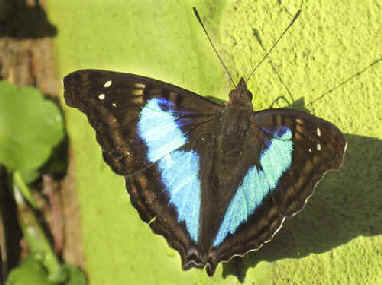
A Turquoise Emperor (or Sapphire)
photographed during a FONT tour
Doxocopa clothilda ______ CR
PN(sl) (D1:19)
CLOTHILDA EMPEROR
(Range: Costa Rica to Colombia)
Doxocopa pavon ______ CR
GU HN PN (K:225) (PE:24)
Doxocopa pavon theodora ______ CR
GU HN PN
(BMCR:164) (D1:19) (MCA:130) subspecies from south Texas to
Colombia
PAVON EMPEROR
(Range: south Texas to Bolivia)
Doxocopa callianira ______
CR GU (D1:19)
(MCA:130)
GUATEMALAN EMPEROR
(Range: Mexico to Costa Rica)
Doxocopa zunilda ______ CR
PN
Doxocopa zunilda felderi ______ CR PN
(D1:19) subspecies from Costa Rica to
Colombia
ZINGY EMPEROR
(Range: Costa Rica to Bolivia)
Doxocopa cyane (ph) ______
CR GU HN PN
Doxocopa cyane mexicana ______ CR
GU HN PN sl (BMCR:164) (D1:20) (MCA:130)
subspecies
from Mexico to Colombia, described in 1953
CYAN EMPEROR (or
Mexican Emperor)
(Range: Mexico to Peru)
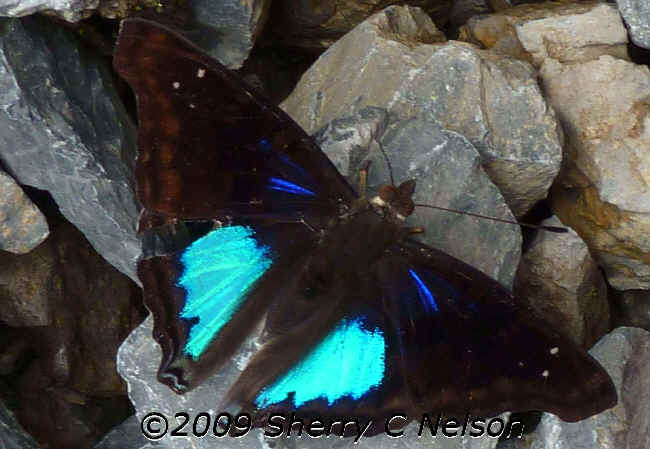
Above & below: the Cyan Emperor
(photos by Sherry Nelson)
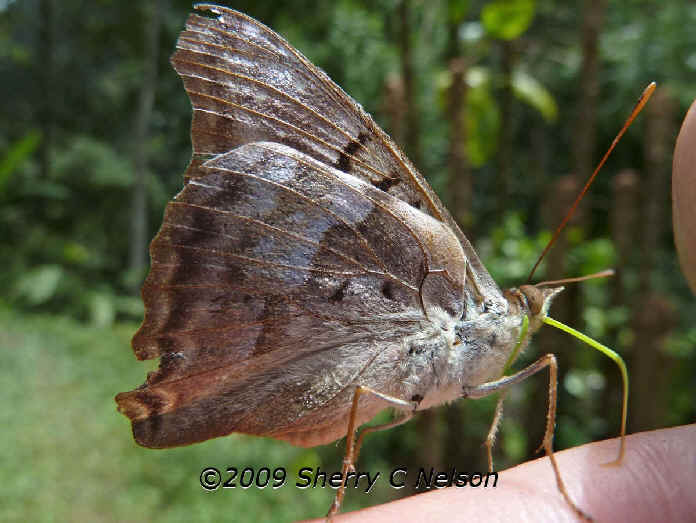
Doxocopa excelsa ______
CR (D1:20)
BROAD-BANDED EMPEROR
(Range: Nicaragua and Costa
Rica)
Doxocopa laure ______ CR
GU HN PN (C:285)
(K:225) (PE:24) (ICR:68)
Doxocopa laure laure ______ CR
GU HN pb PN sl (D1:20) (ICR:68) (MCA:130)
subspecies from the southern US to Panama
SILVER EMPEROR
(Range: Mexico to Brazil)
Doxocopa linda ______ CR
PN
Doxocopa linda plesaurina ______ CR PN sl
(D1:20) subspecies in Costa Rica
and Panama
RARE EMPEROR
Subfamily LIBYTHEINAE:
SNOUTS
Genus LIBYTHEANA: The SNOUT BUTTERFLY has long palps which protrude
under the head like a snout.
There are about 10 species which occur in South
and Central America.
They breed on members of Celtis which belong to the elm
family, Ulmaceae.
Libytheana carinenta ______ CR
GU HN PN (C:281) (F:175) (K:223) (PE:18)(PW:22) (S:146)
Libytheana carinenta mexicana ______ CR
GU HN PN (AZ:119) (D1:20)
(MCA:79) subspecies
from Mexico to Panama
AMERICAN SNOUT
(Range: southern US to Brazil)
Subfamily
NYMPHALINAE, Tribe NYMPHALINI
Genus TIGRIDIA
Tigridia acesta ______ CR
GU PN (BMCR:134)
(D1:21) (MCA:116) (species described by Linnaeus in 1758)
TIGER BEAUTY
(Range: southeast
Mexico to the Amazon
Basin)
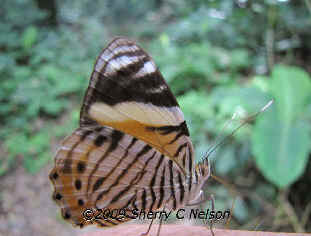
Tiger Beauty
(photo by Sherry Nelson)
Genus COLOBURA
Colobura dirce (ph) ______ CR
GU PN
(C:291) (S:114)
Colobura dirce dirce ______ CR
GU PN (BMCR:133) (D1:21)
(ICR:59) (MCA:116)
subspecies from Mexico to Argentina
DIRCE BEAUTY (other names are the
Small Beauty
or
The Mosaic)
(Range: Mexico thru Central & South America, also the West Indies)
The Dirce Beauty can be common where there are Cecropia trees,
as cecropia leaves are the host plant food for their caterpillars.
The butterflies are attracted to rotting or rotten bananas, mangoes,
papayas, and guavas.

The Small Beauty, or Mosaic
Colobura annulata ______ CR
GU PN (MCA:116)
(species described in 2001)
NEW BEAUTY
(Range: Mexico to the Guianas and Bolivia)
Genus SMYRNA
Smyrna blomfildia (ph)
______ CR GU PN (K:225) (PE:26)(PW:31)
Smyrna blomfildia datis ______ CR
GU PN (BMCR:134) (D1:21)
(ICR:60) (MCA:115) subspecies
from Mexico to Panama
BLOMFILD'S BEAUTY
(Range: Mexico to Peru)
Like the Dirce Beauty (above), the Blomfild's Beauty
feeds on rotting or rotten fruits.
Smyrna blomfildia can be found in
both dry and moist forests on both the Caribbean and Pacific slopes, in the
lowland and in premontane elevations, from sea level to 5,400 feet. Host
plants are in the Nettle family, Urticaceae.
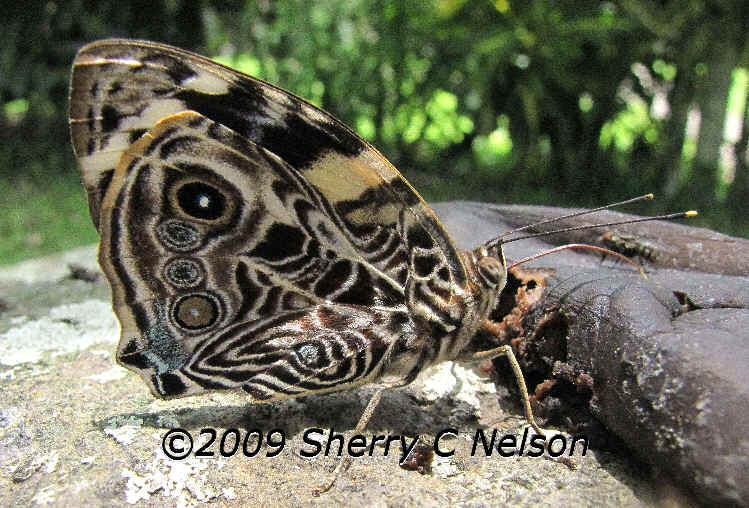
Blomfild's Beauty
(photo by Sherry Nelson)
Smyrna karwinskii ______
GU
(MCA:115)
KARWINSKI'S BEAUTY
(Range: Mexico to Nicaragua)
Genus PYCINA
Pycina zamba ______ CR
GU PN
Pycina zamba zelys ______ CR GU PN (BMCR:134) (D1:21) (MCA:115)
subspecies from Mexico to
Panama
CLOUD-FOREST BEAUTY
(Range: Mexico to Peru)
Genus HYPANARTIA
Hypanartia lethe (ph) ______
CR GU PN (C:279)
(D1:28) (MCA:95)
ORANGE MAPWING
(Range: Mexico to Brazil)
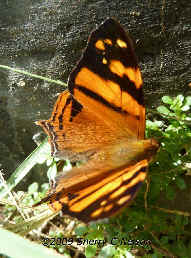
Orange Mapwing
(photo by Sherry Nelson)
Hypanartia godmani ______
CR
GU PN (D1:28)
(MCA:95)
GODMAN'S MAPWING (or
Splendid Mapwing)
(Range: Mexico to Colombia)
Hypanartia dione ______ CR
GU PN
Hypanartia dione disjuncta ______ GU
(MCA:95)
subspecies in Mexico,
Guatemala, and Honduras, described in 2001
Hypanartia dione arcaei ______ CR PN
(D1:28)
(ICR:54) subspecies in Costa Rica and Panama
BANDED MAPWING
Host plants for Hypanartia dione,
and other butterflies in the genus, are cecropias, such as Cecropia
polyphlbia, and the related nettles, Urera
eggersii and Myriocarpa longipes.
Hypanartia trimaculata ______ CR
GU PN
Hypanartia trimaculata autumna
(includes former
kefersteini) ______ CR
GU PN (D1:28)
(MCA:95) subspecies from Mexico to Panama, described in
2001
REDDISH MAPWING
(Range: Mexico to Peru)
Genus VANESSA: LADY BUTTERFLIES A
widespread group of strong fliers, sometimes migratory, with bright oranges and
reds.
Vanessa atalanta (ph) ______ GU
(F:207)
Vanessa atalanta rubria ______ GU
(AZ:187)
(MCA:93) (PE:23)(PW:29)
RED ADMIRAL
(Range: in the New World in North America and south to Guatemala; also in the
Greater Antilles)
In North America, the Red Admiral occurs in many open habitats, and breeds on the ubiquitous
nettle.
Vanessa (or
Cynthia)
cardui (ph) ______ (AZ:183) (D1:28) (K:205)
(MCA:93) (PE:23)(PW:29)
(S:141) (species described by Linnaeus in 1758)
PAINTED LADY
(Range: nearly worldwide, except for Australia and New Zealand)

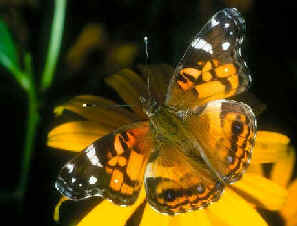
Painted Ladies
(upper photo by Doris Potter;
lower photo by Howard Eskin)
Vanessa virginiensis (ph) ______
CR
(AZ:181) (BMCR:143) (D1:28) (ICR:55) (K:205) (MCA:93) (PE:23)(PW:29)
AMERICAN LADY
(Range: from southern Canada thru North America. In Central America in montane
regions. Also in West Indies.)
In Costa Rica, the American Lady occurs mainly in the treeless paramo
zone in Talamanca Mountains.
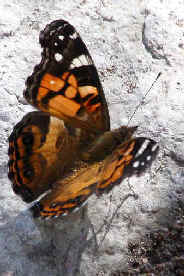
American Lady
(photo by Doris Potter)
Genus NYMPHALIS
Nymphalis cyanomelas ______ GU
MEXICAN TORTOISESHELL
(Range: southern Mexico to El Salvador)
Subfamily
NYMPHALINAE, Tribe COEINI
Genus BAEOTUS:
totally 2 species with black and white undersides and tooth-like edges to
the hindwings
Baeotus baeotus ______ CR
GU PN (BMCR:133)
(D1:21)
(F:122) (MCA:116)
GRAPHIC BEAUTY
(Range: Mexico to the Amazon
Basin)
Baeotus baeotus is an attractive and rare butterfly in virgin
rainforest.
Genus HISTORIS
Historis odius (ph) ______ CR(*) GU PN
(PE:text) (100BM:25-c)
Historis odius odious (ph) ______ CR
GU PN (BMCR:134) (D1:21) (MCA:127) subspecies from
Texas to Argentina
ORION CECROPIAN (also called
Stinky Leaf Wing)
(Range: throughout Central and South America; in North America, as
a stray to Florida)
In Costa Rica, Historis odius occurs in virtually all habitats from sea level up
to 1,500 meters.
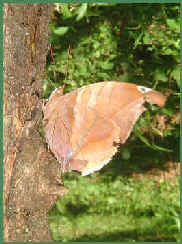
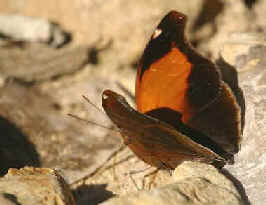
2 photos of Orion Cecropian
Historis acheronta ______ CR
GU PN (C:353)
(PW:31)
Historis acheronta acheronta ______ CR GU PN
(BMCR:133) (D1:21)
subspecies from Mexico to Brazil, as a stray to south Texas
and Arizona
TAILED CECROPIAN
(Range: Mexico to the Amazon
Basin, also in the Greater Antilles)
Subfamily BIBLIDINAE,
Tribe BIBLIDINI
Genus BIBLIS: A single species. Breeds on
Tragia, a species of spurge.
Biblis hyperia (ph) ______
CR GU HN PN(*) (C:319)
(F:124) (K:215) (PE:25)(PW:31)
Biblis nyperia aganisa ______ CR GU
HN
(D1:21) (MCA:107) subspecies
from Mexico south
to at least Costa Rica
RED RIM
(Mexico to the Amazon Basin, also the West Indies)
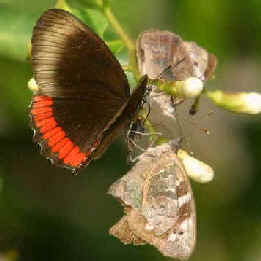
Red Rim
Genus MESTRA
Mestra amymone ______ CR
GU HN pb PN
(AZ:203) (C:315) (D:22) (K:215) (MCA:107) (PE:25)(PW:31)
NORTHERN MESTRA
(has also been called
Amymone)
(Range: southern US thru Central America)
Subfamily BIBLIDINAE, Tribe
AGERONIINI: CRACKERS and allies
Genus HAMADRYAS:
Commonly called CRACKERS
or
CALICO BUTTERFLIES. The mottled calico pattern is on the uppersides of the
wings. "Cracker" refers to the sound that the males produce from
their abdomens while in flight during interactions with other males and during
courting.
Hamadryas glauconome ______ CR GU
(AZ:369)
(PW:31)
Hamadryas glauconome glauconome ______ CR GU
(D1:21) (MCA:114)
subspecies from Mexico to
Costa Rica, possibly Panama; as a stray to south Texas
GLAUCOUS CRACKER
(Range: Mexico to Costa Rica,
possibly Panama)
Hamadryas februa (ph) ______
CR(*) GU PN(*)
(F:158) (K:217) (PE:26)(PW:31)
Hamadryas februa ferentina ______ CR
GU
PN (BMCR:159)
(D1:21) (ICR:71) (MCA:113) subspecies
from Mexico to Brazil
GRAY CRACKER
(in some places called
The Cracker) (also called
Common Calico, in general Crackers are
also called Calicos)
(Range: southern US to Brazil)
Hamadryas februa is probably the most common of the 9 Hamadryas species in Costa
Rica. It occurs along forest edges. Not at flowers, but at rotting fruit, dung,
and mud.

A Gray Cracker photographed during a FONT tour
(photo by Marie Gardner)
Hamadryas feronia (ph)
______ CR GU PN (C:259) (F:158) (K:217) (PE:26)
Hamadryas feronia farinulenta ______ CR GU PN
(D1:21) (ICR:72) (MCA:114)
subspecies
from Mexico to Peru, Venezuela, and Trinidad; as a stray to south Texas)
VARIABLE CRACKER
(Range: southern US to Brazil)
Hamadryas guatemalena (ph)
______ CR(*) GU(*) (MCA:114) (PE:26)
Hamadryas guatemalena guatemalena ______ CR
GU (D1:21) (ICR:70) subspecies
from southeast Mexico to
Costa
Rica
GUATEMALAN CRACKER
(Range: Mexico to Costa Rica)
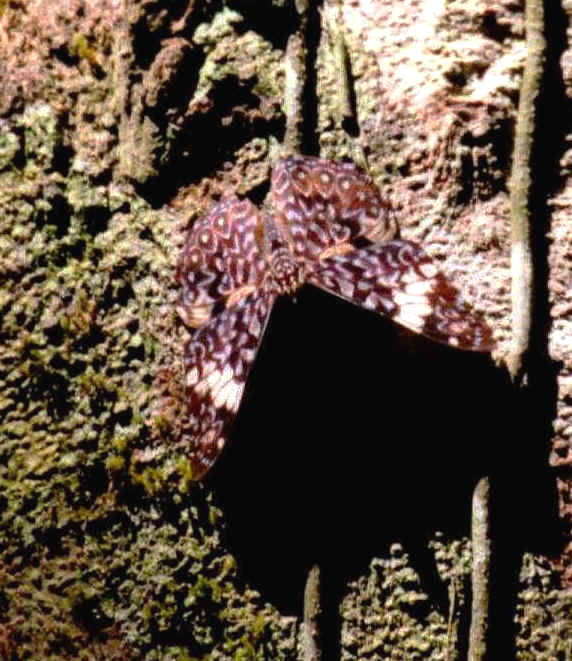
A Guatemalan Cracker blending in, on a tree,
photographed during a FONT tour in Guatemala
(photo by Marie Gardner)
Hamadryas ipthime ______ CR GU PN
Hamadryas ipthime jeannae ______ CR GU
(MCA:113)
(PE:26) subspecies from Mexico to Costa Rica, as a stray to
south Texas
Hamadryas ipthime ipthime ______ CR PN
(D1:21)
subspecies from Costa Rica to Brazil
BROWNISH CRACKER
(Range: Mexico to Brazil)
Hamadryas fornax ______ CR
GU PN
Hamadryas fornax fornacalia ______ CR GU PN
(D1:21)
(F:158) (MCA:112) subspecies
from Mexico to Venezuela
ORANGE CRACKER
(Range: Mexico to Brazil &
Bolivia)
Hamadryas fornax is smaller than other crackers, and with a number of
subspecies.
It lives in moist rainforest, where it occurs along trails and rivers.
Hamadryas amphinome (ph)
______ CR(*) GU PN (F:157) (MCA:112) (PE:26)
(100BM:50-c)
Hamadryas amphinome mexicana ______ CR
GU PN
(BMCR:159) (D1:22) subspecies
from Mexico to Colombia
RED CRACKER
(Range: Mexico to Amazon Basin)
Hamadryas amphinome lives in rainforests.

Red Cracker (the red is on the other side of the
wings)
Hamadryas atlantis ______ GU
(AZ:369) (F:158) (MCA:112) (PW:31)
Hamadryas atlantis atlantis ______ GU subspecies
from southern Mexico, in Chiapas, to Honduras
BLACK-PATCHED CRACKER
(also called
Dusty Cracker)
(Range: Mexico (mainly western) to Honduras)
Hamadryas atlantis can be found in open dry valleys.
Hamadryas arinome ______ CR
PN
Hamadryas arinome ariensis ______ CR PN
(BMCR:159)
(D1:22) (ICR:74) subspecies from Costa Rica to
Bolivia
TURQUOISE CRACKER (or
Blue Cracker)
(Range: Mexico to Amazon Basin)
Hamadryas arinome ariensis
has now been said to be Hamadryas ariensis.
Hamadryas laodamia ______ CR(*) GU PN
(C:261)
(F:159) (S:132)
Hamadryas laodamia saurites ______ CR GU
PN
(BMCR:160) (D1:22) (ICR:73) (MCA:112) subspecies from Mexico to
Venezuela; also Trinidad
STARRY NIGHT CRACKER
(Range: Mexico to Amazon Basin)
Hamadryas laodamia has a delightful coloration that is completely different than its
allies. It flies in the canopy and in sunny clearings in the rainforest.
Hamadryas laodamia saurites
has now been said to be
Hamadryas saurites.
Hamadryas
amphichloe (ph) ______ PN
Hamadryas amphichloe ferox ______ PN subspecies from Panama to
Venezuela
CARIBBEAN CRACKER (or Pale Cracker)
Genus PANACEA
Panacea procilla ______ CR
PN
Panacea procilla lysimache ______ CR PN
(BMCR:161)
(D1:22)
subspecies in Costa Rica and Panama
WIDESPREAD PANACEA
(Range: Costa Rica to the Amazon
Basin)
Genus ECTIMA: CRACKERLET
Ectima erycinoides (was
rectifascia)
______ CR GU PN (BMCR:158) (D1:22) (MCA:103)
NORTHERN ECTIMA (or
Northern Crackerlet)
(Range: Mexico to Panama)
Subfamily BIBLIDINAE,
Tribe EPICALLINI: PURPLEWINGS and allies
Genus EUNICA: 60 species in Central & South America that live in primary
forest.
Eunica tatila (ph) ______ CR GU PN
(K:215) (PE:25)(PW:30)
Eunica tatila tatila ______ CR GU
(D1:22) (MCA:111)
subspecies from Mexico to Costa
Rica
Eunica tatila bellaria ______ PN
subspecies from Panama to Brazil
and Argentina
FLORIDA PURPLEWING
(or
Large Purplewing)
(Range: southern US to Brazil & Argentina, also West Indies)

Florida Purplewing
Eunica monima (ph) ______ CR GU PN
(AZ:369) (D1:22)
(K:215) (MCA:111) (PE:25)(PW:30)
DINGY PURPLEWING
(Range: US & Mexico thru Central America to Venezuela, also the Antilles &
Bahamas)
Eunica malvina ______ CR
GU PN
Eunica malvina albida ______ CR GU PN
(D1:22)
(MCA:110) subspecies from Mexico to Panama, described in
1990
RAYED
PURPLEWING
(Range: Mexico to the Amazon Basin)
Eunica norica ______ CR PN
Eunica norica norica ______ CR PN
(BMCR:159) (D1:22) subspecies from Costa Rica to Ecuador
MIDNIGHT PURPLEWING
(Range: Costa Rica to Bolivia)
Eunica chlororhoa ______
CR
PN
Eunica chlororhoa mira ______ CR PN
(BMCR:159) (D1:22) subspecies from Honduras to
Colombia
ORANGE-STAINED PURPLEWING
Eunica mygdonia ______ CR
GU PN
Eunica mygdonia omoa ______ CR GU PN
(D1:22)
(MCA:110) subspecies from Mexico to Panama
BLIND PURPLEWING
(Range: Mexico to the Amazon Basin)
Eunica alpais ______ CR
GU PN
Eunica alpais excelsa ______ CR GU
PN(sl) (BMCR:159) (D1:23) (MCA:111) subspecies
from southern Mexico to eastern Panama
SHINING PURPLEWING
(Range: Mexico to Ecuador)
Eunica alcmena ______ CR
GU PN
Eunica alcmena alcmena ______ CR GU PN
(D1:23) (MCA:110) subspecies
from southern Mexico to Colombia and Venezuela
DARK PURPLEWING
(Range: Mexico to Peru)
Eunica sydonia ______ CR
GU PN
Eunica sydonia caresa ______ CR GU PN
(D1:22)
(MCA:110) subspecies from southeast Mexico to Panama
PLAIN PURPLEWING
(Range: Mexico to Peru)
Eunica caelina ______ CR
GU PN
Eunica caelina agusta ______ CR GU PN
(D1:23) (MCA:111) subspecies from southeast Mexico to
western Panama
Eunica caelina olympias ______ PN subspecies from eastern
Panama to Peru and Venezuela
MOTTLED PURPLEWING
(Range: Mexico to Colombia)
Eunica volumna ______ CR
GU PN
Eunica volumna venusa ______ CR
GU PN(sl) (D1:23) (MCA:111) subspecies
from Mexico to Colombia
BLUE-CELLED PURPLEWING
Eunica pomona ______ CR
GU PN
Eunica pomona amata ______ CR GU PN
(D1:23)
subspecies from southern Mexico to eastern Panama
ROUNDED PURPLEWING
(Range: Mexico to Venezuela)
Eunica caralis ______ PN
Eunica caralis caralis ______ PN subspecies in Honduras, Panama;
also Colombia and Venezuela
CARALIS PURPLEWING
Eunica carias ______ CR
PN
Eunica carias carias ______ CR PN subspecies from Costa Rica to
Colombia
CARIAS PURPLEWING
Eunica pusilla ______ CR
PN
PUSILLA PURPLEWING
(Range: Costa Rica to Bolivia and southeast Brazil)
Eunica clytia ______ PN
CLYTIA PURPLEWING
(Range: western Panama to Peru and central Brazil)
Eunica araucana ______ PN
ARAUCANA PURPLEWING
(Range: western Panama to Venezuela and Ecuador)
Genus MYSCELIA
Myscelia ethusa ______
CR
GU(*)
(K:217) (PE:24)(PWp:336)
Myscelia ethusa pattenia ______ CR
GU
(D1:22) (MCA:108) (100BM:49-c) subspecies from Guatemala to
Costa Rica
MEXICAN BLUEWING
(or
Blue Wave)
(Range: Mexico to Colombia)
Myscelia cyaniris ______
CR GU PN
Myscelia cyaniris cyaniris ______ CR
GU PN
(D1:22) (MCA:108)
subspecies
from Mexico to Panama
WHITENED BLUEWING
(Range: Mexico to Peru)
Myscelia leucocyna ______
CR
PN
Myscelia leucocyna smalli ______ CR
(D1:22)
subspecies from Nicaragua to Costa Rica, described in
1984
Myscelia leucocyna leucocyna ______
PN
subspecies from
Panama to Venezuela
PALE BLUEWING
(Range: Nicaragua to Venezuela)
Genus CATONEPHELE
Catonephele mexicana ______ CR
GU (BMCR:156) (D1:25) (MCA:109) (species described in 1985)
EAST MEXICAN BANNER (or
Guatemalan Banner)
(Range: Mexico to Costa Rica)
Catonephele numilia (ph)
______ CR(*) GU PN (MCA:109) (S:139)
Catonephele numila esite ______ CR GU
PN(sl) (BMCR:156,157) (D1:25)
subspecies
from Mexico to Venezuela, also Trinidad
BLUE-FROSTED BANNER (other names have been
STOPLIGHT CATONE, or
Grecian Shoemaker)
(Range: Mexico to southern Brazil and Argentina)
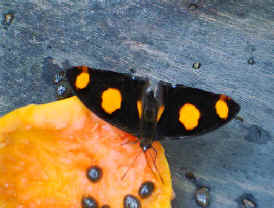
Two Blue-frosted Banners
(or
Stoplight Catones)
photographed during FONT tours
Above: a male; below: a female
(the lower photo by Virginia Woodhouse during a FONT tour in Costa
Rica in March 2012)
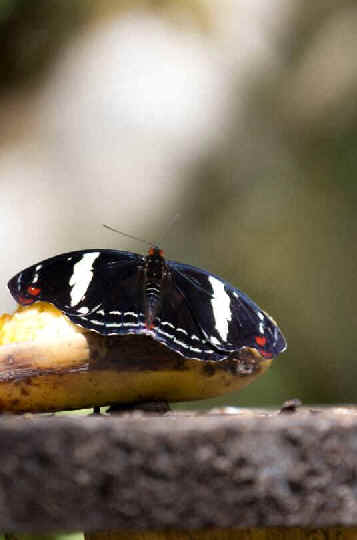
Catonephele chromis (ph)
______ CR PN
Catonephele chromis godmani ______ CR PN (BMCR:156)
(D1:25) (MCA:109)
subspecies from Honduras to Panama
SISTER-SPOTTED BANNER (another name has been
Cloud-forest Catone)
(Range: Honduras to possibly Bolivia)
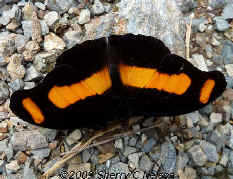
Sister-spotted Banner
(photo by Sherry Nelson)
Catonephele orites ______ CR
PN (BMCR:157)
(D1:25)
BROKEN BANNER
(Range: Costa Rica to Ecuador)
Genus NESSAEA
Nessaea aglaura ______
Nessaea aglaura aglaura ______
(BMCR:160) (D1:25) (MCA:107) (subspecies from
southern Mexico to Ecuador)
NORTHERN NESSAEA (or
Common Olivewing)
Subfamily
CYRESTINAE: DAGGERWINGS
Genus
MARPESIA: DAGGERWINGS: A genus of mostly Central and South American butterflies, but also occurs
in Africa. Called "daggerwings" after the long tail on each
hindwing. The butterflies, some of which are dimorphic, engage in mud-puddling.
Marpesia livius ______
Marpesia livius alcibiades
(formerly M. alcibiades) ______ (D1:23)
(subspecies in Costa Rica & Panama)
BROWN-BANDED DAGGERWING
(Range: Costa Rica to Brazil)
Marpesia zerynthia (or
coresia) (ph) ______ (ICR:77)
(K:219)
(PE:25)(PW:text)
Marpesia zerynthia dentigera ______
(D1:23) (MCA:117) subspecies from
Mexico to Ecuador; as a stray to south Texas
WAITER DAGGERWING
(Range: Mexico thru Central & South America)
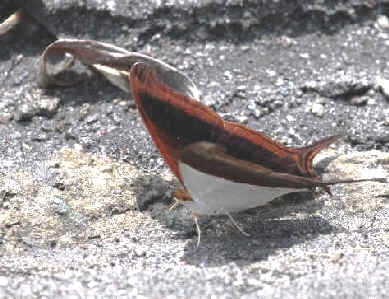
A Waiter Daggerwing photographed during a FONT tour
(photo by Marie Gardner)
Marpesia merops ______ CR(*)
(BMCR:160) (D1:23) (ICR:78) (MCA:117)
SPOT-BANDED DAGGERWING (or Dappled Daggerwing)
(Range: Guatemala to Brazil)
Marpesia berania (ph) ______
CR(*) PN(*) (C:275) (ICR:75) (MCA:117)
Marpesia berania fruhstorferi ______ CR PN
(D1:23) subspecies from Honduras to
Panama
ORANGE DAGGERWING
(Range: Belize south thru Central and South America)
Marpesia berania has communal roosts and lives up to 5 months.
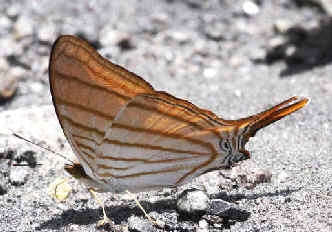
Above & below: Orange Daggerwings
photographed
during a FONT tour
(photo by Marie Gardner)
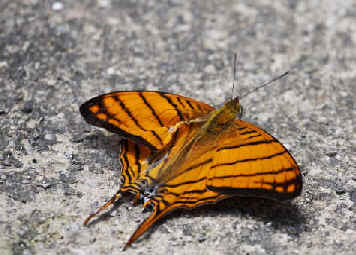
Marpesia marcella ______
Marpesia marcella valetta ______ CR(*)
(BMCR:160) (D1:23) (subspecies from
Guatemala to Panama)
PURPLE-STAINED DAGGERWING
(Range: Guatemala to Peru)
Marpesia petreus (ph) ______
(AZ:205) (F:177) (K:219) (PE:25)(PW:31) (S:123) (100C:62-c)
Marpesia petreus petreus ______ CR(*)
(BMCR:160) (D1:23) (MCA:117) subspecies
from south Florida and south Texas to western Ecuador, as a stray further
north in the US
RUDDY DAGGERWING (also
called
Southern Daggertail, and in the West Indies, the
Tailed Flambeau)
(Range: southern US thru Central & South America; also in the West Indies)
Marpesia petreus visits flowers and mud-puddles.
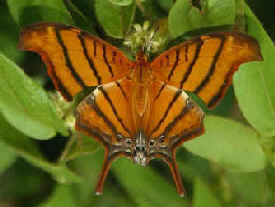
Ruddy Daggerwing
Marpesia chiron ______ (AZ:368)
(BMCR:160) (C:273)
(D1:23) (ICR:76) (K:219) (MCA:117) (PE:25)(PW:31)
MANY-BANDED DAGGERWING
(Range: Mexico to Argentina, as a stray to south Texas & further north,
also in the Greater Antilles)
Marpesia
corita ______
(MCA:117)
Marpesia corita corita ______ (subspecies from Mexico to Honduras)
Marpesia corita phiale ______ (subspecies in southern
Mexico, in Chiapas & in western Guatemala)
ORANGE-BANDED DAGGERWING
Marpesia harmonia ______
(MCA:117)
PALE DAGGERWING
(Range: southeastern Mexico &
Guatemala)
Marpesia furcula (was iole)
______ PN(*)(sl) (D1:23)
GLOSSY DAGGERWING
(or Sunset Daggerwing)
(Range: Nicaragua to Argentina)
Subfamily BIBLIDINAE,
Tribe EUBAGINI: SAILORS
Genus DYNAMINE
Dynamine agacles ______
Dynamine agacies core ______ (D1:24)
(subspecies from Costa Rica to
Colombia)
PALE SAILOR
(Range: Costa Rica to the Amazon Basin)
Dynamine theseus ______ (D1:24)
(MCA:103)
WHITE SAILOR
(Range: Mexico to Venezuela)
Dynamine athermon ______
Dynamine athermon maeon ______
(subspecies in Panama & Colombia)
GHOST SAILOR
Dynamine postverta (or
mylitta)
______
Dynamine postverta mexicana ______ (D1:24)
(subspecies in Mexico & Central America, described in 1952)
MEXICAN SISTER
(Range: Mexico thru Central & South America)
Dynamine hecuba ______ (BMCR:157)
(D1:24)
COSTA RICAN SAILOR
(Range: Costa Rica, endemic)
Dynamine vicaria (formerly
hoppi) ______
Dynamine vicaria gillotti ______ (BMCR:157,158) (D1:24)
(subspecies in Costa Rica)
GIANT SAILOR
(Range: Costa Rica & Colombia)
Dynamine dyonis ______ (D1:24)
(K:225) (PE:25)
BLUE-EYED SAILOR
(or
Blue-eyed Green Wing)
(Range: Texas to Panama)
Dynamine artemisia ______
(C:289)
Dynamine artemisia glauce ______ (D1:24) (subspecies from Mexico to Panama)
SMALL-EYED SAILOR
(Range: Mexico to Bolivia)
Dynamine paulina ______
Dynamine paulina thalassina ______ PN(sl)
(BMCR:158)
(D1:24) (subspecies from Guatemala to Colombia)
DARK SAILOR
(Range: Mexico to Colombia)
Dynamine chryseis ______ (D1:24)
THICK-RIMMED SAILOR
(Range: Nicaragua to the Amazon Basin)
Dynamine sosthenes ______
Dynamine sosthenes sosthenes ______
(D1:24) (MCA:103) (subspecies in Nicaragua & Costa Rica)
THIN-RIMMED SAILOR (or
Nicaraguan Sailor)
(Range: Nicaragua & Costa Rica)
Dynamine ate ______ (BMCR:157)
(D1:24) (MCA:103)
LITTLE SAILOR
(Range: Guatemala & Costa Rica, locally)
Dynamine colombiana ______
COLOMBIAN SAILOR
(Range: Nicaragua to Venezuela)
Dynamine tithia (ph) ______ (PW:text)
Dynamine tithia salpensa ______ (BMCR:158)
(D1:24) (subspecies
said to be in Costa Rica)
BLUE SAILOR (or
Tithian Sailor)
(Range: in northern South America in Colombia & Venezuela, but has strayed
north into Central America, and as far as Texas)
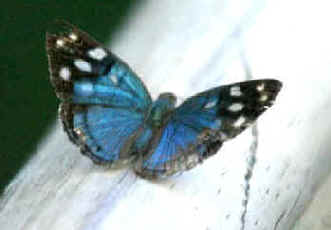
Blue Sailor
(photo by Sherry Nelson)
Subfamily
BIBLIDINAE, Tribe EPIPHILINI: BANNERS and allies
Genus ASTEROPE
Asterope degandii ______
Asterope degandii degandii
______ (subspecies from western
Panama to Ecuador)
RED-BASED BANNER
Genus
BOLBONEURA
Bolboneura sylphis ______
Bolboneura sylphis sylphis
______ (subspecies from Mexico
to Honduras)
VARIABLE
BANNER
Genus TEMENIS
Temenis laothoe hondurensis (formerly
agatha)
______
(BMCR:161) (D1:24) (MCA:107) (subspecies from
Chiapas, Mexico & Guatemala to Colombia)
ORANGE BANNER
(Range: Mexico to the Amazon)
Temenis pulchra ______
(BMCR:161) (D1:24)
RED BANNER
(Range: Costa Rica to the Amazon Basin)
Genus NICA
Nica flavilla canthara ______ (BMCR:160)
(D1:24) (MCA:107)
(subspecies from Nicaragua to Venezuela)
LITTLE BANNER
(Range: Mexico to the Amazon Basin)
Genus EPIPHILE
Epiphile adrasta ______ (K:225)
(MCA:106) (PE:25)
Epiphile adrasta adrasta ______
(BMCR:158) (D1:24) (subspecies
from Mexico to western Panama, as a stray to south Texas)
Epiphile adrasta bandusia ______ (subspecies from central
Panama to Ecuador)
COMMON BANNER (or
Dimorphic Bark Wing)
(Range: Mexico to Ecuador)
Epiphile iblis (formerly
orea) ______
Epiphile iblis plutonia ______ (subspecies in southeast
Mexico & Guatemala)
Epiphile iblis plusios ______
(BMCR:158) (D1:24) (subspecies in Costa Rica & Panama)
PLUTONIA BANNER
(Range: Mexico to Brazil)
Epiphile eriopis ______
(MCA:106)
Epiphile eriopis devriesi ______ GU
(BMCR:158) (D1:24) (subspecies from Nicaragua to
Colombia, described in 1986)
WHITE-TIPPED BANNER
Epiphile hermosa ______
(species described in 1978)
BEAUTIFUL BANNER
(Range: southeastern Mexico & Guatemala)
Epiphile grandis ______
(D1:24)
GRAND BANNER
(Range: Costa Rica & Panama)
Genus PYRRHOGYRA: RED-RINGS
Pyrrhogyra neaerea ______
Pyrrhogyra neaerea hypensor
______ (D1:28) (MCA:103)
(subspecies from Mexico to Panama)
BANDED
BANNER (or Leading Red-ring)
(Range: Mexico to the Amazon
basin)
Pyrrhogyra otolais (ph) ______
Pyrrhogyra otolais otolais
______ (BMCR:161) ((D1:28) (MCA:103)
(subspecies from Mexico to Panama)
DOUBLE-BANDED
BANNER (or White-edged Red-ring)
(Range: Mexico to Bolivia)
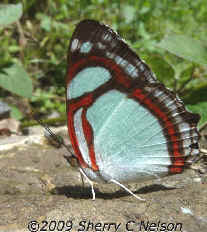
Double-banded Banner
(photo by Sherry Nelson)
Pyrrhogyra crameri ______
(BMCR:160) (D1:28) (MCA:103)
ROUNDED BANNER (or Cramer's Red-ring)
(Range: Nicaragua to Panama)
Pyrrhogyra edocla ______ (MCA:103)
Pyrrhogyra edocia edocla (formerly
aenaria) ______ (BMCR:161)
(D1:28) (subspecies from Mexico to Panama)
GREEN-SPOTTED
BANNER (or Complete Red-ring)
(Range: Mexico to the Amazon
basin)
Subfamily BIBLIDINAE,
Tribe CALLICORINI: "Eighty-eight" Butterflies
Genus DIAETHRIA
Diaethria anna (ph) ______
(MCA:105)
Diaethria anna anna ______ (D1:25) (PW:text) (subspecies from eastern Mexico to
Costa Rica)
Diaethria anna salvadorensis ______ (subspecies from
southwestern Mexico to El Salvador, described in 1954)
ANNA'S EIGHTY-EIGHT
(Range: Mexico to Costa Rica)
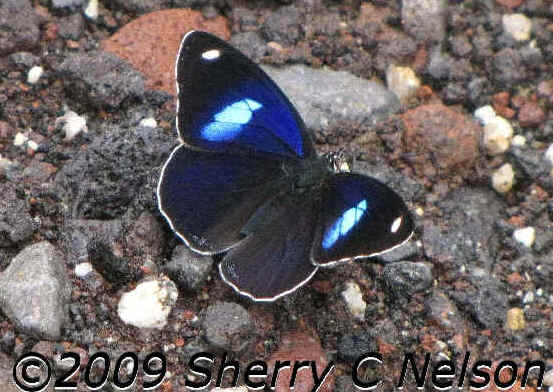
Anna's Eighty-eight
(photo by Sherry Nelson)
Diaethria clymena (ph)
______
Diaethria clymena marchalii ______ (BMCR:157)
(D1:25) (subspecies from Nicaragua to Brazil)
WIDESPREAD EIGHTY-EIGHT
(Range: Nicaragua to Brazil)
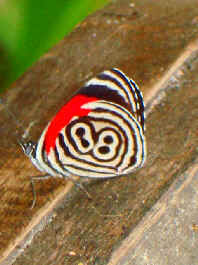
A Widespread Eighty-eight, Diaethria clymena
photographed during a FONT tour
Diaethria astala ______ (PE:25)
Diaethria astala astala ______ (D1:25)
(MCA:105) (subspecies from Mexico to Colombia, the "Turquoise-spotted"
Eighty-Eight")
ASTALA EIGHTY-EIGHT (or
Navy Eighty-Eight)
(Range: Mexico to Colombia)
Diaethria gabaza ______
Diaethria gabaza eupepla
_______ GU
(D1:25) (MCA:105) (subspecies
from Guatemala to Colombia)
SMUDGED
EIGHTY-EIGHT (or Lipstick
Eighty-Eight)
(Range: Guatemala to Colombia)
Diaethria bacchis ______ (MCA:105)
WHITE-PATCHED
EIGHTY-EIGHT
(Range: Mexico & Guatemala)
Diaethria (formerly
Cyclogramma) pandama ______
(BMCR:157) (D1:25)
ORANGE-STRIPED
EIGHTY-EIGHT
(Range: Mexico to Panama)
Genus CALLICORE
Callicore pitheas ______ CR(*)
PN(*) (D1:25)
(MCA:104) (100C:65-c)
TWO-EYED EIGHTY-EIGHT
Costa Rica common name: "Pink Pura Vida"
(Range: Mexico to Venezuela
and Ecuador)
Callicore lyca ______
Callicore lyca lyca ______ (MCA:104)
(subspecies from southern Mexico to Honduras)
Callicore lyca aerias ______ PN(sl)
(BMCR:156) (D1:25) (subspecies from Guatemala to Panama)
SIX-SPOTTED EIGHTY-EIGHT
(Range: Mexico to Ecuador)
Callicore atacama ______
Callicore atacama folschveilleri ______ CR
PN (D1:25)
(subspecies in Costa Rica &
western Panama, described in 2008)
Callicore atacama faustina ______ (D:125) (subspecies
in Costa Rica & Panama, on the Caribbean slope)
YELLOW-BANDED EIGHTY-EIGHT
(Range: Costa Rica to Bolivia)
Callicore brome ______
(MCA:104)
Callicore brome angusta ______ CR
(D1:25) (subspecies in
Costa Rica, described in 2000)
Callicore brome danieli ______ (subspecies in Panama, in the
Darien, described in 2003)
FOUR-SPOTTED EIGHTY-EIGHT
(Range: Costa Rica to Ecuador)
Callicore texa ______
(MCA:104)
Callicore texa tacana ______ (subspecies in southern Mexico &
Guatemala, described in 1983)
Callicore texa titania ______ (D1:25)
(subspecies from southern Mexico to Colombia)
YELLOW-RIMMED EIGHTY-EIGHT
(Range: Mexico to Colombia)
Callicore astarte ______
Callicore astarte patelina ______ (BMCR:156)
(D1:25) (MCA:104) (subspecies
from Mexico to Costa Rica)
Callicore astarte staudingeri ______ (subspecies in
Panama, in the Darien, and south in Colombia & Venezuela)
BLUE-STITCHED EIGHTY-EIGHT
(Range: southern Mexico to Costa Rica)
Callicore tolima ______
(MCA:104)
Callicore tolima pacifiica ______ (subspecies in southern Mexico & western
Guatemala)
Callicore tolima guatemalena ______ (subspecies in Guatemala)
Callicore tolima peralta ______ (D1:26)
(subspecies from Honduras to eastern Costa Rica & Panama)
Callicore tolima bugaba ______
(BMCR:156) (D1:26) (subspecies in southwestern Costa Rica & Panama)
BLUE-AND-ORANGE EIGHTY-EIGHT
(Range: Mexico to Panama)
Genus HAEMATERA
Haematera pyramus ______
Haematera pyramus thysbe ______ (D1:25) (subspecies from Nicaragua to Colombia)
BLIND EIGHTY-EIGHT
(Range: Nicaragua to the Amazon Basin)
Genus MESOTAENIA
(formerly part of PERISAMA)
Regarding the genus PERISAMA: Over 50 species found mostly in
South America, with a closely-related species in Central America.
The butterflies are
brightly colored with a large orange splash on the forewing underside and an
orange band near the apex.
Most are iridescent. They lack the number-like
patterns found the hindwing underside of the CALLICORE.
They all live in
upland rainforest, where they may be abundant. Some species are rare and
prized by collectors.
Mesotaenia barnesi ______
CR (D1:26)
(100BM:99-c) (was
Perisama barnesi)
COSTA RICAN EIGHTY-EIGHT
(Range: Costa Rica, endemic)
Subfamily LIMENITIDINAE,
Tribe LIMENITIDINI: SISTERS
Adults are often characterized by a flap-and-glide
flight.
Genus ADELPHA: In round figures, 70 species and 250 forms and races. These are mostly South
American, but also Central American with one species extending north of
Mexico. These butterflies are, overall, similar, and can be difficult to
identify, with small differences in spots, angles of lines, and colors being
significant. Butterflies of this genus are found in most habitats, from sea
level to upland rainforest.
Adelpha eulalia ______ (AZ:201)
(F:113) (K:213) (MCA:99) (PE:24)(PW:30): some
of these books refer to
Adelpha bredowi, the
Mexican Sister, and
Adelpha californica, the
California Sister; these have been considered
conspecific
ARIZONA SISTER
(Range: southwest US to Guatemala)
Adelpha eulalia lives in oak woodlands in foothills.
Adelpha messana ______ HN
Adelpha messana messana ______ HN pb
subspecies from Guatemala to
Ecuador and Venezuela
MESSANA SISTER
Adelpha melanthe (or
lycorias) ______ HN
(MCA:101)
Adelpha melanthe melanthe ______
HN (BMCR:147) (D1:26)
(MCA:101) subspecies from Mexico to Panama
RAYED SISTER
(Range: Mexico to Ecuador)
In Costa Rica, Adelpha melanthe,
the Rayed Sister, is one of 2 somewhat generalist Adelpha species.
The other is Adelpha serpa celerio,
the Celerio Sister.
Adelpha etheida (formerly
zalmona)
______ PN(*) (MCA:101)
Adelpha etheida sophax ______ PN sl
(BMCR:146) (D1:26) subspecies from
eastern Costa Rica to central Panama, in cloud forest
ETHEIDA SISTER (or
Silver-banded Sister)
(Range: Mexico to Colombia)
Adelpha boreas ______
PN(*)
Adelpha boreas boreas
(was
opheltes) ______ PN sl (D1:26)
subspecies from eastern Costa Rica to Venezuela
and Bolivia
BOREAS SISTER
Adelpha salmoneus ______ HN
Adelpha salmoneus salmonides ______ HN pb
(BMCR:147)
(D1:26) (MCA:101)
subspecies from southeast Mexico to central Panama
GOLDEN-BANDED SISTER
(Range: Mexico to Venezuela)
Adelpha leucopthalma ______
Adelpha leucopthalma leucopthalma ______
(BMCR:146) (D1:26) subspecies
from Nicaragua to Colombia
Adelpha leucopthalma smalli ______ subspecies on
the Azuero Peninsula in Panama, on Cerro Montuoso, described in 2003
LEUCOPTHALMA SISTER
Adelpha zina (formerly
Adelpha justina)
______
Adelpha zina lacina ______ (BMCR:147) (D1:26)
subspecies from Nicaragua to western Panama
Adelpha zina zina ______ subspecies from eastern
Panama to Venezuela and Ecuador
ZINA SISTER
Adelpha cytherea ______ BZ(*)
CR(*) GU HN PN
Adelpha cytherea marcia ______ BZ CR
GU HN pb (BMCR:145) (D1:26) (ICR:65) (MCA:98) subspecies from
southern Mexico to eastern Costa Rica
Adelpha cytherea daguana ______ CR PN
subspecies from
eastern Costa Rica to Venezuela and Ecuador; in eastern Costa Rica
intergrades with A. c. marcia
CYTHEREA SISTER (or
Smooth-banded Sister)
(Range: Mexico to the Amazon Basin)
In Costa Rica, Adelpha cytherea
is a common butterfly, inhabiting moist and wet lowlands of the Caribbean
and southern Pacific regions.
The adult butterflies feed on rotting fruits and on the nectars of asters
and "hot lips", a plant in the genus Cephaelis.
Adelpha cocala ______ HN
PN(*)
(C:277)
Adelpha cocala lorzae ______ HN PN sl
(BMCR:145) (D1:26) (MCA:100)
subspecies from Mexico to Venezuela and Ecuador
LORZA'S SISTER (or
Orange-washed Sister)
(Range: Mexico to the Amazon Basin)
Adelpha heraclea ______
Adelpha heraclea heraclea ______ (D1:26)
subspecies from Guatemala to Peru & Brazil
HERACLEA SISTER
Adelpha boeotia (or
jacquelinae) ______ HN
Adelpha boeotia oberthuerii ______ HN
(MCA:100) subspecies from Mexico to western Panama
Adelpha boeotia boeotia ______
(D1:26) subspecies from
eastern Panama to Bolivia, southwest Brazil, the Guianas
OBERTHUR'S SISTER (or Felder's
Sister)
Adelpha erymanthis ______ HN
Adelpha erymanthis erymanthis ______ HN
(BMCR:146)
(D1:26) (MCA:100) subspecies from southern Mexico to
eastern Panama
ERYMANTHIS SISTER (or
Godman's Sister)
(Range: Mexico to Colombia; in cloud forest)
Adelpha delinita
(or
Adelpha escalantei) ______ HN
Adelpha delinita utina ______ HN (BMCR:145)
(D1:50) (MCA:100)
subspecies from Mexico to Panama; type locality in Honduras
UTINA SISTER
(or
Delineated Sister)
(Range: Mexico to Ecuador)
Adelpha basiloides ______
HN (D1:26) (MCA:97) (PE:text) (100BM:32-c)
SPOT-CELLED SISTER (has been called
Tropical Sister)
(Range: south Texas to Venezuela and Ecuador)
Adelpha iphiclus (ph) ______
CR GU HN PN
Adelpha iphiclus iphiclus (ph) ______ CR GU
HN PN (BMCR:146)
(D1:27) (ICR:66) (MCA:99) subspecies from Mexico to Bolivia
and the Guianas; also Trinidad
IPHICLUS SISTER (or
Pointer Sister)
(Range: Mexico to Bolivia and the Guianas; also Trinidad)
In Costa Rica, Adelpha iphiclus
occurs much more commonly on the Pacific side of the country, and especially
in the northwest.
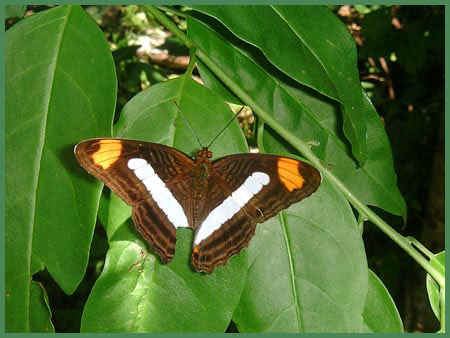
Iphiclus Sister
Adelpha erotia ______ PN
Adelpha erotia erotia ______ PN sl (BMCR:145)
(D1:27 and with Adelpha lerna aeolia) (MCA:100)
subspecies
from Costa Rica to Bolivia, Amazonian Brazil, the Guianas; form "lerna"
in the same range but north into Chiapas, Mexico
EROTIA SISTER (or
Stitched Sister)
(Range: Guatemala to Venezuela)
Adelpha phylaca ______ HN
Adelpha phylaca phylaca ______ HN
(D1:27)
(MCA:100)
subspecies from Mexico to Honduras
Adelpha phylaca pseudaethalia ______ HN
subspecies from
Chiapas, Mexico to Venezuela and Ecuador
PHYLACA SISTER (or
Cecropia Sister)
Adelpha naxia ______
HN PN(*)
Adelpha naxia naxia ______ HN PN
sl (D1:27) (MCA:99) subspecies from
Mexico to Bolivia, the Brazilian Amazon, and the Guianas
NAXIA SISTER (or
Three-part Sister)
Adelpha barnesia (was
Adelpha lxia) ______ HN
Adelpha barnesia leucas ______ HN
(D1:27) (MCA:99)
subspecies from Mexico to
Venezuela and Ecuador
LEUCAS SISTER (or
Barnes' Sister)
Adelpha leuceria ______ HN
Adelpha leuceria leuceria ______ HN
(BMCR:146)
(D1:27)
(F:113) (MCA:101) subspecies
from Mexico to eastern Panama
YELLOW-STRIPED SISTER (or
Orange-striped Sister)
Adelpha leuceria frequents rain and cloud forests, it will even fly in the
mist. Males are encountered mostly, as females remain in the canopy.
Adelpha leucerioides ______ HN
Adelpha leucerioides leucerioides ______ HN
(MCA:101) subspecies in
Mexico and Guatemala, described in 1975
TAWNY-STRIPED SISTER (or
Veracruz Sister)
Adelpha tracta ______ (BMCR:147)
(D1:27) (ICR:67)
TRACTA SISTER
(Range: Nicaragua to western Panama, in cloud forest)
Adelpha tracta is one of two
cloud-forest species of Adelpha
in Costa Rica, and it is one of the few Adelpha buttrflies that does not
have an orange spot on each forewing and a white diagonal band across the
forewings and hindwings.
Rather, it has a brown background with orange stripes along the edge of the
forewings and hindwings.
In Costa Rica, Adelpha tracta
occurs from 2,700 to 7,500 feet above sea level.
Adelpha demialba ______
(BMCR:145) (D1:27)
WHITE-SPOTTED SISTER
(Range: Costa Rica to eastern Panama, in cloud forest)
Adelpha demialba is the other
one of the two cloud-forest species of Adelpha
in Costa Rica.
Adelpha diocles ______
Adelpha diocles creton ______
(MCA:98) subspecies from Mexico
to Guatemala and El Salvador
Adelpha diocles diocles ______ (D1:27)
subspecies in eastern Costa Rica and western Panama
SHORT-TAILED
SISTER
(Range: Mexico to Panama)
Adelpha serpa (formerly
celerio)
______ CR(*) HN PN(*) (100C:43-c)
Adelpha serpa celerio ______ CR HN pb PN
sl (BMCR:147)
(D1:27) (MCA:97) subspecies from Mexico to Venezuela
CELERIO SISTER (or
Celadon Sister)
(Range: Mexico to the Amazon Basin)
In Costa Rica, the Celerio Sister is one of 2 somewhat generalist Adelpha
species in the country. The other is Adelpha
melanthe.
Adelpha fessonia ______ CR(*)
HN (K:213)
(PE:24)
Adelpha fessonia fessonia ______ CR
HN (D1:27) (MCA:97) subspecies
from Mexico to western Panama, also south Texas
BAND-CELLED SISTER
Adelpha iphicleola
(or
massilides)
______ HN
Adelpha iphicleola iphicleola ______ HN
(MCA:97)
subspecies from Mexico to eastern Panama
Adelpha iphicleola gortyna ______ subspecies in Costa Rica
and western Panama, intergrading with nominate
IPHICLEOLA SISTER (or
Confusing Sister)
Adelpha stilesiana ______ (D1:27)
(species described in 1982)
TALAMANCA SISTER
(Range: in the Talamanca Mountains of Costa Rica and western Panama on
Chiriqui Volcano)
Adelpha melona ______
Adelpha melona neildi ______ subspecies in central Panama,
described in 2003
MELLONA SISTER
Adelpha paroeca (or
emathia, formerly
zea) ______
Adelpha paroeca paroeca ______ (D1:27) (MCA:99)
subspecies from Mexico to Panama
PAROECA SISTER (or
Eyed Sister)
(Range: Mexico to the Amazon Basin)
Adelpha felderi ______ HN
(D1:27
in book, but not in Costa Rica) (MCA:98)
FELDER'S SISTER (or
Rusty Sister)
(Range: eastern Mexico to Honduras)
Adelpha seriphia ______
Adelpha seriphia godmani ______
(MCA:97) subspecies from southern Mexico to Ecuador
GODMAN'S SISTER (or Dentate Sister)
Adelpha paraena ______
HN
Adelpha paraena massilia ______ HN pb
(MCA:97) subspecies from Mexico to Panama
Adelpha paraenia lecromi ______ subspecies from central
Panama to northern Colombia, described in 2003, called "Le'Crom's
Sister"
MASSILIA SISTER (or
Bates' Sister)
Adelpha nea ______
Adelpha nea sentia ______
(MCA:98) subspecies in southeast Mexico and Belize
Adelpha nea nea ______ subspecies from Costa Rica to Brazil
NEA (or
SENTIA) SISTER (also called
Scarce Sister)
Adelpha donysa ______ HN
Adelpha donysa donysa ______
(MCA:98) subspecies in southern Mexico and Guatemala
Adelpha donysa albifilum ______ HN
subspecies in El Salvador and Honduras, described in 1974
DONYSA SISTER (or
Montane Sister)
Adelpha pithys ______
HN
(MCA:98)
PITHY SISTER
(Range: Mexico to El Salvador and Honduras)
Adelpha malea ______ HN
Adelpha malea fundania ______ HN
(MCA:99) subspecies
from Mexico to Venezuela
FUNDANIA
SISTER (or Venezuelan Sister)
Adelpha milleri ______ HN
(MCA:100)
(species described in 1976)
MILLER'S SISTER (or
Cloistered Sister)
(Range: southeast Mexico & Belize)
Adelpha salus ______ (MCA:101)
SALUS SISTER (or
Lost Sister)
(Range: southeast Mexico to
western Panama)
Adelpha radiata ______
Adelpha radiata aiellae ______ subspecies
from central Panama to Ecuador, described in 1999)
STRIATED SISTER
Adelpha hesterbergi ______
species described in 1999
HESTRBERG'S SISTER
(Range: Costa Rica & Ecuador; also possibly Panama, western
Colombia)
Subfamily NYMPHALINAE,
Tribe VICTORININI
Genus SIPROETA: These butterflies in South & Central America, and as far north
as the southern US.
Siproeta (or
Metamorpha)
stelenes (ph) ______ CR(*) GU(*) PN(*) (AZ:367) (F:202)
(K:209) (PE:26)(PW:30)
Siproeta stelenes biplagiata ______
CR GU PN(sl) (BMCR:137) (D1:28)
(ICR:61) (MCA:96)
subspecies from Mexico to the Amazon; also south Florida, south
Texas, as a stray further north, Cuba and the Cayman Islands
MALACHITE
(Range: southern US to the Amazon Basin, and throughout the West Indies)
The Malachite is on the wing all year in the tropics, it feeds on
fermenting fruit.
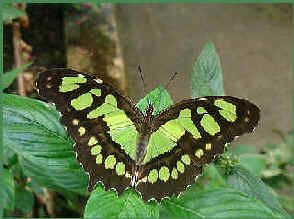
Above & below: Malachites
In the lower photo, a Malachite feeding on fruit on the ground
during a FONT tour in Costa Rica in March 2012
(lower photo by Virginia Woodhouse)
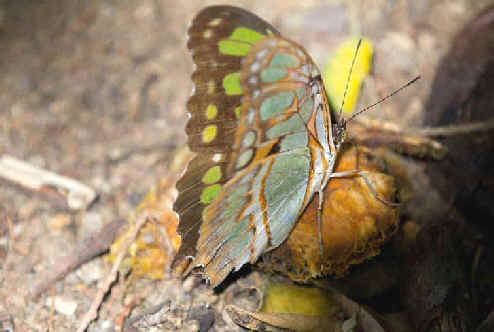
Siproeta epaphus (ph) ______
CR(*) GU PN(*) (K:209) (PW:30) (S:136)
(100BM:31-c)
Siproeta epaphus epaphus ______ CR
GU
PN (BMCR:137) (D1:28) (ICR:62) (MCA:96)
subspecies from Mexico to Peru; as a stray to south Texas southern New
Mexico
RUSTY-TIPPED PAGE (or
Brown Siproeta)
(Range: Mexico to Peru)
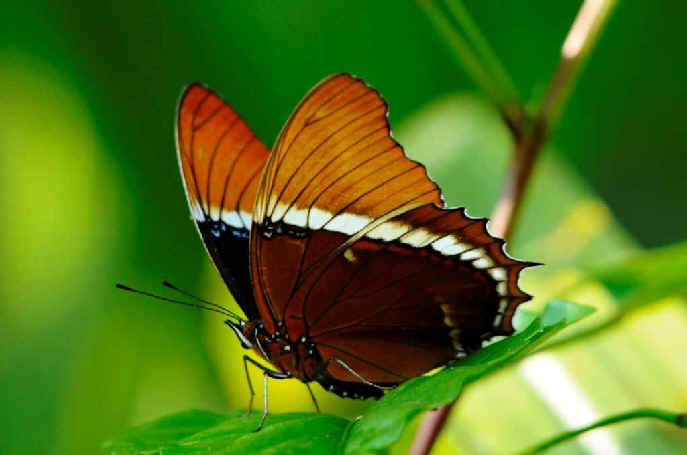
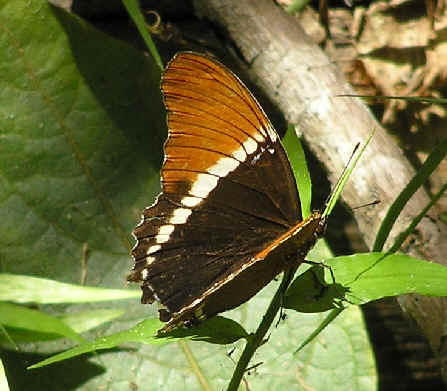
Two photos above of the Rusty-tipped Page
(the upper photo by Marie Grenouillet,
the lower photo by Rosemary Lloyd during a FONT tour in Costa Rica)
Siproeta superba ______ CR
GU
Siproeta superba superba ______ GU
(MCA:96) subspecies from Mexico to Honduras
Siproeta superba euoe ______ CR (D1:28) (MCA:96) subspecies in Costa Rica, described in
1971
BROAD-BANDED PAGE
(Range: Mexico to Costa Rica)
Genus ANARTIA: 4 species found in the southern US to Central America, and in
the West Indies. These are common butterflies of the tropics. They are swift
fliers, and bear some resemblance to members of the CYNTHIA
genus.
Anartia amathea (ph) ______
PN (C:311)
(species described by Linnaeus in 1758)
Anartia amathea amathea ______ PN subspecies from Panama to Argentina,
and on Barbados, Grenada, Antigua
RED PEACOCK
(Range: Panama to Argentina, also: Trinidad & Tobago, Grenada, Barbados,
Antigua)
Anartia jatrophae (ph) ______
BZ CR(*), GU(*), PN(*) (C:309) (D1:28) (K:209)
(MCA:94) (PE:24)(PW:30) (S:107) (species described by
Linnaeus in 1763)
Anartia jatrophae lutepicta ______ BZ CR GU
PN (BMCR:137) (ICR:64)
subspecies
in Central America
WHITE PEACOCK
(Range: southern US thru Central
and South America, also West Indies)
Anartia jatrophae is generally found in drier
areas than Anartia fatima.
As with other butterflies, the female of Anartia jatrophae is larger
than the male, at times double the size.

White Peacock
Anartia fatima ______ BZ(*)
CR(*) GU(*) PN(*) (K:209)
(PE:24)(PW:30)
Anartia fatima fatima (ph) ______ BZ
CR GU PN(sl)
(BMCR:137) (D1:28) (ICR:63) (MCA:94) subspecies
from Texas to Colombia
BANDED PEACOCK (other names
are Brown Peacock, White-banded Fatima, or Fatima)
(Range: southern US to eastern Panama)
In Costa Rica, Anartia fatima is extremely common in
disturbed areas such as clearings and fresh second growth, particularly where
moist.
Some individuals with yellow bands and others with white bands are found
flying together. It was assumed that the color-band difference was
polymorphism. But more-recent studies have indicated that the colors are due
to age.
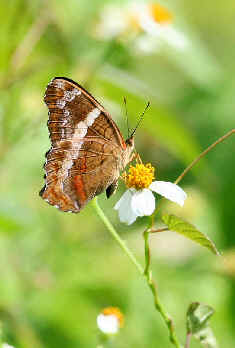
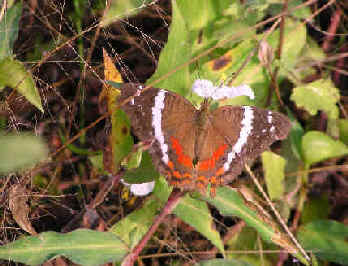
Two photographs of Banded Peacocks taken during FONT
tours in Guatemala
(upper photo by Marie Gardner; lower photo by Doug Johnson)
Subfamily
NYMPHALINAE, Tribe JUNONIINI: BUCKEYES, MIMIC
Genus JUNONIA: BUCKEYES,
a common name from the
false eyes that are prominent on the wings. This is a widespread grouping,
found in all of the global regions. The precise number of species is unknown,
as there is yet more classifying to be done.
Junonia evarete (ph) ______ CR(*)
GU
PN(*) (BMCR:137) (D1:28)
(F:168) (K:207) (MCA:94) (PE:23)
TROPICAL BUCKEYE
(Range: southern US thru American tropics)

A Tropical Buckeye photographed in the Guanacaste
region of Costa Rica
in February 2015 (photo by Burke Korol)
Junonia genoveva (ph) ______ (AZ:193)
(K:207) (MCA:94) (PE:23)(PW:30)
MANGROVE BUCKEYE (other
names are West Indian Buckeye, Smoky Buckeye)
(Range: southern US to Argentina)
Genus HYPOLIMNAS: Commonly called DIADEM BUTTERFLIES, because of the row of
spots around the wings which look like a necklace. Sexual dimorphism is
exhibited, and females sometimes mimic DANAID butterflies. These butterflies
are found in open sunny areas, villages, glades, and forest edges, and they
frequent nectar feeders.
Hypolimnas misippus (ph) ______ CR(*)
(D1:28)
(F:164)
The MIMIC (other names:
Diadem Butterfly, Six-continent Butterfly, Danaid Butterfly)
Hypolimnas misippus is one of the most widespread
butterflies in the world, thanks in part to human history. It is thought to
have been introduced to the Americas in slave ships from Africa.
The sexes are
completely different, with the male looking like a male
Hypolimnas bolina, but
with white wing marks. The female has a number of forms with mimic various
DANAIDS, resembling
Danaus chrysippus of the Old World, with coloration similar to
Danaus glippus, the Queen.
Subfamily NYMPHALINAE,
Tribe MELITAEINI
Genus CHLOSYNE: PATCHES
(more southern) & small
CHECKERSPOTS (more northern). Most species occur in the tropics,
where many of
them mimic distasteful butterflies.
Chlosyne lacinia (ph) ______ CR(*) GU PN
(AZ:153)
(C:265) (K:189) (MCA:82) (PE:21)(PW:26)
Chlosyne lacinia lacinia ______
CR GU PN(sl) (BMCR:141)
(D1:29) subspecies from central Mexico to Panama
BORDERED PATCH
(Range: the southwest and south-central US to Argentina)
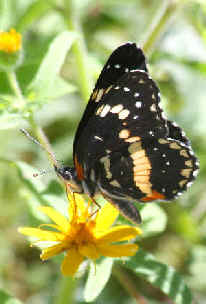
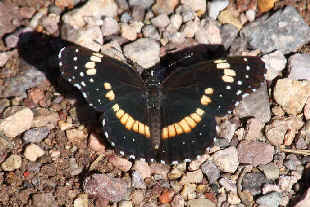
Bordered Patches photographed during a FONT Tour
(photos by Doris Potter)
Chlosyne janais (ph) ______ CR GU(*) PN
(K:189) (MCA:82) (PE:21)(PW:26)
Chlosyne janais janais ______ CR
GU PN (BMCR:140) (ICR:56) (D1:29) subspecies
from Texas to Colombia
CRIMSON-PATCH CHECKERSPOT (other names are
Crimson Patch
,Janais Patch, or
Giant Patch)
(Range: Texas to Colombia)
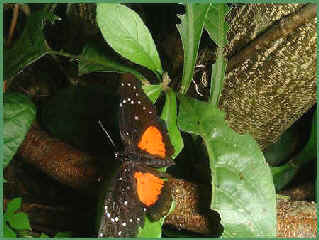
Crimson-patch Checkerspot
Chlosyne rosita (ph) ______ GU(*)
(AZ:365) (C:263) (K:189) (MCA:82) (PE:21)(PW:26)
Chlosyne rosita rosita ______ GU
subspecies in Chiapas, Mexico and in Guatemala
ROSITA CHECKERSPOT (or
Rosita Patch)
(Range: Mexico and Guatemala, and as a stray to south Texas, southeast Arizona,
and to El Salvador)
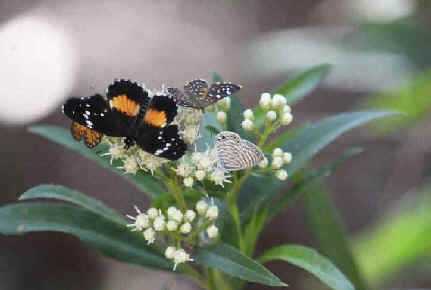
A Rosita-patch Checkerspot and other butterflies during a FONT
tour in northern Mexico
(photo by Marie Gardner)
Chlosyne melanarge ______ CR
GU (D1:29)
(MCA:83)
CREAM-BANDED CHECKERSPOT (or
Black Patch)
(Range: eastern Mexico to Costa Rica)
Chlosyne hippodrome ______ CR
GU PN (D1:29) (MCA:83)
SIMPLE CHECKERSPOT (or
Simple Patch)
(Range: Mexico to Colombia)
Chlosyne poecile ______ CR PN
(D1:29)
POECILE CHECKERSPOT
(Range: Costa Rica to Venezuela)
Chlosyne erodyle ______ CR GU
Chlosyne erodyle erodyle ______ CR GU
(D1:29)
(MCA:83) subspecies from southern Mexico to northwest Costa
Rica
ERODYLE CHECKERSPOT (or
Guatemalan Patch)
(Range: Mexico to Costa Rica)
Chlosyne gaudialis ______ CR
GU PN
Chlosyne gaudialia gaudialis ______ CR GU PN
(BMCR:140)
(D1:29) (MCA:83) subspecies
from southeast Mexico to Panama
GAUDY CHECKERSPOT (or
Gaudy Patch)
Chlosyne narva ______
CR PN(*)
Chlosyne narva narva ______ CR subspecies from Nicaragua to
Venezuela
Chlosyne narva bonpland ______ CR
PN(sl)
(BMCR:140) (D1:29) (ICR:57)
subspecies
from Costa Rica to Ecuador
NARVA CNECKERSPOT
(Range: Nicaragua to Venezuela)
Chlosyne ezra ______ CR PN
(D1:29)
EZRA CHECKERSPOT
(Range: Costa Rica and Panama)
Chlosyne theona ______
BZ GU(*) (AZ:145) (C:257) (D1:29) (K:193)
(MCA:84) (PE:19)(PW:26)
Chlosyne theona theona ______ GU
subspecies from Chiapas, Mexico
to Nicaragua
Chlosyne theona minimus ______ BZ GU
subspecies from the Yucatan
Peninsula in Mexico to Honduras, described in 1998
Chlosyne theona costaricensis ______ CR
subspecies in northwest
Costa Rica and southwest Nicaragua, described in 1998
THEONA CHECKERSPOT
(Range: southern US to northwest Costa Rica)
Chlosyne theona
and Chlosyne erza (both above) was in
the former genus Thessalia.
Genus PHYCIODES: CRESCENTS: North & South
American butterflies which often have a speckled and variable pattern. Some
species are sexually dimorphic. They live in open sunny meadows and pastures,
and visit flowers regularly for nectar. A few species are migratory, but most
are not.
Phyciodes graphica (or
vesta) ______ GU (AZ:161)
(K:181) (MCA:92) (PE:21
& PEp:256)(PW:27)
VESTA CRESCENT
(Range: south-central US to Guatemala)
Phyciodes phaon ______ GU
(AZ:163) (F:195) (K:181) (MCA:92) (P:21)(PW:28)
Phyciodes phaon maya ______ GU
subspecies in Chiapas,
Mexico and Guatemala
PHAON CRESCENT
(Range: southern US to Guatemala)
Genus or subgenus ANTHRANASSA
If a subgenus, it would be of the genus PHYCIODES
Anthranassa
texana (ph) ______ GU (AZ:159) (F:195) (K:183) (MCA:90) (PE:21)(PW:27)
TEXAN CRESCENT
(Range: southern US to Guatemala)
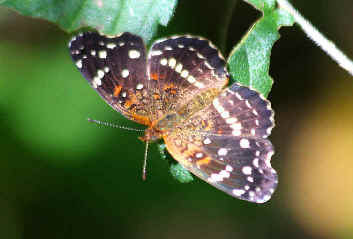
A Texan Crescent photographed during a FONT Tour
(photo by Doris Potter)
Anthanassa
tulcis ______ CR GU PN
(PW:27)
(D1:30) (MCA:90)
PALE-BANDED CRESCENT (has been called
Tulcis Crescent)
(Range: south Texas to Panama)
A closely-related species to Anthanassa tulcis is
Anthanassa frisia, the
Cuban Crescent (PE:21))
Anthanassa
drusilla ______ CR GU PN
Anthanassa drusilla lelex ______ CR GU PN
(BMCR:140) (D1:30) (MCA:90)
subspecies
from Mexico to Panama; as a stray to south Texas
Anthanassa drusilla drusilla ______ PN
subspecies from Panama
to Venezuela and Ecuador
ORANGE-PATCHED CRESCENT
Anthanassa
atronia ______ CR GU PN
(D1:30) (MCA:89)
BROWN CRESCENT
(Range: Mexico to Panama)
Anthanassa otanes ______ CR
GU PN
Anthanassa otanes otanes (or sopolis) ______
CR GU (D1:30)
(MCA:91) subspecies in southern Mexico and western
Guatemala to Costa Rica
Anthanassa otanes fulviplaga ______ CR PN
(D1:30)
(BMCR:140) subspecies in Costa Rica and Panama
BLACKENED CRESCENT (or
Cloud-forest Crescent)
Anthanassa crithona ______ CR PN
(D1:30)
ORANGE-BANDED CRESCENT
(Range: Nicaragua to Panama)
Anthanassa ardys ______ CR (BMCR:140)
(D1:30) (ICR:58) (MCA:90)
ARDYS CRESCENT (or
Ardent Crescent)
(Range: Mexico to Colombia; the southern Central American segregate from
Nicaragua south)
In Costa Rica, Anthanassa ardys
occurs from 3,000 to 4,800 feet above sea level on both the Caribbean and
Pacific slopes.
Anthanassa subota ______
GU
CRYTIC CRESCENT
(Range: Mexico to Guatemala)
Anthanassa sosis (or
dora) ______ CR PN
(D1:30)
SOSIS CRESCENT
(Range: Costa Rica to Colombia)
Anthanassa ptolyca ______ CR GU PN
(K:183) (PE:21) (MCA:91)
Anthanassa ptolyca ptolyca ______ CR GU PN
(D1:30) subspecies from
southern Mexico to Venezuela
DARKENED CRESCENT
(or
Black Crescent)
(Range: Mexico to Venezuela)
Anthanassa nebulosa
______ GU
Anthanassa nebulosa nebulosa ______ GU
(MCA:91)
subspecies in Chiapas, Mexico and Guatemala
NEBULOSA CRESCENT (or Blurry
Crescent)
Anthanassa
dracaena ______ CR GU
Anthanassa dracaena phlegias ______ CR GU (MCA:91)
subspecies from southern Mexico to Costa Rica
NOTCHED CRESCENT
Anthanassa drymaea
______ GU
WEAK-BANDED CRESCENT
(Range: southern Mexico to Honduras)
Anthanassa sitalces
______ GU
Anthanassa sitalces sitalces ______ GU subspecies in Chiapas, Mexico
and Guatemala
MONTANE
CRESCENT
Anthanassa argentea
______ GU
CHESTNUT CRESCENT
(Range: Mexico to Nicaragua, as a stray to south Texas)
Genus MICROTIA
Microtia elva ______ GU
(AZ:365)
(D1:29) (MCA:85) (PW:27)
(K:183)
Microtia elva horni ______ GU subspecies in southern Mexico
and Guatemala
ELF
(Range: southern US, as a stray, to Costa Rica)
Genus TEGOSA
Tegosa anieta (ph) ______
CR GU PN
Tegosa anieta luka ______ GU subspecies from east Mexico to
Honduras, as a stray to south Texas
Tegosa anieta cluvia ______ GU (MCA:88)
subspecies in southern Mexico and Guatemala
Tegosa anieta anieta ______ CR PN
(BMCR:141)
(D1:29) (MCA:88) subspecies from Nicaragua to Venezuela and
Ecuador,
also Trinidad
BLACK-BORDERED CRESCENT (or
Black-bordered Tegosa)
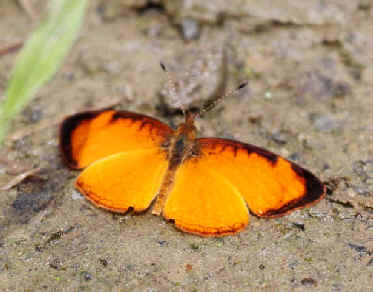
A Black-bordered Crescent photographed during a FONT
tour
(photo by Marie Gardner)
Tegosa nigrella ______ CR
GU
Tegosa nigrella nigrella ______ GU
subspecies from southern Mexico
to Honduras
Tegosa nigrella niveonotis ______ CR
(D1:29)
subspecies in Costa Rica, on the Caribbean slope
NIGRELLA CRESCENT (or
Dark Tegosa)
(Range; Guatemala & Costa Rica, locally)
Tegosa guatemalena ______ BZ
GU (MCA:88)
GUATEMALAN TEGOSA
(Range: Mexico, Guatemala, Belize)
Genus ERESIA
Eresia emerantia ______ CR PN
Eresia emerantia coela ______ CR PN
(D1:30)
subspecies
in Costa Rica and northern Panama
EMERANTIA CRESCENT
Eresia emerantia coela is a member of a color/pattern mimicry system with
Heliconius hecale along with Charonias
Eurytele (in the PIERIDAE),
Dismorphia
eunoe (in the PIERIDAE), Napeogenes peredia (in ITHOMIINI in the
NYMPHALIDAE),
and a diurnal moth.
Eresia eunice ______ CR PN
Eresia eunice mechanitis ______ CR PN
(D1:30)
subspecies from Nicaragua to Panama
Eresia eunice drypetis ______
EUNICE CRESCENT
(Range: Nicaragua to Panama)
Eresia ithomioides ______
CR
GU PN
Eresia ithomioides alsina ______ CR
GU PN
(D1:29) (MCA:86) subspecies in Nicaragua, Costa Rica, western
Panama
Eresia ithomioides eutropia
(or
melania) ______ CR PN (D1:30)
subspecies in Costa Rica, Panama, western Colombia
Eresia ithomioides poecilina ______ CR
PN(sl) (D1:30)
subspecies in Costa Rica and Panama
VARIABLE CRESCENT (or
Three-banded Crescent: E. i. alsina)
Eresia sticta ______ CR
(D1:30)
COSTA RICAN CRESCENT
(Range: Costa Rica, on the Caribbean slope, endemic)
Eresia
phillyra ______ CR GU
Eresia phillyra phillyra ______ GU
(MCA:86)
subspecies in Mexico and Guatemala
Eresia phillyra nigripennis ______ CR
(D1:29)
subspecies in Costa
Rica and possibly Panama
LONGWING CRESCENT (or
Square-tipped Crescent)
Eresia clio (or clara)
______ CR GU PN
(species
described by Linnaeus in 1758)
Eresia clio clio ______ CR GU PN
(D1:30)
(MCA:87) subspecies from southern Mexico to Bolivia and
Brazil
CLIO CRESCENT (or
Creamy Crescent)
Genus CASTILIA
Castilia eranites ______
CR
GU PN (D1:30)
(MCA:86)
MIMIC CRESCENT (or
Smudged Crescent)
(Range: southern Mexico to Venezuela)
Castilia ofella ______ CR
GU PN (D1:30)
WHITE-DOTTED CRESCENT
(Range: southern Mexico to Venezuela, also Trinidad)
Castilia myia ______ CR
GU PN (D1:30)
(MCA:87)
MAYAN CRESCENT
(Range: Mexico to Panama)
Castilia fulgora ______ CR PN
(D1:30)
FULGORA CRESCENT
(Range: Costa Rica, Caribbean slope and Cordillera Central, and western
Panama)
Castilia griseobasalis ______ CR GU
(MCA:87)
GRAY-BASED CRESCENT
(Range: Mexico to Costa Rica)
Genus JANATELLA
Janatella leucodesma ______ CR
PN(sl)
(BMCR:141) (D1:30)
WHITENED CRESCENT
(Range: Nicaragua to Venezuela, also Trinidad)
Subfamily HELICONIINAE: LONGWINGS
Mostly in the American tropics. Adults of some species are long-lived, and
several are distasteful. Various other species mimic the distasteful butterflies
of this group.
Genus PHILAETHRIA: 3 South & Central American species which breed
on Passiflora.
Philaethria diatonica (formerly
dido) ______ CR(*) HN PN(*)(sl) (BMCR:127) (D1:31) (F:194) (MCA:96)
(S:164)
NORTHERN GREEN
LONGWING (or Green Heliconian, or Scarce Bamboo Page)
(Range: Mexico to Panama)
The underside of this HELICONID
is green divided by a chocolate band. The upperside is a more vivid green,
with green bars on all wings, and green spots around the hindwing.
These butterflies generally fly high in the tree canopy, but on occasion
descend to drink and take in salts from the damp ground, and females descend
to lay eggs.
The type locality for Philaethria diatonica
was in Honduras.
Genera DIONE and AGRAULIS: 4 species (depending upon taxonomy) in Central & South America,
with one reaching into the southern US.
Typically, they have orange uppers with
stunning silver marks on the undersides of the wings.
They breed on many species
of passion flower, Passiflora.
They exploit secondary vegetation, and their
numbers increase dramatically in areas where there has been rainforest
destruction.
Dione moneta (ph) ______ CR GU(*)
HN PN
(C:267) (F:143)
Dione moneta poeyii ______ CR GU HN PN
(BMCR:125) (D1:31) (ICR:39) (K:155) (MCA:80) (PE:19)(PW:23)
subspecies from Mexico to Panama, straying north into the US
MEXICAN SILVERSPOT
(Range: southern US thru Central and South America)
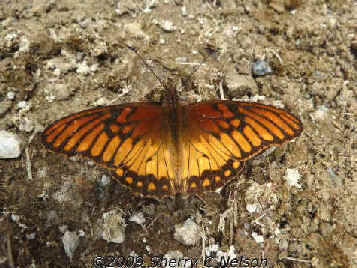
Mexican Silverspot
(photo by Sherry Nelson)
Dione juno ______ CR(*)
GU HN PN
(S:161)
Dione juno huascuma ______ CR GU
HN pb
PN
(BMCR:125) (D1:31) (ICR:38) (MCA:80) subspecies
in Mexico and Central America
JUNO LONGWING (or
Juno Heliconian)
(Range: thru Central and South
America, also the Lesser Antilles)
Dione juno
is closely related to
Dryas iulia (below, in this list). It often occurs in the same places as the very similar Gulf
Fritillary. and is said to be attracted to red and blue flowers.
Agraulis (or
Dione)
vanillae (ph) ______ CR(*) GU(*)
HN
PN (C:269) (F:144)
(K:157) (PE:19)(PW:23) (S:160) (species described by Linnaeus
in 1758)
Agraulis vanillae incarnata ______ CR
GU HN pb (AZ:121)
(BMCR:125) (D1:31) (MCA:80) subspecies
from the southwest US and Texas south through most of Central America
Agraulis vanillae vanillae ______ PN
subspecies in Panama and northern South America
GULF FRITILLARY (another common name,
Silver-spotted Flambeau)
(Range: southern US thru American
tropics to South America, also West Indies)
Agraulis vanillae
is a widespread and familiar butterfly that visits gardens to drink
nectar.
Its fiery orange upperside is distinguished from that of Dryas iulia
by
the presence of numerous black dots
on the forewing and a silver spotted underside.
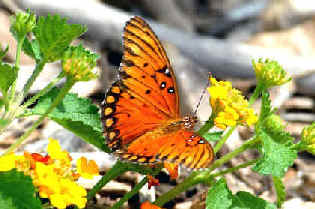
Above & below: the Gulf Fritillary, the upperside
and underside
(photo above by Howard Eskin; photo below by Sherry Nelson)
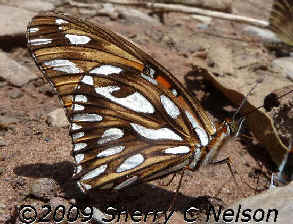
Genus DRYADULA
Dryadula phaetusa (ph) ______ CR(*)
GU HN pb PN
(BMCR:125) (D1:31) (ICR:37) (K:155) (MCA:80) (PE:19)
(species described by Linnaeus in 1758)
BANDED LONGWING
(or
Banded Orange Heliconian or
Banded Orange)
(Range: Mexico to Brazil)
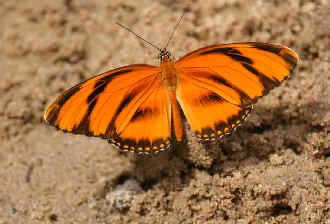
A Banded Orange Heliconian photographed during a FONT
tour
Genus DRYAS: A single migratory species represents this mostly Central &
South American genus.
Dryas iulia (ph) ______ CR(*) GU(*)
HN PN(*)
(C:301)
(F:145) (S:159)
Dryas iulia moderata ______ CR GU
HN pb
PN (BMCR:125) (D1:31) (ICR:40) (K:157) (MCA:80)
(PE:19)(PW:23) subspecies from south Texas
through Mexico and Central America, also straying further north in the US
JULIA (or
Julia Heliconian)
(Range: southern US thru American tropics to Brazil, also West Indies)
The uppersides of the elongated wings of Dryas iulia are orange, unmarked but for a
conspicuous black blob or band in the cell area of the forewing. The undersides
are a very pale brown with small white flashes.
This butterfly visits open sunny and flowery areas (often wet ground), and breeds on the passion
flower.
The female of Dryas iulia is a
dull orange with more black edging on the forewing.
Adult Julias visit many flowers for nectar, including Lantana.
The host plants on which the eggs are laid are in the genus Passiflora.
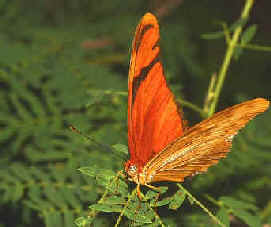
Two photos of Julia Heliconians: above a male, below a
female.
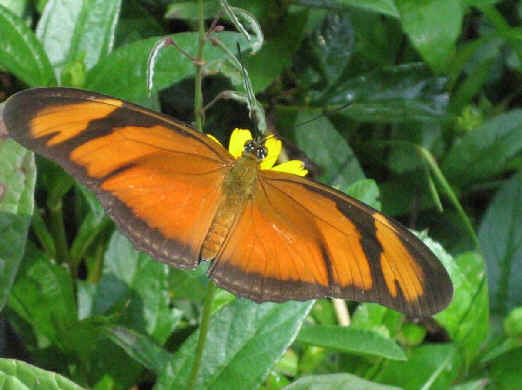
Genus EUEIDES
Eueides lineata ______
CR GU HN pb PN
(D1:31) (ICR:42) (MCA:80)
THICK-EDGED LONGWING (or
White-dotted Heliconian)
(Range: Mexico to Panama)
The preferred habitat of this uncommon Thick-edged Longwing is
middle elevation cloud forest, where it occurs along the edges of forest
openings and by roads.
A host plant for the caterpillars of Eueides
lineata is Passiflora microstipula.
Eueides lineata is one of the
smallest of the longwing butterflies, with a wingspread of 2.4 to 2.8
inches. In contrast the wingspread of the Julia (above) is up to
5.6 inches.
Eueides aliphera (ph) ______ CR GU
HN PN
(S:161)
Eueides aliphera gracilis ______ CR GU
HN pb PN
(BMCR:125) (D1:31) (MCA:80)
subspecies from
Mexico to Panama
FINE-LINED LONGWING (or
Small Julia)
(Range: Mexico to Brazil)
As indicated above, Eueides aliphera is a miniature replica of
Dryas
iulia, and so it is sometimes called the "Juliette".

Fine-lined Longwing, or the Small Julia
Eueides procula ______ CR
GU HN PN (100BM:13-c)
Eueides procula asidia ______ GU HN
(MCA:80)
subspecies from Mexico to Nicaragua
Eueides procula vulgiformis ______ CR PN
(D1:31)
subspecies in Costa Rica and Panama
DARKENED LONGWING (or
Nonpassionate Heliconian)
(Range: Mexico to Brazil)
Eueides isabella (or zoracon)
(ph)
______ BZ(*) CR(*) HN PN (K:155) (PE:20)(PW:23) (S:159)
Eueides isabella eva ______ BZ
CR HN pb PN (BMCR:126) (D1:31) (ICR:41) (MCA:80)
subspecies in eastern Mexico and Central America
ISABELLA'S LONGWING (or
Isabella's Heliconian, or
Isabella, or the
Isabella Tiger)
(Range: Mexico to the Amazon Basin, also West Indies)
In Costa Rica, the Isabella's Longwing is fairly common in the
lowlands and premontane habitats.
Host plants for the caterpillars are the passionflowers Passiflora
ambigua and Passiflora platylobia.
A feature that distinguishes the adult Isabella's Longwing from other
similar butterflies is a row of small white dots along the upper side of the
trailing edge of the hindwing.
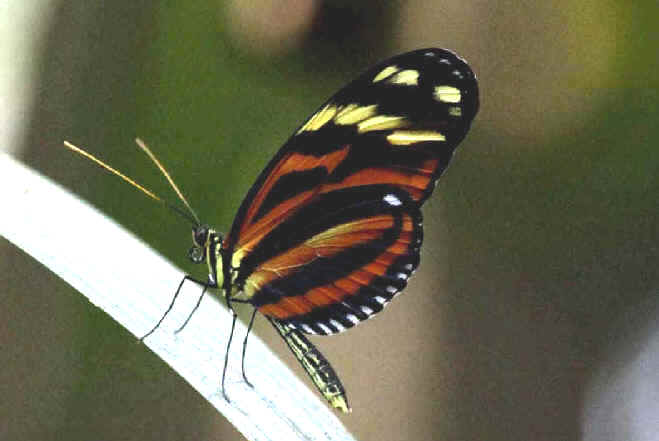
An Isabella's Heliconian photographed during a FONT
tour
(photo by Marie Gardner)
Eueides vibilia ______ CR
GU PN
Eueides vibilia vialis ______ CR GU PN
(D1:31) (MCA:80) subspecies from
Mexico to Panama
VIBILIA LONGWING (or
Acting Heliconian)
(Range: Mexico to Brazil)
Eueides lybia ______ CR PN
Eueides lybia olympia ______ CR PN
(BMCR:125)
(D1:31)
subspecies on the Caribbean slope from Nicaragua to Colombia
Eueides lybia lybioides ______ CR PN
(D1:31) subspecies
on the Pacific slope in Costa Rica and Panama
SHARP-EDGED LONGWING
(Range: Nicaragua to the Amazon Basin)
Genus HELICONIUS: LONGWINGS: Found principally in Central and South America,
reaching into the southern US. There are 15 species in Central America. The
larvae feed on members of the passion flower family, Passifloraceae. The adults
(the butterflies) are gregarious and have communal roosting spots. Adults feed
on pollen, from which they derive amino acids, enabling them to live up to nine
months. The butterflies stay very much in the same localities. They are very
noticeable and found in all types of habitats.
Heliconius (or
Laparus)
doris ______ CR(*) GU HN PN
(F:160) (S:162)
Heliconius doris viridis ______ CR
GU HN pb PN
(BMCR:127) (D1:31) (ICR:52) (MCA:81)
subspecies from Mexico to Panama
DORIS LONGWING (or
Dot-bordered Heliconian,
or
Doris Butterfly)
(Range: Mexico to the Amazon
Basin)
Heliconius (or Laparus) doris is trimorphic,
in that it occurs in 3 color varieties. Individuals of either sex can have red,
green, or blue coloration, in addition to the basic black pattern with yellow
blotches.
The butterfly occurs in forest margins and clearings.
Heliconius ismenius (ph)
______ CR(*) GU HN PN (BMCR:127)
Heliconius ismenius telchinia ______ CR GU
HN pb PN
(D1:31) (MCA:80)
subspecies from Mexico to Panama
Heliconius ismenius clarescens ______ CR PN
(D1:31) (ICR:43) subspecies in Costa Rica
and Panama
TIGER-STRIPED LONGWING (or Tiger Heliconian)
(Range: Mexico to Ecuador)
Heliconius ismenius is a member of a color/pattern mimicry system
with Dismorphia amphiona (in the PIERIDAE), Melinaea lilis or
ethra (in ITHOMIINAE in the NYMPHALIDAE), Eresia
mechanitis (in the NYMPHALIDAE), Hypothyris
euclea (in ITHOMIINAE
in the NYMPHALIDAE), and a diurnal moth.
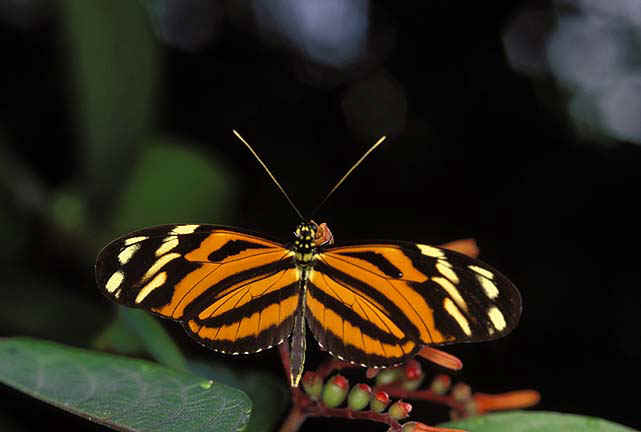
Tiger-striped Longwing
Heliconius hecale (ph) ______ CR(*) GU
HN PN
(F:160) (MCA:81)
Heliconius hecale zuleika ______
CR HN pb
(BMCR:126) (D1:31) (ICR:44) subspecies from Mexico to Panama
Heliconius hecale fornarina ______ GU
subspecies from
Chiapas, Mexico to Guatemala
Heliconius hecale discomaculatus ______ HN
subspecies in Honduras
Heliconius hecale melicerta ______ PN subspecies in Panama
and Colombia
HECALE LONGWING (or
Heart-spotted Heliconian)
(Range: Mexico thru Peruvian
Amazon)
Throughout Central and South America, Heliconius hecale has a number of races.
In Costa Rica, it is the most widespread of all the Heliconius species.
As do other longwing butterflies, Heliconius
hecale lays eggs on the leaves of passionflower plants,
including Passiflora auriculata, Passiflora filipes,
Passiflora oerstedii, Passiflora platyloba, Passiflora vitifolia.
Adult butterflies feed on the nectar of plants in the
following genera: Anguria, Gurania, Hamelia,
Lantana, Psiguriam, Psychotria.
Heliconias hecale is a member of a color/pattern mimicry system with Charonias
eurytele (in the PIERIDAE), Dismorphia eunoe (in the PIERIDAE),
Napeogenes peredia (in ITHOMIINI in the NYMPHALIDAE), Eresia
coela (in the NYMPHALIDAE), and a diurnal moth.
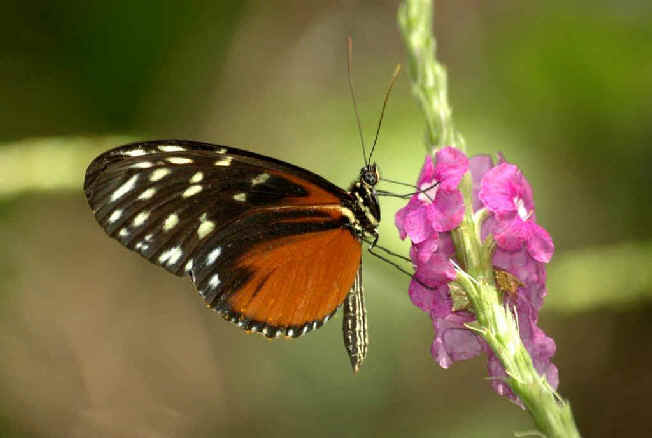
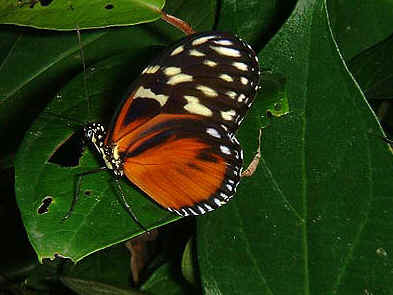
Two photos above of the Hecale Longwing, or Heart-spotted Heliconian
(upper photo by Marie Grenouillet)
Heliconius melpomene (ph)
______ CR PN(*) (C:307) (F:161) (S:162)
Heliconius melpomene rosina ______ CR PN
(BMCR:127) (D1:32) (ICR:47) subspecies in
Costa Rica and Panama
Heliconius melpomene vulcanus ______ PN
subspecies in
Panama and Colombia
MELPOMENE LONGWING (or the Postman Heliconian, or the
Postman)
(Range: Costa Rica to Brazil)
Heliconius melpomene is slightly larger than its
close relative, Heliconius erato, the Small Postman, with which it
often flies..
Many species in the Heliconius genus have
forms matching so closely that they very difficult to distinguish.
Parallel races of Heliconius melpomene and Heliconius erato mimic each other
throughout the Neotropics, sharing the same patterns in the same geographic
areas.
The length of the yellow ray can be used to differentiate the two species. It
does not reach the edge of the wing in Heliconius melpomene.
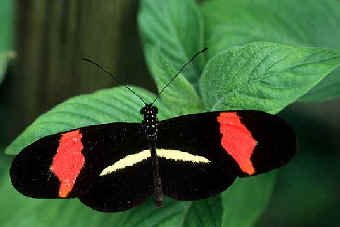
The Melpomene Longwing, or the Postman
Heliconius cydno ______
CR(*)
GU HN PN
Heliconius cydno galanthus ______ CR GU
HN pb (BMCR:126)
(D1:32) (ICR:49) (MCA:81)
subspecies from Mexico to Costa Rica
Heliconius cydno chioneus ______ CR PN
(D1:32) subspecies from southeast Costa Rica to
Colombia
CYDNO LONGWING (or
Grining Heliconian)
(Range: Mexico to Ecuador)
Host plants for the caterpillar of the Cydno Longwing
are the passionflowers Passiflora biflora
and Passiflora vitifolia.
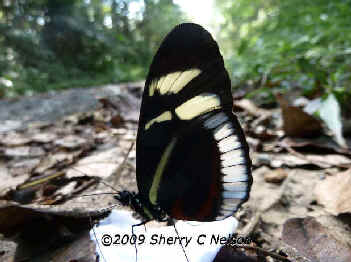
Cydno Longwing
(photo by Sherry Nelson)
Heliconius pachinus ______
CR
PN (D1:32)
PACHINUS LONGWING
(Range: Costa Rica and Panama, on the Pacific Slope)
Heliconius pachinus
is a member of a color/pattern mimicry system
with Heliconius hewitsoni and a diurnal
moth.
Heliconius erato (ph) ______
BZ(*) CR(*) GU(*) HN PN(*) (F:160)
(K:155) (MCA:81) (PE:19)
Heliconius erato petiverana ______ BZ
CR
GU HN pb PN
(BMCR:126) (D1:32) (ICR:46)
subspecies from Mexico to
Panama
Heliconius erato demophoon ______ subspecies in Nicaragua
Heliconius erato hydara ______ PN subspecies from Panama to
Brazil
Heliconius erato venus ______ PN subspecies in the Darien
region of Panama and Colombia
CRIMSON-PATCHED LONGWING (other names are
Erato Heliconian, or Small Postman)
(Range: Mexico to Argentina)
Heliconius erato flies close to the ground, along forest margins and in open
areas. It roosts communally at night.
In Costa Rica, it is the most common of the
Heliconius butterflies, visiting flowers on both the Caribbean
and Pacific sides of the country.
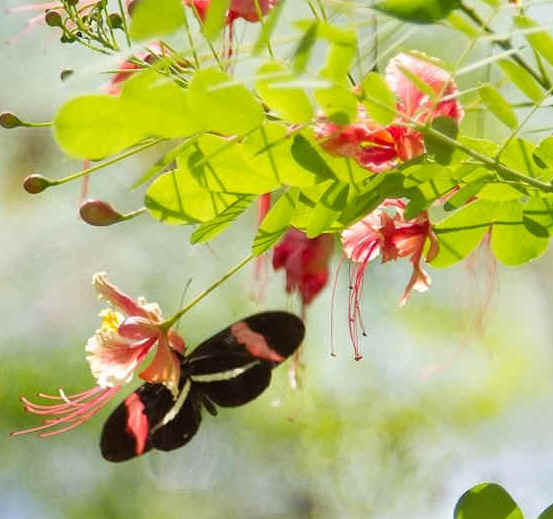
A Crimson-patched Longwing, or Erato Heliconian
Heliconius sara ______ CR
GU HN PN
(BMCR:127) (C:305) (ICR:51)
Heliconius sara fulgidus ______ CR GU PN (D1:32) subspecies
from Guatemala to Panama. on the Caribbean Slope
Heliconius sara theudela ______ CR PN
(D1:32)
subspecies in Costa Rica and Panama, on the Pacific Slope
Heliconius sara veraepacis ______ CR GU
HN pb subspecies from Mexico
to Costa Rica, on the Caribbean Slope
Heliconius sara magdalena ______ PN subspecies from Panama to
Colombia and Venezuela
SARA LONGWING
(or Sara Heliconian, or
Small Blue Grecian)
(Range: Mexico to the Amazon Basin)
Heliconius charithonia (ph)
______ CR(*) GU(*) HN PN(*) (C:303) (F:160) (K:155) (PE:19 &
PEp234)(PW:23) (S:160) (species described by Linnaeus in
1767)
Heliconius charithonia vazquezae ______ CR
GU HN pb PN (AZ:123) (BMCR:126) (D1:32)
(ICR:45) (MCA:80) subspecies in Mexico and
Central America; described in 1950; it is also said that the subspecies in
these areas is the nominate Heliconius charithonia charithonia.
ZEBRA LONGWING
(or
Zebra Heliconian, or
Zebra)
(Range: southern US thru Central and South America, also the West Indies)
Heliconius charithonia roosts in small to large clusters, adults return to the same roost night after
night.
The butterfly is very familiar to visitors of butterfly houses as it is easy to
rear.
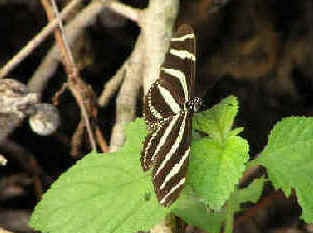
Above & below: 2 photos of the Zebra Longwing
during FONT tours
in Guatemala
(the upper photo in Guatemala by Doug Johnson;
the lower photo by Marie Gardner)
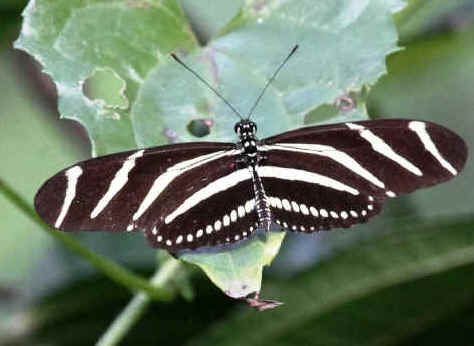
Heliconius hecalesia ______ CR
GU HN PN
Heliconius hecalesia octavia ______ GU
HN pb subspecies
from Mexico to Nicaragua
Heliconius hecalesia formosus ______ CR PN
(BMCR:127)
(D1:32)
subspecies in Costa Rica and Panama
FIVE-SPOTTED LONGWING
(Range: Mexico to Venezuela)
Heliconius clysonymus ______
CR(*) PN(*)
Heliconius clysonymus montanus ______ CR PN (BMCR:126) (D1:32)
(ICR:48)
subspecies in Costa Rica and Panama
MONTANE LONGWING (or
Yellow-patch Longwing)
(Range: Costa Rica to Ecuador)
In Costa Rica, Heliconius clysonymus
occurs from premontane to montane levels in the mountains.
Host plants for the caterpillars are
Passiflora apetala and Passiflora
biflora.
Adult butterflies go to plants in the genera Gurania
and Psiguria.
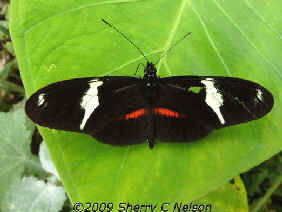
Montane Longwing
(photo by Sherry Nelson)
Heliconius sapho ______ CR GU
HN
Heliconius sapho leuce ______ CR GU
HN pb (BMCR:127)
(D1:32)
subspecies from Mexico to Costa Rica, on the Caribbean Slope
SAPHO LONGWING
(Range: Mexico to Ecuador)
Heliconius hewitsoni ______ CR
PN (D1:32)
HEWITSON'S LONGWING
(Range: Costa Rica and Panama, on the Pacific Slope)
Heliconius hewitsoni
is a member of a color/pattern mimicry system
with Heliconius pachinius and a diurnal moth.
Heliconius eleuchia ______ CR
Heliconius eleuchia eleuchia ______ CR
(BMCR:126)
(D1:32) (ICR:50) subspecies from Costa Rica to
Colombia
WHITE-EDGED LONGWING
(Range: Costa Rica to Ecuador)
In Costa Rica, Heliconius eleuchia
occurs in the foothills of the Caribbean slope, (in the area of the La Virgen de
la Socorro canyon).
Passiflora tica is thought to be a host
plant (or the host plant) for the caterpillar of the White-edged
Longwing.
Heliconius hortense ______ GU
HN (MCA:81)
MEXICAN LONGWING (or Mexican Heliconian)
(Range: Mexico to Honduras)
Heliconius ethilla ______ PN
Heliconius ethilla claudia ______ PN
subspecies in
Panama
TAWNY-STRIPED
LONGWING
Subfamily HELICONIINAE, Tribe
ARGYNNINI
Genus EUPTOIETA
Euptoieta claudia (ph) ______ (AZ:125)
(D1:32) (K:157) (MCA:79) (PE:3 & 20
& PEp:235)(PW:23)
VARIEGATED FRITILLARY
(Range: Canada south into Central America, also the West Indies)
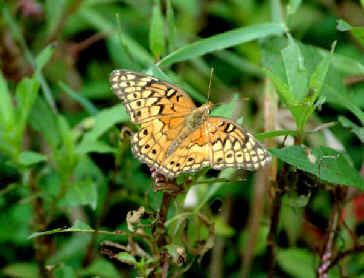
Variegated Fritillary
Euptoieta hegesia
(or
hoffmanni)
(ph) ______ CR GU(*) HN PN
(K:157) (PE:29)(PW:23)
Euptoieta hegesia meridiania ______ CR GU
HN pb PN (AZ:127) (D1:32) (MCA:79)
subspecies from south Texas to Argentina, also as a stray further north in
the US
MEXICAN FRITILLARY
(Range: southern US thru Central America, also the West Indies)
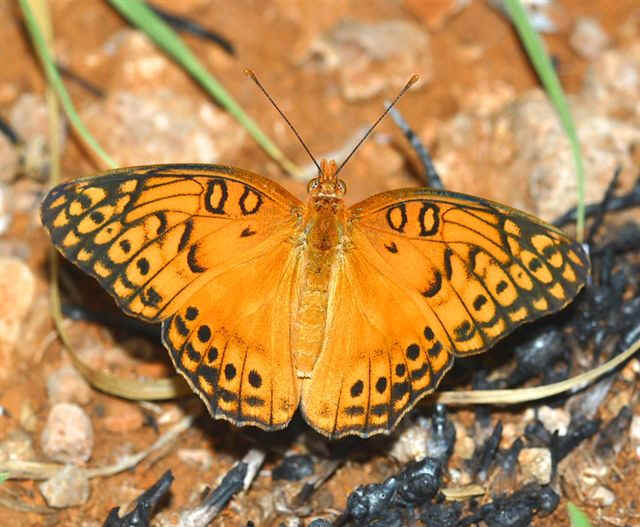
Mexican Fritillary
Subfamily HELICONIINAE,
Tribe ACRAEINI
Genus ALTINOTE
and
ACTINOTE
Altinote ozomene (or leucomelas) (ph) ______
CR GU HN PN
Altinote ozomene nox ______ CR GU
HN PN
(D1:32)
subspecies from Mexico to Panama
LAMPLIGHT ACTINOTE
(Range: Mexico to Panama)
Sometimes in Costa Rica Altinote ozomene
(or leucomelas) is extremely common due to mass emergences. Females approaching Inga flowers in the canopy are often seen being
"dive-bombed" by males.

Lamplight Actinote
(photo by Sherry Nelson)
Actinote anteas ______ CR
GU HN PN (BMCR:130)
(D1:32) (ICR:53) (MCA:78)
ANTEAS ACTINOTE (or
Doubleday's Actinote)
(Range: Mexico to Venezuela)
Actinote anteas is a member of a color/pattern mimicry system with
a diurnal moth.
And it is also similar to distasteful longwing butterfly species
including those in the Eueides genus
and Heliconius ismenius.
Two other species of butterflies are similar to Actinote
anteas that are not distasteful, in the Castilia
and Eresia genera.
Actinote anteas feeds on the nectar
of plants in the Lantana and Asclepias
(or Milkweed) genera.
Actinote melampeplos ______ CR
(D1:32)
BOW-WINGED ACTINOTE
(Range: in southern Mexico, Costa Rica, Ecuador)
Actinote lapitha ______ CR
GU PN
Actinote lapitha calderoni ______ GU
subspecies from Chiapas,
Mexico to El Salvador
Actinote lapitha lapitha ______ CR GU PN (D1:32)
subspecies from Mexico to Panama
PALE ACTINOTE
(Range: Mexico to Costa Rica and western Panama)
Actinote guatemalena ______ CR
GU HN
(MCA:78)
Actinote guatemalena guatemalena ______ CR GU
HN (BMCR:130)
(D1:32) subspecies from Chiapas, Mexico to Costa Rica
GUATEMALAN ACTINOTE
(Range: Guatemala to Costa Rica)
Subfamily DANAINAE: MILKWEED BUTTERFLIES
Genus ANETIA
Anetia thirza ______ CR
GU HN PN
Anetia thirza thirza ______ GU HN (MCA:141)
subspecies from Mexico to El
Salvador
Anetia thirza insignis ______ CR PN (BMCR:180) (D1:33)
subspecies in Costa Rica and Panama
CLOUD-FOREST KING (or
Cloud-forest Monarch)
(Range: Mexico to Panama)
Genus LYCOREA: a group of HELICONID MIMICS
which have long wings, long bodies,
and share similar patterns.
Lycorea ilione ______ CR
GU HN PN
Lycorea ilione albescens ______ CR GU
HN PN
(BMCR:180)
(D1:33) (MCA:141)
subspecies from southern Mexico to Panama
CLEARWING MIMIC-QUEEN
(Range: Mexico to Brazil)
Lycorea halia (or
Lycorea cleobaea)
(ph) ______ CR GU
HN PN (F:176) (100C:50-c) (K:155) (PE:27)
(S:187)
Lycorea halia atergatis ______ CR GU
HN pb PN
(BMCR:180) (D1:33)
(MCA:141) subspecies from Mexico to Colombia
TIGER MIMIC-QUEEN (or
Large Tiger)
(Range: Mexico to Peru; also in the West Indies)
The Tiger Mimic-Queen is larger than true HELICONIDS. It
occurs in wood and scrub habitats.
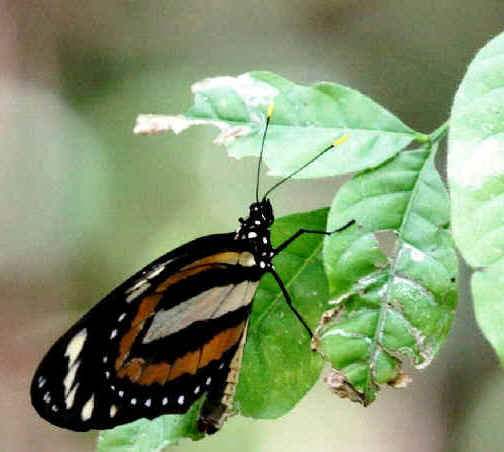
A Tiger Mimic-Queen photographed during a FONT
tour
(photo by Marie Gardner)
Genus DANAUS: ROYALTY: Known also as TIGER BUTTERFLIES. There are
representatives in all geographical regions of the world. More species occur in
the Old World, but one of the best known butterflies of the New World is D.
plexippus, the Monarch. Larvae of this genus feed on members of the milkweed and
dogbane families, and render themselves poisonous to predators by storing plant
poisons. There are many other butterflies that mimic the toxic members of this
genus.
Danaus plexippus (ph) ______ CR(*) GU(*)
HN PN(*)
(AZ:225) (C:37) (F:143) (K:227) (MCA:141) (PE:3,4,27) (S:184) (100BM:28-c)
Danaus plexippus plexippus ______ CR
GU HN pb PN (BMCR:180)
(D1:33) subspecies in North and Central America
MONARCH
(Range: a truly cosmopolitan species, occurring in North
and South America, Australia, and the East Indies.)
The Monarch is a very strong flier with
strong migratory tendencies in temperate regions, but not so in the tropics where
it is also usually a solitary flier.
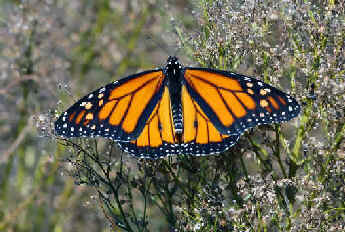
A Monarch
(photo by Howard Eskin)
Danaus gilippus (ph) ______ CR(*) GU(*)
HN PN(*)
(AZ:227)
(F:143) (K:229) (MCA:141) (PE:27) (S:183)
Danaus gilippus thersippus ______ CR
GU HN PN (BMCR:180) (D1:33)
subspecies from the US to Colombia
QUEEN
(Range: southern US to Colombia; also in the
West Indies)
The Queen is not as heavily marked with black as Danaus
plexippus, the Monarch.
Danaus gilippus is not a migrant species.

A Queen
(photo by Howard Eskin)
Danaus eresimus (ph) ______
CR GU(*) HN PN (AZ:229)
(C:283) (F:142) (K:229) (MCA:141) (PE:27)
Danaus eresimus montezuma ______ CR GU
HN pb PN (BMCR:180) (D1:33) subspecies from Texas to
Colombia, as a stray further north, described in 1943
SOLDIER
(Range: southern US to the Amazon Basin, also in the Antilles)
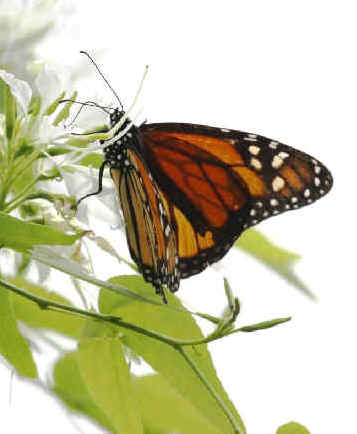
A Soldier photographed during a FONT tour
(photo by Marie Gardner)
Subfamily ITHOMIINAE
this highly diverse group has been considered as a
separate family, or (now by most) as a subfamily of NYMPHALIDAE.
Genus EUTRESIS
Eutresis dilucida ______ CR PN
(D1:33)
SMOKY TIGERWING
(Range: Costa Rica and western Panama)
Eutresis hypereia ______
Eutresis hypereia theope ______
(D1:33) subspecies in Costa Rica and Panama
CRISP TIGERWING
(Range: Costa Rica to Ecuador)
Genus OLYRAS:
3 species found in Central & South America
Olyras crathis ______
Olyras crathis staudingeri ______ (D1:33)
subspecies in Costa Rica and Panama
CRATHIS TIGERWING
(Range: Costa Rica to Ecuador)
Olyras insignis ______ CR PN
Olyras insignis insignis ______ CR PN (D1:33)
subspecies in Costa Rica and Panama
INSIGNIS TIGERWING
(Range: Costa Rica to Ecuador)
Olyras theon ______ GU
(MCA:144)
RUSTY TIGERWING (or Rusty Ticlear)
(Range: southeast Mexico and Guatemala)
Genus TITHOREA: a Neotropical genus of about 15 species
Tithorea tarricina ______ CR
GU HN PN (100BM:14-c)
Tithorea tarricina duenna ______ GU (MCA:144) subspecies in southeast
Mexico and Guatemala
Tithorea tarricina pinthias ______ CR HN pb PN
(BMCR:184) (D1:34)
(F:207) subspecies from
Honduras to Panama
CREAM-SPOTTED TIGERWING (or Variable Prestonian)
(Range: Mexico to Brazil)
Tithorea harmonia ______ CR
GU HN PN
(C:367) (MCA:144) (S:180)
Tithorea harmonia salvadoris ______ GU HN subspecies from
Mexico to Honduras and El Salvador
Tithorea harmonia hippothous ______ GU subspecies in southeast
Mexico and Guatemala
Tithorea harmonia helicaon ______ CR PN (D1:34)
subspecies
from Nicaragua to Panama
Tithorea harmonia irene ______ PN subspecies in Panama and
Colombia
HARMONIA TIGERWING (other
names have also been
Black-fronted Prestonian, the
Harmonius Tiger-Clearwing, the
Tiger Butterfly,
or the
Tiger)
(Range: Mexico to Brazil)
Tithorea pacifiica ______ PN
Tithorea pacifica concordia
______ PN subspecies in eastern Panama
PACIFIC TIGERWING
Genus AERIA
Aeria eurimedia ______ CR
GU HN PN
Aeria eurimedia pacifica ______ CR GU HN PN (BMCR:182)
(D1:35) (MCA:144) subspecies from southeast Mexico
to Costa Rica and Panama
Aeria eurimedia agna ______ PN subspecies from Panama to northwest
Venezuela
BANDED TIGERWING (or Black-and-yellow Prestonian)
(Range: Mexico to Colombia)
Genus THYRIDIA
Thyridia psidii ______ CR
GU HN PN
Thyridia psidii melantho ______ CR GU HN pb PN (D1:34) (MCA:144)
subspecies from Mexico to Panama
MELANTHO TIGERWING (or Clapping Ticlear)
(Range: Mexico to the Amazon Basin)
Genus METHONA
Methona confusa ______ PN
CONFUSA TIGERWING
(Range: Panama)
Genus MELINAEA: Central & South American butterflies similar in appearance
to HELICONIUS. However, they have smaller compound eyes, and androconial hairs
between their wings. There are 3 species known in Central America. Butterflies
occur in many forested habitats up to 5,000 ft.
Melinaea scylax ______ (D1:34)
SCYLAX TIGERWING
(Range: Costa Rica to Colombia, on the Pacific Slope)
Melinaea lilis (ph) ______ HN
(F:179)
(S:181)
Melinaea lilis imitata ______ HN (D1:34
as Melinaea ethra lilis) subspecies
from Mexico to Costa Rica, on the Caribbean Slope
Melinaea lilis parallelis ______ subspecies in southeast
Costa Rica and Panama, on the Caribbean Slope
MIMIC TIGERWING (other names have been
Heliconoid Ticlear
or
Mechanitis Mimic; also called the Army Ant Butterfly)
(Range: southern Mexico to western Panama)
Melinaea lilis
has the yellow, black, and orange coloration of the "tiger-stripe"
mimicry complex.
It lives in open flowery areas, and visits flowers for nectar.
Melinaea lilis (or ethra) is a member of a color/pattern mimicry
system with Heliconius ismenius (in the NYMPHALIDAE), Dismorphia
amphiona (in the PIERIDAE), Hypothyris euclea (in ITHOMIINAE
in the NYMPHALIDAE), Eresia mechanitis (in the NYMPHALIDAE),
and a diurnal moth.
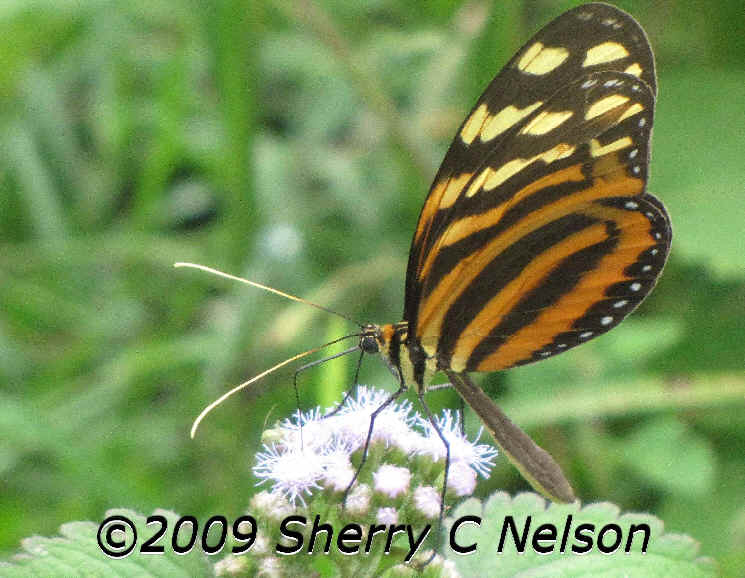
Mimic Tigerwing
(photo by Sherry Nelson)
Melinaea idae ______
Melinaea idae idae ______ (subspecies in Panama & Colombia)
IDAE TIGERWING
Genus MECHANITIS
Butterflies in this genus fly in bright sunlight, attracted to flowers.
Mechanitis polymnia ______
CR(*) GU HN PN (C:369)
(S:180) (100BM:41-c)
Mechanitis polymnia lycicice ______ GU HN pb subspecies from southeast
Mexico to Honduras
Mechanitis polymnia isthmia ______
CR PN (BMCR:184) (D1:34) subspecies in
Costa Rica and Panama
POLYMNIA TIGERWING (or
Disturbed Tigerwing)
(Range: Mexico to the Amazon Basin)
Mechanitis polymnia frequents more disturbed habitats than most ithomiine butterflies, it is
said to fly commonly along the streets of the cities and towns of Costa Rica.
Mechanitis lysimnia ______ HN
(BMCR:184) (D1:34)
Mechanitis lysimnia utemaia ______ HN pb
subspecies from Mexico to Costa Rica
Mechanitis lysimnia labotas ______ subspecies in Costa Rica
Mechanitis lysimnia macrinus ______ subspecies in Panama and
Colombia
LYSIMNIA TIGERWING
(Range: Mexico to Venezuela)
Mechanitis menapis ______ HN
Mechanitis menapis doryssus ______ subspecies in southeast
Mexico and Guatemala
Mechanitis menapis saturata ______ HN pb (BMCR:184) (D1:34) subspecies from
Honduras to Panama
Mechanitis menapis dariensis ______ subspecies in Panama, described in
1977
MENAPIS TIGERWING
(Range: Mexico to Ecuador)
Genus SCADA
Scada zibia ______
Scada zibia xanthina ______ PN
(sl) (BMCR:184) (D1:34) (subspecies from
Nicaragua to Panama)
ZIBIA TIGERWING
(Range: Nicaragua to Peru)
Genus HYALIRIS: South & Central American butterflies that have
characteristic "GLASSY-WINGS".
Hyalyris excelsa ______
Hyalyris excelsa decumana ______
(BMCR:183) (D1:34)
(subspecies in Costa Rica & Panama)
EXCELSA TIGERWING
(Range: Costa Rica to Peru)
Genus HYPOTHYRIS
Hypothyris lycaste ______ HN
Hypothyris lycaste dionaea ______ HN pb subspecies in southeast Mexico,
Guatemala, Honduras
Hypothyris lycaste callispila ______ (D1:34)
subspecies in Costa Rica and Panama
Hypothyris lycaste lycaste ______ subspecies in Panama and
Colombia
LYCASTE TIGERWING
(Range: Mexico to Colombia)
Hypothyris euclea ______ HN
Hypothyris euclea valora ______ GU(*)
HN (BMCR:183) (D1:34) subspecies
from Mexico to Panama
EUCLEA TIGERWING (or
Common Ticlear)
(Range: Mexico to Brazil)
Hypothyris euclea is a member of a color/pattern mimicry system
with Heliconius ismenius (in the NYMPHALIDAE), Dismorphia
amphiona (in the PIERIDAE), Melinaea lilis (or
ethra)
(in ITHOMIINAE, in the NYMPHALIDAE), Eresia mechanitis
(in the NYMPHALIDAE), and a diurnal moth.
Genus NAPEOGENES
Napeogenes peredia ______
Napeogenes peredia hemisticta ______ (D1:34)
(subspecies in Costa Rica)
Napeogenes peredia hemimelanea ______ (subspecies in Panama)
PERIDIA TIGERWING
(Range: Costa Rica to Colombia)
Napeogenes peredia is a member of a color/pattern mimicry system
with Heliconius hecale along with Charonias eurytele (in
the PIERIDAE), Dismorphia eunoe (in the PIERIDAE), Eresia
coela (in the NYMPHALIDAE), and a diurnal moth.
Napeogenes tolosa ______ HN
Napeogenes tolosa tolosa ______ HN (MCA:144) subspecies in southeast Mexico,
Guatemala, Honduras
Napeogenes tolosa amara ______ (D1:34)
subspecies from Nicaragua to Panama
Napeogenes tolosa mombachoensis ______ subspecies in Nicaragua, described in
1997
TOLOSA TIGERWING (or Tollhouse Ticlear)
(Range: Mexico to Colombia)
Napeogenes cranto ______
Napeogenes cranto paedaretus ______ (D1:34)
(subspecies in Costa Rica & Panama)
Napeogenes cranto reali ______ (subspecies in Panama, described in 1968)
CRANTO TIGERWING
(Range: Costa Rica to Peru)
Napeogenes stella ______ (segregate of the species in Panama)
STELLA TIGERWING
Genus ITHOMIA
Ithomia jacunda ______
Ithomia jacunda bolivari ______ (D1:35)
(subspecies from Nicaragua to Panama, on the Caribbean Slope)
Ithomia jacunda jacunda ______ (subspecies in Panama)
JACUNDA CLEARWING
(Range: Costa Rica & Panama)
Ithomia leila ______ (MCA:142)
LEILA'S CLEARWING (or Leila's Ithomia)
(Range: southeast Mexico & Guatemala)
Ithomia celemia ______
Ithomia celemia plaginota ______ (D1:35)
(subspecies in Costa Rica & Panama)
CELEMIA CLEARWING
(Range: Costa Rica to Venezuela)
Ithomia diasa ______
Ithomia diasa hippocrenis ______
(BMCR:183) (D1:35)
(subspecies from Nicaragua to Panama)
Ithomia diasa galata ______ (subspecies in Panama & Colombia)
DIASA CLEARWING
(Range: Nicaragua to Colombia)
Ithomia heraldica ______ CR(*)
(BMCR:183) (D1:35)
HERALDICA CLEARWING
(Range: Costa Rica & Panama)
Ithomia patilla (ph) ______ HN
pb (BMCR:183)
(D1:35) (MCA:142)
PATILLA CLEARWING (or
Guatemalan Ithomia)
(Range: Mexico to Panama)
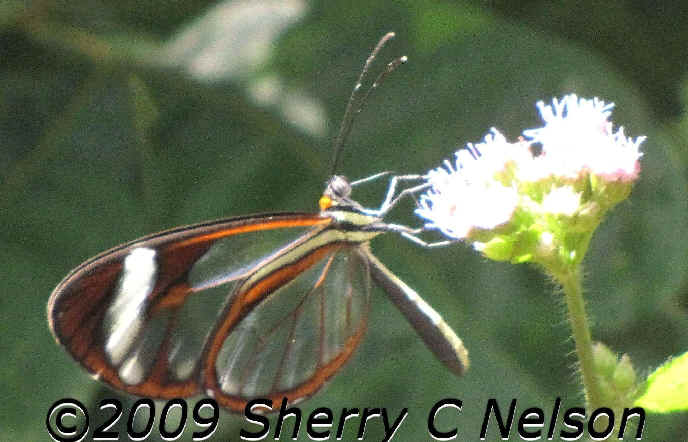
Patilla Clearwing
(photo by Sherry Nelson)
Ithomia terra ______
Ithomia terra vulcana ______
(D1:35)
(subspecies in Costa Rica & Panama)
TERRA CLEARWING
(Range: Costa Rica to Bolivia)
Ithomia xenos ______ (D1:35)
XENOS CLEARWING
(Range: Costa Rica & Panama)
Ithomia hyala ______
HYALA CLEARWING
(Range: Costa Rica & Panama)
Ithomia iphianassa ______
Ithomia iphianassa panamensis
______ (subspecies in Panama)
IPHINASSA CLEARWING
Genus HYPOSCADA
Hyposcada virginiana ______ HN
PN
Hyposcada virginiana virginiana ______ HN (MCA:144)
subspecies from
southeast Mexico to Honduras
Hyposcada virginiana evanides ______ PN sl
(D1:35)
subspecies from Nicaragua to Panama
Hyposcada virginiana adelphina ______ subspecies in Panama
VIRGINIANA CLEARWING (or
Virginia's Ticlear)
(Range: Mexico to Colombia)
Hyposcada anchiala ______ (segregate of the species in Panama)
ANCHIALA CLEARWING
Hyposcada illinissa ______
Hyposcada illinissa aesion ______
(subspecies in Panama)
ILLINISSA CLEARWING
Genus OLERIA
Oleria paula ______ HN
PN sl (D1:35) (MCA:143)
PAULA'S CLEARWING (or Paula's Oleria)
(Range: Mexico to Panama)
Oleria paula is a member of a color/pattern mimicry system with Dismorphia
theucharila (in the PIERIDAE) and a diurnal moth: Dysschemia
jansonius, the male.
Oleria rubescens ______ (BMCR:184)
(D1:35)
RUBESCENS CLEARWING
(Range: Nicaragua to Panama)
Oleria vicina ______ (BMCR:184)
(D1:35)
VICINA CLEARWING
(Range: Costa Rica & western Panama)
Oleria zelica ______
Oleria zelica pagasa ______ PN(sl)
(D1:35) (subspecies in Costa Rica & Panama)
ZELICA CLEARWING
(Range: Costa Rica to Ecuador)
Oleria makrena ______ (segregate
of the species in Panama)
MAKRENA CLEARWING
Oleria thiemei ______
THIEME'S CLEARWING
(Range: Panama & Colombia)
Oleria zea ______ HN
Oleria zea zea ______ HN (MCA:143)
subspecies from southeast Mexico to Honduras
ZEA CLEARWING (or Bar-celled Oleria)
(Range: Mexico to Honduras and El Salvador)
Genus CALLITHOMIA
Callithomia hezia ______ (BMCR:182)
(D1:35) (MCA:144)
Callithomia hezia hezia ______ subspecies from Mexico to
Honduras
Callithomia hezia hedila ______ HN pb subspecies in southeast Mexico,
Guatemala, and Honduras
Callithomia hezia smalli ______ subspecies in Panama, described
in 1968
HEZIA CLEARWING (or
White-leading Ticlear)
(Range: Mexico to Colombia)
Callithomia alexirrhoe (formerly
hydra)
______
Callithomia alexirrhow megaleas ______
(D1:35) (subspecies in Costa Rica)
Callithomia alexirrhow panamensis ______ (subspecies in Panama)
ALEX'S CLEARWING
(Range: Costa Rica to Colombia)
Callithomia lenea ______
Callithomia lenea agrippina
______ (subspecies in Panama & Colombia)
LENEA CLEARWING
Genus CERATINIA
Ceratinia tutia ______ HN
Ceratinia tutia dorilla ______ HN (D1:35) (MCA:144)
subspecies from Mexico to Panama
TUTIA CLEARWING (or Yellow-tipped Ticlear)
(Range: Mexico to the Amazon Basin)
Genus DIRCENNA
Dircenna jemina ______ HN
Dircenna jemina (northern segregate) ______
HN
(MCA:144)
subspecies from eastern Mexico to Panama
Dircenna jemina chiriquensis ______ (D1:35) subspecies in Costa Rica and Panama, on the Pacific
Slope
JEMINA CLEARWING (or Geyer's Dircenna)
(Range: Mexico to Panama)
Dircenna dero ______ HN
Dircenna dero (northern segregate) ______ HN pb (MCA:144)
subspecies in
southeast Mexico, Guatemala, Honduras)
Dircenna dero euchytma ______ CR(*) (BMCR:182) (D1:35) (subspecies
from Nicaragua to Venezuela)
DERO CLEARWING (or
Big-bordered Dircenna)
(Range: Mexico to Brazil)
Dircenna klugii ______ CR(*)
HN
(BMCR:182) (D1:35) (MCA:144) (PE:27)
KLUG'S CLEARWING (or
Klug's Dircenna)
(Range: Mexico to Panama, as a stray to south Texas)
Dircenna olyras ______
Dircenna olyras relata ______ (BMCR:182)
(D1:35) (subspecies
from
Nicaragua to Panama)
OLYRAS CLEARWING
Genus GODYRIS
Godyris zavaleta ______ HN
Godyris zavaleta sesunga ______ HN pb (MCA:144) subspecies from southeast
Mexico to Nicaragua
Godyris zavaleta caesiopicta (or
sorites) ______
(BMCR:183) (D1:35) subspecies in Costa Rica
and Panama, on the Caribbean Slope
Godyris zavaleta zygia ______ (D1:36)
subspecies in Costa Rica and Panama, on the Pacific Slope
VARIEGATED CLEARWING (or Variegated
Ticlear)
(Range: Mexico to Ecuador)
Godyris nero (was Greta nero) ______
CR HN PN(sl) (D1:36) (MCA:142)
NERO CLEARWING (other names are Nero Glasswing
or Fiddler's Ticlear)
(Range: Mexico to Costa Rica)
Godyris kedema ______
Godyris kedema furina
______ (subspecies in Panama)
KEDEMA CLEARWING
Genus GRETA
Greta polissena ______
Greta polissena umbrana ______ (D1:36)
(subspecies in Costa Rica & Panama)
POLISSENA CLEARWING
(Range: Costa Rica to Brazil)
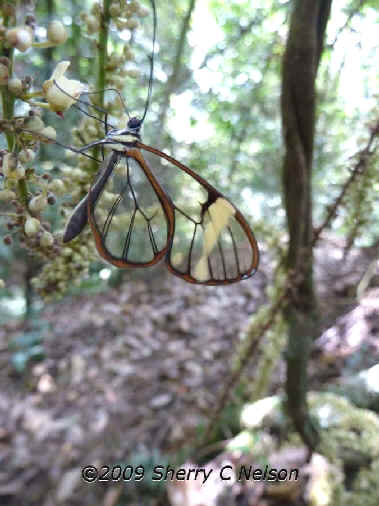
Polissena Clearwing
(photo by Sherry Nelson)
Greta andromica ______ HN (MCA:142)
Greta andromica lyra ______ HN (BMCR:182)
(C:371)
(D1:36)
subspecies from Mexico to Panama
ANDROMICA CLEARWING (or
Curvy-veined Greta)
(Range: Mexico to Peru)
Greta annette (ph) ______ HN
(MCA:142)
Greta annette annette ______ HN (MCA:142) subspecies in eastern Mexico,
Guatemala, Honduras
Greta annette championi ______ (BMCR:182)
(D1:36) subspecies from Nicaragua to Panama, subspecies described in
1978
WHITE-SPOTTED CLEARWING (or
White-spotted Greta)
(Range: Mexico to Panama)
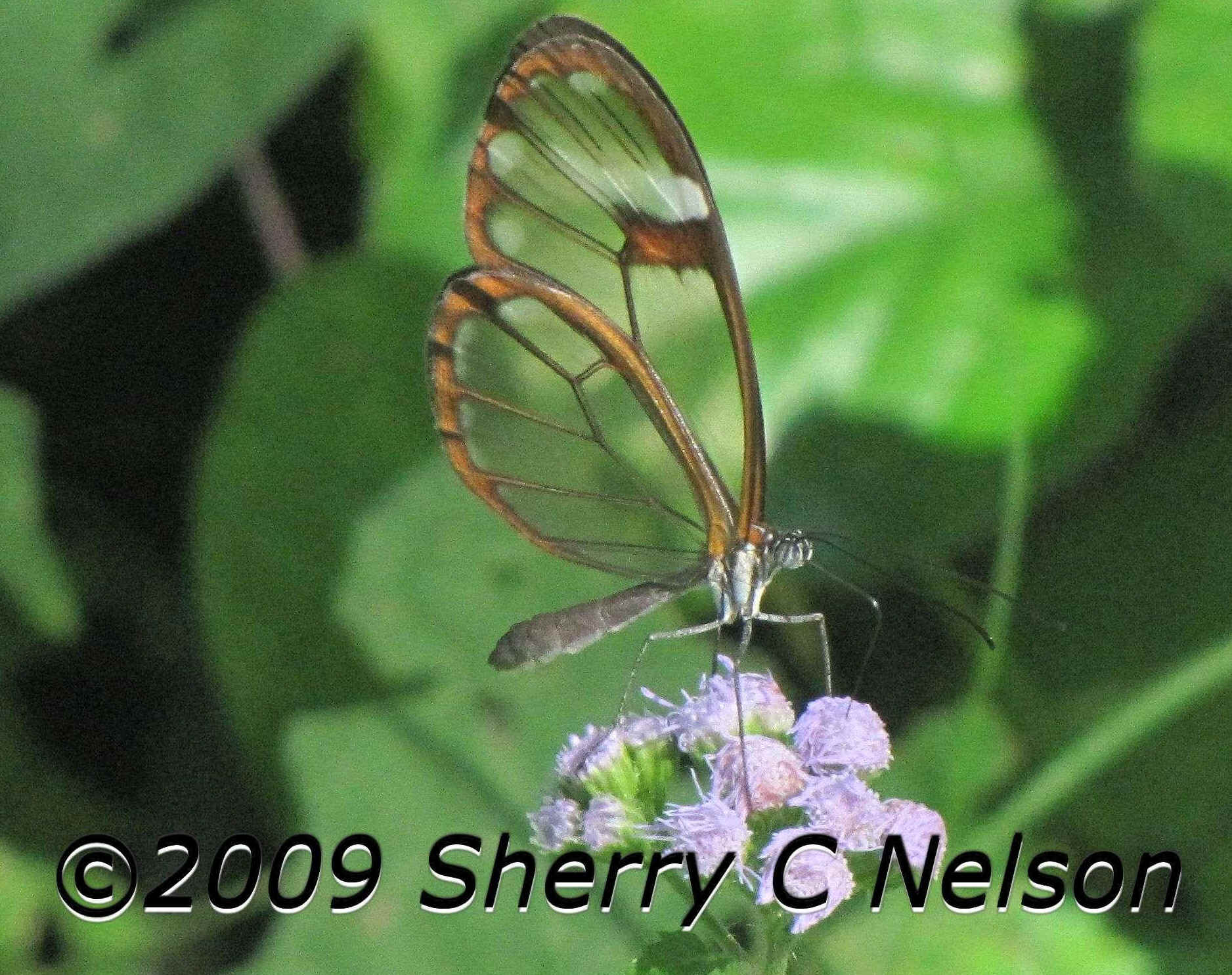
White-spotted Clearwing
(photo by Sherry Nelson)
Greta morgane (ph) ______ CR GU(*) HN PN (MCA:142)
(100BM:95-c)
Greta morgane oto ______ CR GU(*)
HN PN
(BMCR:182) (D1:36) (MCA:142) subspecies from eastern Mexico to
Panama
RUSTY CLEARWING (or
Thick-tipped Greta or
Oto Glasswing)
(Range: Mexico to Panama)
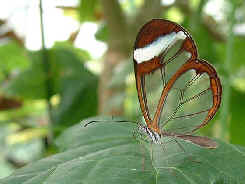
Rusty Clearwing, or Thick-tipped Greta
Greta gabiglooris ______ (species described in 2005)
GABI'S CLEARWING
(Range: Nicaragua to western Panama)
Another Greta sp. has recently been
discovered in Costa Rica.
Genus HYPOLERIA
Hypoleria lavinia ______ HN
Hypoleria lavinia cassotis ______ HN pb (MCA:142) subspecies from Mexico to
Honduras
Hypoleria lavinia rhene ______
(BMCR:183) (D1:36) subspecies
from Nicaragua to western Panama
Hypoleria lavinia liberia ______ subspecies in Panama
Hypoleria lavinia vanilia ______ subspecies in Panama and
Colombia
LAVINIA CLEARWING (or Fuzzy-spotted Ticlear)
(Range: Mexico to Panama)
Genus PSEUDOSCADA
Pseudoscada timna
(formerly
utilla)
______
Pseudoscada timna pusio ______ (BMCR:184) (D1:36)
(subspecies from Nicaragua to Panama)
Pseudoscada timna saturata ______ (subspecies in Panama &
Colombia)
TIMNA CLEARWING
(Range: Nicaragua to Colombia)
Genus HYALENNA
Hyalenna alidella ______
Hyalenna alidella exsulans
______ (subspecies in the Darien region of
Panama, described
in 2006)
ALIDELLA CLEARWING
Genus EPISCADA
Episcada salvinia ______ HN
Episcada salvinia salvinia ______ HN (MCA:143) (subspecies in eastern
Mexico and Guatemala)
Episcada salvinia opleri ______
(D1:36) (subspecies in Costa Rica & Panama, described in 1978)
SALVIN'S CLEARWING (or
Salvin's Ticlear)
(Range: Mexico to Panama)
Genus PTERONYMIA
Pteronymia alcmena ______ HN (MCA:143)
ALCEMA CLEARWING (or Guatemalan Clearwing)
(Range: Mexico to Panama)
Pteronymia aletta ______
Pteronymia aletta agalla ______ (D1:36)
(subspecies in Costa Rica & Panama, on the Pacific Slope)
ALETTA CLEARWING
(Range: Costa Rica & Panama)
Pteronymia artena ______ CR HN
Pteronymia artena artena ______ CR(*)
HN
(C:375) (D1:36) (MCA:143) subspecies from Mexico to Panama
ARTENA CLEARWING (or
POINTED CLEARWING)
(Range: Mexico to Peru, also Trinidad)
The Pointed Clearwing is common in many forests, up to 6,000ft. Its larval host plants are woody
vines called lianas, common in the tropical canopy.
Pteronymia cotytto ______ GU(*)
HN pb
(D1:36) (MCA:143)
COTYTTO CLEARWING
(or
BROAD-TIPPED CLEARWING)
(Range: Mexico to Panama)
Pteronymia donella ______
Pteronymia donella donata ______ (D1:36)
(subspecies in Costa Rica & Panama)
DONELLA CLEARWING
Pteronymia picta ______
Pteronymia picta notilla ______ (D1:36)
(subspecies in Costa Rica & Panama)
PICTA CLEARWING
(Range: Costa Rica to Colombia)
Pteronymia latilla ______
Pteronymia latilla fulvescens ______ (D1:36)
(subspecies in Costa Rica & western Panama)
LATILLA CLEARWING (or
FULVOUS CLEARWING)
Pteronymia fulvimargo ______ (D1:36)
FULVIMARGO CLEARWING
(Range: Costa Rica and western Panama)
Pteronymia parva ______
(D1:36) (MCA:143)
PARVA CLEARWING (or
FOUR-SPOTTED CLEARWING)
(Range: Costa Rica and Panama)
Pteronymia fumida ______
Pteronymia fumida fumida ______
(D1:36) (subspecies in Costa Rica & Panama)
FUMIDA CLEARWING
(Range: Costa Rica to Colombia)
Pteronymia simplex ______ HN
Pteronymia simplex fenochioi ______ HN
(MCA:143)
(subspecies from eastern Mexico
to Nicaragua, described in 1978)
Pteronymia simplex simplex ______ (D1:36)
(subspecies in Costa Rica & Panama)
SIMPLE CLEARWING
(Range: Mexico to Panama)
Pteronymia lonera ______
(D1:36)
LONERA CLEARWING
(Range: Costa Rica & western Panama)
Pteronymia hara ______
HARA CLEARWING
(Range: Costa Rica & Panama)
Pteronymia obscuratus
______
OBSCURE CLEARWING
(Range: Panama)
Another Pteronymia sp. has recently been
discovered in Panama.
Genus HETEROSAIS
Heterosais edessa ______
Heterosais edessa nephele ______ (D1:36)
EDESSA CLEARWING (or
Edessa Glasswing)
(Range: Costa Rica to Bolivia)
Heterosais giulia ______
Heterosais giulia cadra ______ (subspecies from Nicaragua to Panama)
GIULIA CLEARWING (or Giulia
Clearwing)
Subfamily SATYRINAE,
Tribe MORPHINI
Genus ANTIRRHEA: MORPHETS
Antirrhea miltiades ______
(D1:37)
(F:118)
(Range: Guatemala to the Amazon Basin)
Antirrhea miltiades often perches, feeds on rotting fruit and fungi.
Antirrhea tomasia ______ (D1:37)
(Range: Costa Rica and western Panama)
Antirrhea pteocopha pteocopha ______
(BMCR:165) (D1:37)
(F:119) (subspecies in Costa Rica)
(Range: Costa Rica and western Panama)
Antirrhea pteocopha occurs deep in virgin cloud forest.
Antirrhea philotetes ______
(MCA:131)
Antirrhea philotetes lindigii
______ (BMCR:165) (subspecies in
Costa Rica)
WHITE-SIGNED MORPHET
Genus MORPHO: Central
and South American species which have always caught much attention,
as the large, obvious males are a very bright metallic blue.
Morpho deidamia ______ CR
PN (formerly
Morpho granadensis)
Morpho deidamia polybaptus ______ CR (BMCR:165) (D1:38)
(F:183) subspecies from Nicaragua to Panama on the Caribbean
slope
Morpho deidamia granadensis ______ PN subspecies from Panama
to Colombia
SCARCE MORPHO
(Range: Nicaragua to Ecuador)
Morpho deidamia is distinguished from other morpho butterflies by having most of its upper wings a
light metallic blue with a dark margin (in both sexes).
In Costa Rica, Morpho deidamia
occurs only in the rain forest.
Morpho helenor
(ph) ______ BZ(*) CR(*) GU(*) PN(*)
(F:183) (S:149) (formerly
Morpho peleides)
Morpho helenor montezuma ______ BZ
GU (MCA:131) subspecies from east Mexico to
Honduras
Morpho helenor octavia ______ GU
subspecies from southwest Mexico to El Salvador
Morpho helenor narcissus ______ CR
(D1:38) subspecies from Nicaragua to
Panama
Morpho helenor marinita ______ CR
(D1:38) (ICR:79c) subspecies from southwest Costa Rica to Panama on the
Pacific slope
Morpho helenor zonaras ______ PN
subspecies in Panama
Morpho helenor peleides ______ CR
PN (100C:81-c)
subspecies from Costa Rica to Colombia
COMMON (or
BLUE)
MORPHO (also called
The Emperor)
(Range: Mexico to southern Brazil)
Morpho helenor is the most common of the morpho butterflies in Central
America. It is common also in South America.
In Costa Rica, there are 2 forms: One, M. h. narcissus, almost
completely iridescent blue above, is found almost completely on the Caribbean
side of the country. In the other form, M. h. marinita, on the Pacific side, the blue above is
much reduced.
The male has more blue on the upperside than the female. This species is
attracted to fermenting fruit.
In Costa Rica, Morpho helenor
occurs in cloud forest, rain forest, and dry forest.
Morpho butterflies do not visit flowers. Instead, they feed on rotting
fruits such as bananas, and on sap flowing from cuts in the bark of trees and
vines.
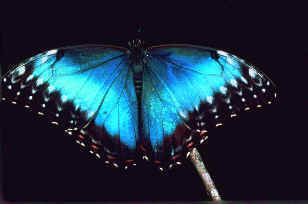
Above & below: Common (or Blue) Morpho
butterflies
Above: the upperwings; below: the underwings
(lower photo by Virginia Woodhouse, during a FONT tour
in Costa Rica in March 2012)
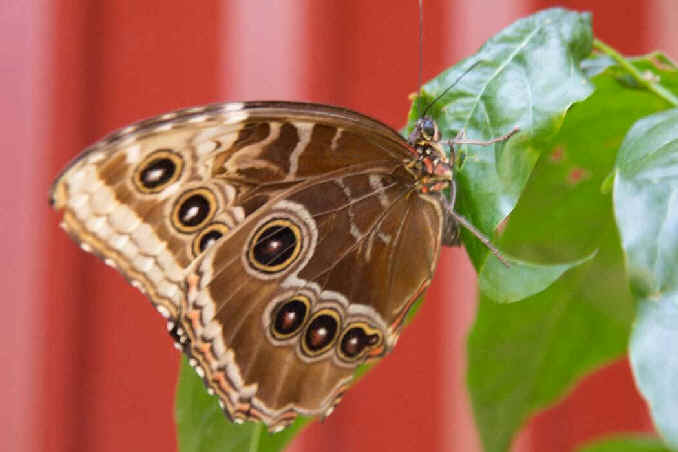
In the two photographs below, a Blue Morpho egg
(photos by Virginia Woodhouse during a FONT tour
in Costa Rica in March 2012)
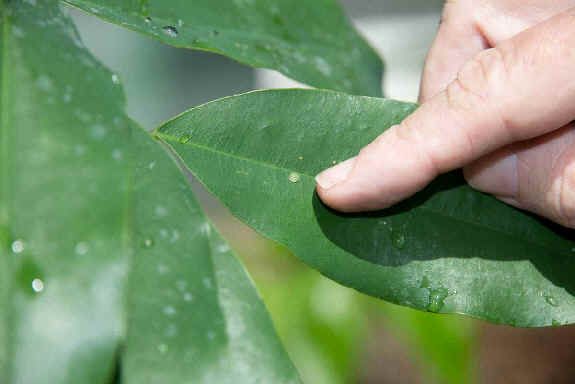

Morpho menelaus ______
CR(*) PN(*)
Morpho menelaus amathonte _____ CR PN(sl) (BMCR:165) (D1:39)
(100BM:34-c)
subspecies from Nicaragua to Panama
MENELAUS MORPHO
In Costa Rica, Morpho menelaus amathonte
occurs only in the rainforest.
Morpho polyphemus ______ CR GU
(100C:8-c)
Morpho polyphemus polyhemus ______ GU (MCA:131)
subspecies from west Mexico to El Salvador
Morpho polyphemus luna _____ GU (MCA:131)
subspecies on east Mexico and Guatemala
Morpho polyphemus catarina _____
CR (D1:39)
subspecies in
Nicaragua and Costa Rica
WHITE MORPHO
(Range: Mexico to Costa Rica)
In Costa Rica, Morpho polyphemus
flies in the cloud-forest canopy in August. This univoltine species has a short
flight season.
Morpho theseus ______ CR(*)
GU PN(*) (100BM:33-c)
Morpho theseus justitae ______ GU subspecies
from southern Mexico to Honduras
Morpho theseus heraldica ______ CR PN(sl)
(D1:39) (MCA:131) subspecies in Costa Rica and Panama
SHORT-TAILED MORPHO
(Range: Mexico to Peru)
Morpho theseus is pale to brown, but not white or bright blue.
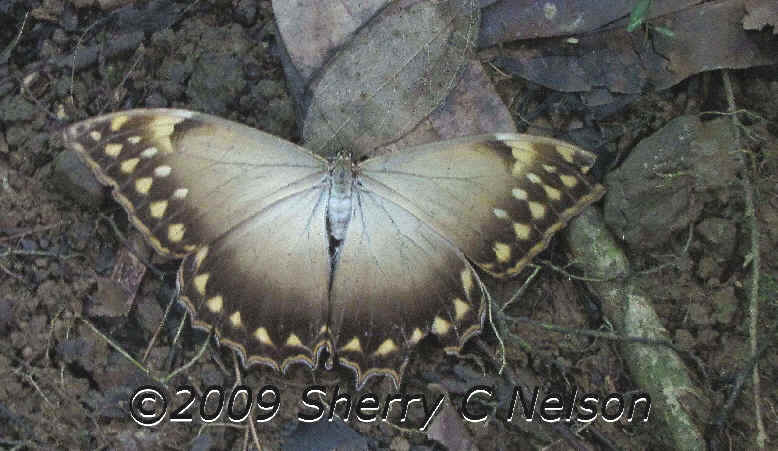
Short-tailed Morpho
(photo by Sherry Nelson)
Morpho cypris ______ CR PN
Morpho cypris aphrodile ______ subspecies in Honduras and
Nicaragua
Morpho cypris bugaba ______ CR PN (BMCR:165) (D1:40)
(F:182) subspecies in Costa Rica and Panama
CYPRIS MORPHO
(Range: Honduras to Colombia)
The sexes of Morpho cypris are completely different. The male (most often seen) is a brilliant
metallic blue, with a WHITE BAND across the wings, and a series of white spots
around the wing. The larger female, that rarely ventures from the rainforest
canopy, is above a rich orange-yellow with a brown margin. The undersides of
both sexes are brown and white.
Genus CAEROIS
Caerois gerdrudtus ______ (D1:40)
(F:127)
BRUSH-FOOTED BUTTERFLY
(Range: Costa Rica to Ecuador)
Caerois gerdrudtus is not common. It lives in the rainforest and breeds in a
palm.
Subfamily SATYRINAE, Tribe
BRASSOLINI
Genus CATOBLEPIA
Catoblepia xanthicles ______ CR
PN
Catoblepia xanthicles xanthicles
______ CR PN(sl) (D1:44)
subspecies in Costa Rica and Panama
XANTHICLES OWL-BUTTERFLY
(Range: Costa Rica to Bolivia)
Catoblepia orgetorix ______ CR
Catoblepia orgetorix championi ______ CR
(BMCR:169)
(C:355) (D1:44) subspecies in Nicaragua
and Costa Rica
ORGETORIX OWL-BUTTERFLY
(Range: Nicaragua to Ecuador)
Genus DYNASTOR
Dynastor darius ______ CR
PN (100C:54-c)
Dynastor darius stygianus ______ CR PN(sl)
(BMCR:169) (D1:41) (MCA:132)
subspecies from south Mexico to west Ecuador
BROMELIAD OWL-BUTTERFLY (or
DARING OWL-BUTTERFLY)
(Range: Mexico to the Amazon Basin)
The caterpillar of Dynastor darius
has what looks like a "snake's-head".
Dynastor macrosiris ______ CR
Dynastor macrosiris strix ______ CR
(MCA:132) subspecies from south Mexico to Costa
Rica
GREEN-EYED OWL BUTTERFLY
Genus NAROPE
In Costa Rica, NAROPE species are among the rarest of nymphalid
butterflies in the country.
Narope testacea ______ (D1:41)
(MCA:132)
BROWN OWL-BUTTERFLY
(Range: Mexico to the Amazon Basin)
Narope
miner ______ GU
SMALL OWL-BUTTERFLY
(Range: southern Mexico and Guatemala)
Narope Janzen01 ______ CR
(100C:35-c)
Genus BRASSOLIS
Brassolis isthmia ______ CR
Brassolis isthmia isthmia ______ CR
(BMCR:168) (D1:41) (MCA:133) subspecies
in Costa Rica
SMALL-HEADED OWLET (or
SMALL-SPOTTED OWL-BUTTERFLY)
(Range: Guatemala to Colombia)
Brassolis granadensis ______ CR
Brassolis granadensis granadensis
______ CR subspecies from northwest Cost Rica to Ecuador on the
Pacific slope
COLOMBIAN OWL-BUTTERFLY
Genus MIELKELLA
Mielkella singularis ______ (MCA:133)
MAYAN OWL-BUTTERFLY
Genus OPSIPHANES: 13 species, all with stout bodies, and thick scaled
wings
Opsiphanes tamarindi ______
CR(*) GU(*) PN(*)
Opsiphanes tamarindi tamarindi ______ CR GU PN
(BMCR:170) (D1:41) (MCA:133)
subspecies from Mexico to Panama
HELICONIA OWLET
(Range: Mexico to the Amazon Basin)
In Costa Rica, Opsiphanes tamarindi is
the most common of its genus. It is often seen eating banana plant leaves
"everywhere" in the country, being common in the rain forest and rare
in the dry forest.
In addition to being at wild bananas, Heliconia
in Heliconiaceae, it is found at gingers,
and at plants in Renealmia in Costaceae
and those in Marantaceae.
Opsiphanes invirae ______ CR
PN
Opsiphanes invirae cuspidatus ______ CR
PN(sl)
(D1:42) (MCA:133) subspecies from Honduras to Costa Rica
LOWLAND OWLET
(Range: Honduras to the Amazon Basin)
Opsiphanes cassina ______ CR
(100BM:35-c)
Opsiphanes cassina chiriquensis ______ CR
(BMCR:170)
(D1:42) a subspecies in Costa Rica
Opsiphanes cassina fabricii ______ (D1:42) (MCA:133)
subspecies from Mexico to Panama
SPLIT-BANDED OWLET
(Range: Mexico to the Amazon Basin)
Opsiphanes quiteria ______ CR
GU PN
Opisphanes quiteria quirinus ______ CR GU PN (D1:42)
(MCA:133)
subspecies from Guatemala to Panama
Opsiphanes quiteria panamensis ______ (D1:42)
SCALLOPED OWLET
(Range: Guatemala to the Amazon Basin)
Opsiphanes bogotanus ______ CR
(100C:12-c)
Opsiphanes bogotanus alajuela ______ CR
(BMCR:170) (D1:43)
subspecies
in Costa Rica
BOGOTA OWL-BUTTERFLY
(Range: Costa Rica to Colombia)
Opsiphanes bogotanus alajuela occurs in cloud forests, from 700 to 1600
meters above sea level.
Opsiphanes cassiae ______ (MCA:133)
LINNEAN OWLET
Opsiphanes boisduvalii ______ (MCA:133)
ORANGE OWLET
Opsiphanes zelotes ______ CR
(100C:11-c)
In Costa Rica, Opsiphanes
zelotes is a very low-density species.
Genus OPOPTEA
Opoptera standingeri ______ CR
(D1:43)
STANDINGER'S OWL-BUTTERFLY
(Range: Costa Rica and western Panama)
Genus SELENOPHANES
Selenophanes josephus ______ GU
PN
Selenophanes josephus josephus ______ GU
(D1:44)
subspecies in Guatemala
Selenophanes josephus excultus ______ PN
subspecies in
eastern Panama and Colombia
JOSEPHUS OWL-BUTTERFLY
(Range: Guatemala, Panama and Colombia)
Genus ERYPHANIS: 6 species with "owl eyes" in Central
and South America. Breeds on
bamboo.
Eryphanis lycomedon ______
CR(*) PN(sl) (BMCR:169)
(D1:44) (ICR:83) (S:158) (formerly
Automedon or
Polyxena lycomedon)
SPLIT-SPOTTED OWL-BUTTERFLY (another name
is PURPLE MORT BLEU)
(Range: Guatemala to southern Brazil)
Eryphanis lycomedon frequents forest clearings in the late
afternoon and at dusk.
It gives the impression of being a Caligo
butterfly, but the small eyespots on the underside of the hindwing are much
smaller.
When at rest, the wings of Eryphanis lycomedon
quickly close, concealing the dorsal surface, and a much more cryptic brownish
ventral surface makes the butterfly hard to spot.
Eryphanis lycomedon is attracted to
rotting fruit in tropical lowlands.
Eryphanis aesacus ______
CR
Eryphanis aesacus buboculua ______ CR
(BMCR:169) (D1:45) (F:150) (MCA:132)
subspecies from Costa Rica to Colombia
DOUBLE-SPOTTED OWL BUTTERFLY
(Range: Mexico to the Amazon Basin)
Eryphanis aesacus occurs in cloud forest.
Genus CALIGO: OWL-BUTTERFLIES
Caligo telamonius
(formerly
memmon) (ph) ______ CR
GU (F:128)
Caligo telamonius memmon ______ CR(*)
GU(*)
(MCA:132) subspecies from south Mexico to Costa Rica
Caligo telamonius menus ______ CR(*)
(BMCR:169) (D:146) subspecies from
Costa Rica to Colombia
YELLOW-FRONTED OWL-BUTTERFLY (other names are Pale Owl
Butterfly and Cream Owl Butterfly)
(Range: Mexico to the Amazon Basin)
With a wingspan of 13cm, Caligo telamonius is among the largest
butterflies in the world. It is crepuscular, and it lives in agricultural
areas, and breeds on Heliconia species and the related banana.
In Costa Rica, Caligo telamonius is
better adapted to drier habitats and agricultural lands than Caligo
brasiliensis sulanus (following, in this list) which is
more associated with rainforest environments.
Caligo telamonius memmon is common
in the dry forests of Guanacaste in northwest Costa
Rica.
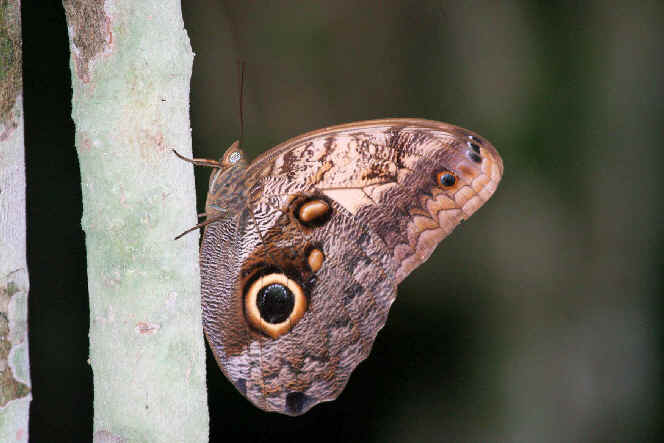
A Yellow-fronted Owl-Butterfly photographed during a
FONT Tour
in Guatemala
(photo by Marie Gardner)
Caligo brasiliensis ______ CR
GU PN
Caligo brasiliensis sulanus ______ CR(*) GU
PN(sl)
(BMCR:168) (D1:45) (ICR:80c) (MCA:132)
subspecies from southern Mexico to Panama - in Costa Rica and otherwise in
tropical lowland forests, sea level to 3,600 feet
ALMOND-EYED OWL-BUTTERFLY (other names are
BRAZILIAN OWL-BUTTERFLY or
Dark Owl-Butterfly, or Magnificent Owl)
(Range: Mexico to Brazil)
Caligo brasiliensis avoids bright sunlight. It flies in the late
afternoon and at dusk, and is attracted to fermenting fruit.
Caligo illioneus ______
Caligo illioneus oberon ______ CR
(BMCR:168)
(D1:46)
subspecies in Costa Rica and Panama
DUSKY OWL-BUTTERFLY (another name is
Illioneus Giant Owl)
(Range: Costa Rica to Argentina)
Caligo atreus ______ CR
PN (100BM:36-c)
Caligo atreus dionysos (ph) ______ CR(*)
PN (BMCR:168) (D1:46)
subspecies in Costa
Rica and Panama
YELLOW-EDGED GIANT-OWL (another name is Banded Owl-Butterfly)
(Range: Mexico to Peru)
Caligo atreus is distinguished from
other Caligo species by its having a
bold, pale diagonal bar across its wings.
In Costa Rica, Caligo atreus dionysos
occurs in lowland rainforest environments, and along forest, river, and wetland
edges with Heliconia plants and in
the vicinity of banana plantations.
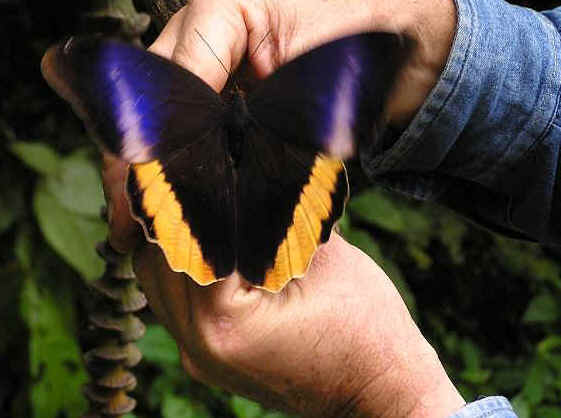
Yellow-edged Giant-Owl
Caligo oedipus ______
CR
Caligo oedipus fruhstorferi
______ (MCA:132) subspecies from
southern Mexico to Honduras
Caligo oedipus oedipus ______ CR
(BMCR:168)
subspecies from Costa Rica to Colombia
BOOMERANG OWL-BUTTERFLY (another
name is Fruhstorfer's Owl-Butterfly)
Caligo uranus ______
(MCA:132)
YELLOW-BORDERED
OWL-BUTTERFLY (or Gold-edged Owl-Butterfly)
(Range: southern Mexico to
Honduras)
Caligo oileus ______ CR
GU PN
Caligo oileus scamander ______ CR
GU PN
subspecies
from Guatemala to Panama
OILEUS
OWL-BUTTERFLY
Subfamily SATYRINAE:
SATYRS & WOOD NYMPHS
- the
RINGLETS
a large group represented strongly
in Central & South
America
Subfamily
SATYRINAE, Tribe HAETERINI
Genus CITHAERIAS
Cithaerias pireta
(or menander) ______ CR
(D1:47) (ICR:84)
Cithaerias pireta pireta ______ CR
subspecies from Guatemala to
Colombia
RUSTED CLEARWING-SATYR
(or Pink-tipped Satyr)
The wings of Cithaerias pireta
are transparent. Thus it blends into its surroundings when it lands. The
hindwing of the butterfly has a rosy pink hue and a small "eyespot".
This attractive butterfly, occurring from sea level to 6,000 feet, is itself
attracted to rotting fruit and fungi.
Genus HAETERA
Haetera macleannania ______ PN
(BMCR:174) (D1:47)
REDDISH CLEARWING-SATYR
(Range: Costa Rica to western Ecuador)
Genus DULCEDO
Dulcedo polita ______
(BMCR:174) (D1:47)
UNCOLORED CLEARWING-SATYR
(Range: Nicaragua to Colombia)
Genus PIERELLA
Pierella helvina (or
helvetia) ______ CR PN (100BM:100-c)
Pierella helvina incanescens ______ CR PN (BMCR:176) (D1:47) subspecies
from Guatemala to Panama
Pierella helvina ocreata ______ subspecies in Panama and northwest
Colombia
RED-WASHED SATYR
(Range: Mexico to Colombia)
Pierella luna ______
(MCA:134)
Pierella luna rubecula ______ subspecies from Mexico to Honduras
Pierella luna pallida ______ subspecies
in Honduras and Nicaragua
Pierella luna luna ______ (D1:47)
subspecies from Nicaragua to
Colombia
MOON SATYR (or
Quiet Diaph)
(Range: Mexico to Colombia)
Subfamily SATYRINAE, Tribe
MELANTINI
Genus MANATARIA
Manataria hercyna ______
Manataria hercyna maculata ______ (BMCR:175) (D1:47)
(MCA:134) subspecies from Mexico to Colombia
WHITE-SPOTTED SATYR
(Range: Mexico to Brazil)
Subfamily SATYRINAE,
Tribe SATYRINI
Genus HERMEUPTYCHIA
Hermeuptychia harmonia (or
calixta) ______
(BMCR:174)
HARMONIA SATYR
(Range: Costa Rica to western Ecuador)
Hermeuptychia hermes ______
(BMCR:174)
HERMES SATYR
(Range: south Texas to Argentina)
Genus ORESSINOMA
Oressinoma typhla (ph) ______
(BMCR:175) (D1:47)
TYPHLA SATYR
(Range: Costa Rica to Bolivia)
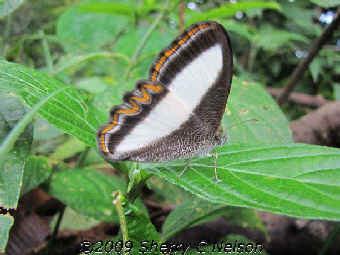
Typhla Satyr
(photo by Sherry Nelson)
Genus CYLLOPSIS
Cyllopsis gemma ______ (MCA:137)
Cyllopsis gemma freemani ______ BZ GU
subspecies
from south Texas to Guatemala and Belize, subspecies described in 1947
FREENMAN'S GEMMED SATYR (or simply
Gemmed-Satyr)
Cyllopsis wellingi
______ BZ (species described in 1978)
BELIZE GEMMED-SATYR
Cyllopsis wellingi
is endemic to the Maya Mountains in Belize.
Cyllopsis hedemanni ______ (MCA:136)
Cyllopsis hedemanni hedemanni ______ (D1:47)
subspecies from Mexico to Panama; other subsp. in Mexico
STUB-TAILED GEMMED-SATYR (or Tailed Gemmed-Satyr)
(Range: Mexico to Panama)
Cyllopsis rogersi ______ (BMCR:174)
(D1:47)
COSTA RICAN GEMMED-SATYR
(Range: Costa Rica and Panama)
Cyllopsis philodice ______ (D1:47)
PALE-BANDED GEMMED-SATYR
(Range: Costa Rica and western Panama)
Cyllopsis nelsoni ______
YELLOW-STRIPED GEMMED-SATYR
(Range: locally in Guatemala: Cerro de Zunil)
Cyllopsis argentella ______ (D1:47)
OCHRE-PATCHED GEMMED-SATYR
(Range: Costa Rica and western Panama)
Cyllopsis steinhauserorum ______ GU
(MCA:136)
(species described in 1974)
STEINHAUSER'S GEMMED-SATYR (or
Cloud-forest Gemmed-Satyr)
(Range: western Mexico to El Salvador)
Cyllopsis guatemalena ______
GU (MCA:136) (species described in 1974)
GUATEMALAN GEMMED-SATYR
(Range: southern Mexico and Guatemala)
Cyllopsis schausi ______ GU
(species described in 1974)
SCHAUS' GEMMED-SATYR
(Range: western Mexico to Guatemala)
Cyllopsis pallens ______ GU
(MCA:136)
(species described in 1974)
PALLID GEMMED-SATYR
(Range: western Mexico to Guatemala)
Cyllopsis suivalenoides ______
GU (MCA:136)
(species described in 1974)
BIG-EYED GEMMED-SATYR
(Range: western Mexico to Nicaragua)
Cyllopsis suivalens ______ GU
(MCA:137) (species described in 1974)
Cyllopsis sulvalens escalantei ______ GU
subspecies in southern Mexico and Guatemala
DYAR'S GEMMED-SATYR
Cyllopsis pyracmon ______ GU
(MCA:137)
Cyllopsis pyracmon pyracmon ______ GU
subspecies in
central and southern Mexico and Guatemala
NABOKOV'S SATYR
Cyllopsis pephredo ______ (D1:47)
(MCA:137)
BLUE-SPIKED GEMMED-SATYR
(Range: Mexico to Panama)
Cyllopsis hilaria ______
(MCA:137)
TWO-TONED GEMMED-SATYR (or Patchy Gemmed-Satyr)
(Range: eastern Mexico to western Panama)
Genus TAYGETIS:
About 27 species of BROWNS in Central & South America.
With brown or gray upperparts, and with false eyes on the underside. Mostly,
they prefer shaded rainforest understory.
Taygetis inconspicua ______ GU
INCONSPICUOUS SATYR
(Range: southeastern Mexico and Guatemala)
Taygetis uncinata ______ GU
(MCA:135)
HOOK-LINED SATYR (or
Hook-lined Ur-Satyr)
(Range: Mexico and Guatemala)
Taygetis mermeria ______
(MCA:135)
Taygetis mermeria excavata ______
(D1:47)
subspecies from Mexico to
Panama
GREAT SATYR (or
Great Ur-Satyr)
(Range: Mexico to Bolivia & Brazil)
Taygetis virgilia ______ (MCA:135)
STUB-TAILED SATYR (or
Cramer's Ur-Satyr)
(Range: Mexico to Brazil)
Taygetis rufomarginata ______
PN(sl) (D1:47) (was a subspecies of Taygetis
virgilia)
RUFOUS-MARGINED SATYR
(Range: Honduras, Costa Rica, Panama)
Taygetis sosis ______ (D1:47)
(MCA:135)
(was Taygetis xenana godmani)
SOSIS SATYR (or Chocolate Ur-Satyr)
(Range: southern Mexico to the Amazon Basin, in Peru and Brazil)
Taygetis kerea ______ (D1:47)
(MCA:140)
KEREA SATYR (or Little Ur-Satyr)
(Range: Mexico to Paraguay and Argentina)
Taygetis laura ______
LAURA'S SATYR
(Range: Panama to Bolivia)
Taygetis leuctra ______
LEUCTRA SATYR
(Range: southern Mexico to Panama)
Taygetis andromeda ______ CR
(D1:48)
(Range: Mexico thru Central & South America)
Taygetis sylvia ______
SYLVIA'S SATYR
(Range: Panama to Bolivia)
Taygetis thamyra ______
(MCA:135)
THAMYRA SATYR (or Common Ur-Satyr)
(Range: eastern Mexico to southern Brazil)
Taygetis uzza
(or salvini) ______
(MCA:135)
UZZA SATYR (or Deep-forest Ur-Satyr)
(Range: Guatemala to Colombia)
Genus TAYGETINA
Taygetina banghaasi
______ CR (DV1:50)
(was Taygetis banghaasi)
BANG HAAS' SATYR
(Range: Costa Rica to Bolivia)
Genus TAYGETOMORPHA genus created in 2004
Taygetomorpha celia
______ PN(sl) (D1:47)
CELIA SATYR
(Range: Nicaragua to Bolivia and Brazil)
Genus PSEUDODEBIS
Pseudodebis zimri
______ (D1:48) (MCA:135) (was Tagetis
zimri)
BUTLER'S SATYR (or Variable Satyr)
(or Variable Satyr)
(Range: southeast Mexico to Colombia)
In this list (below), Cissia palladia
is also called BUTLER'S SATYR.
Genus PARATAYGETIS
Parataygetis lineata
(ph) ______ (D1:48) (was Taygetis lineata)
WHITE-LINED SATYR
(Range: Costa Rica to Ecuador)
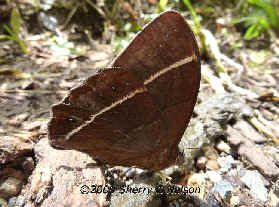
White-lined Satyr
(photo by Sherry Nelson)
Genus POSTTAYGETIS
Posttaygetis penelea
______ (D1:48) (was Taygetis
penelea)
YELLOW-SPIKED SATYR
(Range: Costa Rica to Brazil)
Genus MAGNEUPTYCHIA
Magneuptychia libye
______ (D1:48) (MCA:140) (was
Cissia libye) (species described by Linnaeus in 1767)
BLUE-GRAY SATYR
(Range: southeast Mexico to the Amazon basin)
Magneuptychia tiessa
______ (D1:48) (was Cissia
tiessa)
TIESSA SATYR
(Range: Nicaragua to western Ecuador)
Magneuptychia alcinoe ______ PN(sl)
(D1:41) (MCA:140) (was Cissia alcinoe)
SIMPLE SATYR
(Range: southern Mexico to Bolivia)
Magneuptychia agnata
______ CR (D1:48)
(was Cissia agnata)
AGNATA SATYR
(Range: Costa Rica, on the Caribbean slope)
Magneuptychia drymo
______ CR (D1:48)
(was Cissia
drymo)
DRYMO SATYR
(Range: Costa Rica, on the Caribbean slope)
Magneuptychia gomezi
______ CR (DV1:48) (was Cissia
gomezi)
GOMEZ' SATYR
(Range: Costa Rica)
Genus MEGEUPTYCHIA
Megeuptychia antonoe ______ PN(sl)
(DV1:48)(MCA:140)
CRAMER'S SATYR (or
Canopy Satyr)
(Range: Mexico to Amazon Basin)
Genus EUPTYCHIA
Euptychia fetna
______ GU (MCA:138)
ORANGE-PATCHED SATYR (or Spiky Satyr)
(Range: western and southern Mexico and Guatemala)
Euptychia westwoodi ______
(D1:48) (MCA:138)
WESTWOOD'S SATYR
(Range: southern Mexico to Venezuela)
Euptychia jesia ______ (D1:48)
(MCA:138)
JESIA SATYR (or
Transgressive Satyr)
(Range: southern Mexico to Colombia)
Euptychia mollina ______
MOLLINA SATYR
(Range: eastern Mexico to Venezuela)
Euptychia mollis ______ (D1:48)
MOLLIS SATYR
(Range: Belize to Panama)
Euptychia hilara ______ (D1:48)
(MCA:138)
TAWNY-CORNERED SATYR
(or
Orange-corned Satyr)
(Range: southern Mexico to Colombia)
Euptychia insolata ______ PN(sl)
(D1:48)
INSOLATA SATYR
(Range: Costa Rica and Panama)
Genus FORSTERINARIA
Forsterinaria neonympha
______ (MCA:140)
WHITE-DOTTED SATYR
(Range: southern Mexico to western Ecuador)
Alternate scientific names for Forsterinaria neonympha
have been (are): F.
umbracea, F. polyphemus, F. cyclops.
Genus CISSIA: Butterflies in this genus were formerly all placed in EUPTYCHIA
Some of the taxa listed with this genus are no longer valid (those without
English common names). They will be deleted.
Cissia calixta ______ (D1:41)
(Range: Costa Rica to Ecuador)
Cissia hermes ______ (D1:41)
(Range: Mexico thru the American tropics)
Cissia polyphemus ______ (D1:41)
(Range: Costa Rica to Ecuador)
Cissia similis ______
(D1:48) (MCA:139)
ONE-PUPIL SATYR (or
Stormy Satyr)
(Range: western Mexico to Colombia)
Cissia themis (or
undina)
______ (MCA:139)
TWO-PUPIL SATYR (or
Nicaraguan Satyr)
(Range: Mexico to Nicaragua)
Cissia pompilia
(or
usitata) ______ PN(sl)
(D1:48) (MCA:139)
PLAIN SATYR
(Range: Mexico to Colombia)
Cissia confusa ______ (BMCR:173)
(D1:48) (MCA:138)
CONFUSED SATYR
(Range: southeast Mexico to Brazil)
Cissia pseudoconfusa ______ (BMCR:173)
(D1:48) (MCA:138)
GOLD-STAINED SATYR
(Range: eastern Mexico to Panama)
Cissia labe ______ (BMCR:173)
(D1:48) (MCA:138)
LABE SATYR (or
Rusty-spotted Satyr)
(Range: southern Mexico to western Ecuador)
Cissia palladia ______ (D1:48)
(MCA:138)
BUTLER'S SATYR
(Range: southern Mexico to Brazil, also Trinidad)
Cissia joyceae ______ CR
(D1:48)
JOYCE'S SATYR
(Range: Costa Rica)
Cissia terrestris ______ PN(sl)
(D1:48) (MCA:139)
CRYPTIC SATYR (or
Terrestrial Satyr)
(Range: eastern Mexico to Brazil)
Cissia metaleuca ______ (D1:48)
(Range: Mexico to Brazil)
Cissia hesione ______ (D1:48)
(Range: Mexico to Ecuador)
Genus YPHTHIMOIDES
Yphthimoides renata
______ (D1:48) (was Cissia
renata)
RENATA SATYR
(Range: Mexico to Ecuador)
Genus SPLENDEUPTYCHIA
Splendeuptychia salvini ______ PN(sl)
SALVIN'S SATYR
(Range: Panama)
Genus CEPHEUPTYCHIA
Cepheuptychia glaucina
______ (MCA:139)
DIRTY-BLUE SATYR (or Mexican Blue-Satyr)
(Range: southeast Mexico and Guatemala)
Cepheuptychia sericeella
______
BLUE-TOPPED SATYR
(Range: southern Mexico and Guatemala)
Cepheuptychia
amaca ______
BLUE-SMUDGED SATYR
(Range: Guatemala to Colombia)
Genus PAREUPTYCHIA
Pareuptychia metaleuca
______ (MCA:138)
WHITE-BANDED SATYR
(Range: Mexico to Panama)
Pareuptychia ocirrhoe
(or hesione) (ph) ______
(MCA:138)
WHITE SATYR (or TWO-BANDED SATYR,
or BANDED WHITE RINGLET)
(Range: Mexico to Ecuador)
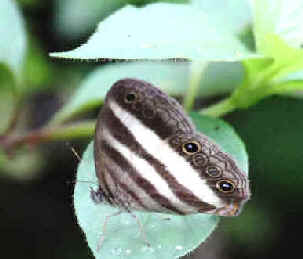
The White, or Two-banded Satyr, photographed during a FONT tour
(photo by Marie Gardner)
Genus HARJESIA
Harjesia oreba
(or guinare) ______ (D1:48)
(was Cissia guinare)
OREBA SATYR
(Range: Costa Rica to Ecuador)
Genus PINDUS
Pindus squamistriga
______ GU (MCA:140)
VARIABLE SATYR (or Falcate Satyr)
(Range: Mexico and Guatemala)
Genus SATYROTAYGETIS
Satyrotaygetis satyrina (or
gigas) ______ CR
(D1:48) (MCA:140) (was Cissia satyrina, or
Cissia gigas)
WIDE-BORDERED SATYR
(Range: southern Mexico to Panama)
Genus CHLOREUPTYCHIA
Chloreuptychia arnaea ______ PN(sl)
(D1:48)
(Range: Mexico to Colombia)
Genus DRUCINA
Drucina championi
______ GU
BLUE-SPOTTED SATYR
(Range: southern Mexico and Guatemala)
Drucina leonata ______ (D1:49)
(F:144)
LEONATA SATYR
(Range: Costa Rica and Panama)
Drucina leonata occurs in cloud forest.
Genus ERETRIS
Eretris maria
______ GU (MCA:140)
MARIA'S SATYR
(Range: southern Mexico and Guatemala)
Eretris hulda ______ (D1:49)
HULDA SATYR
(Range: Costa Rica and Panama)
Eretris suzannae ______ (D1:49)
(species described in 1980)
SUZANNE'S SATYR
(Range: Costa Rica and western Panama)
Genus LYMANOPODA
Lymanopoda cinna
______ GU (MCA:134)
BLUE-STAINED SATYR (or Zig-zag Lyman)
(or Zig-zag Lyman)
(Range: southern Mexico and Guatemala)
Lymanopoda euopis
______ CR
COSTA RICAN SATYR
(Range: Costa Rica)
Genus AMPHIDECTA
Amphidecta pignerator
______
Amphidecta pignerator pignerator ______
STUB-TAILED SATYR
(Range: southern Mexico to the Amazon basin)
In this list (above), Taygetis virgilia
is also called STUB-TAILED
SATYR.
Amphidecta calliomma
______
CALLIOMMA SATYR
(Range: Panama and Colombia)
Genus ARHUACO
Archuaco dryadina
______ CR
DRYADINA SATYR
(Range: Costa Rica & western Panama)
Genus PEDALIODES
Pedaliodes circumducta
______ GU (MCA:134)
CIRCUMDUCTA SATYR (or Mexican Pedalio)
(or Mexican Pedalio)
(Range: southeast Mexico, Guatemala)
Pedaliodes napaea
______ GU (MCA:134)
NAPAEA SATYR (or Guatemalan Pedalio)
(or Guatemalan Pedalio)
(Range: southern Mexico and Guatemala)
Pedaliodes perperna ______
(D1:49)
(Range: Costa Rica to Venezuela)
Pedaliodes dejecta ______
(D1:49) (MCA:134)
DEJECTED SATYR (or
Dejected Pedalio)
(Range: Mexico to Colombia)
Pedaliodes manis ______ (D1:49)
MANIS SATYR
(Range: Costa Rica to Venezuela)
Pedaliodes cremera ______ CR
(D1:49) (was Pedaliodes ereba cremera)
CREMERA SATYR
(Range: Costa Rica and Panama)
Pedalioces triaria ______ (D1:49)
OCHRE-BANDED SATYR
(Range: Costa Rica and Panama)
Genus PRAEPRONOPHILA
Praepronophila petronius ______ (was Pedaliodes
petronius)
Praepronophila petronius kerrianna ______ CR
subspecies in
Costa Rica and Panama
TOOTHED SATYR
Praepronophila perperna ______ CR
RUSTY-EYED SATYR
(Range: Costa Rica and Panama)
Genus PRONOPHILA
Pronophila timanthes
______
TIMANTHES SATYR
(Range: Costa Rica to western Ecuador)
Genus PSEUDOMANIOLA
Pseudomaniola gigas
______ GU (MCA:134)
ORANGE-BORDERED SATYR
(Range: southern Mexico and Guatemala)
Pseudomaniola phaselis
______
Pseudomaniola phaselis rogersi ______ CR
subspecies in Costa
Rica and western Panama
FIRE-SPOTTED SATYR
Genus OXEOSACHISTUS
Oxeosachistus tauropolis
______ (D1:49) (MCA:134)
(formerly Dioriste tauropolis)
YELLOW-PATCHED SATYR (or Starred Oxeo)
(Range: eastern Mexico to Panama)
Oxeosachistus hilaria ______ (MCA:134)
Oxeosachistus hilaria hilaria ______ GU
subspecies in
southern Mexico and Guatemala
Oxeosachistus hilaria euriphyle ______
(BMCR:175) (D1:50) subspecies in Costa
Rica and Panama
DOT-BANDED SATYR (or
Dot-banded Oxeo)
Oxeosachistus puerta ______
Oxeosachistus puerta submaculatus ______ CR
(BMCR:176) (D1:50)
subspecies
in Costa Rica and Panama
PUERTA SATYR
(Range: Costa Rica to Colombia)
Oxeosachistus crothonides ______ CR (D1:49)
(formerly Dioriste crothonides)
RUST-PATCHED SATYR
(Range: Costa Rica and Panama)
Oxeosachistus cothon ______ CR (D1:49)
(formerly Dioriste cothon)
LEMON-PATCHED SATYR
(Range: Costa Rica and western Panama)
To
Top of Page




























































































